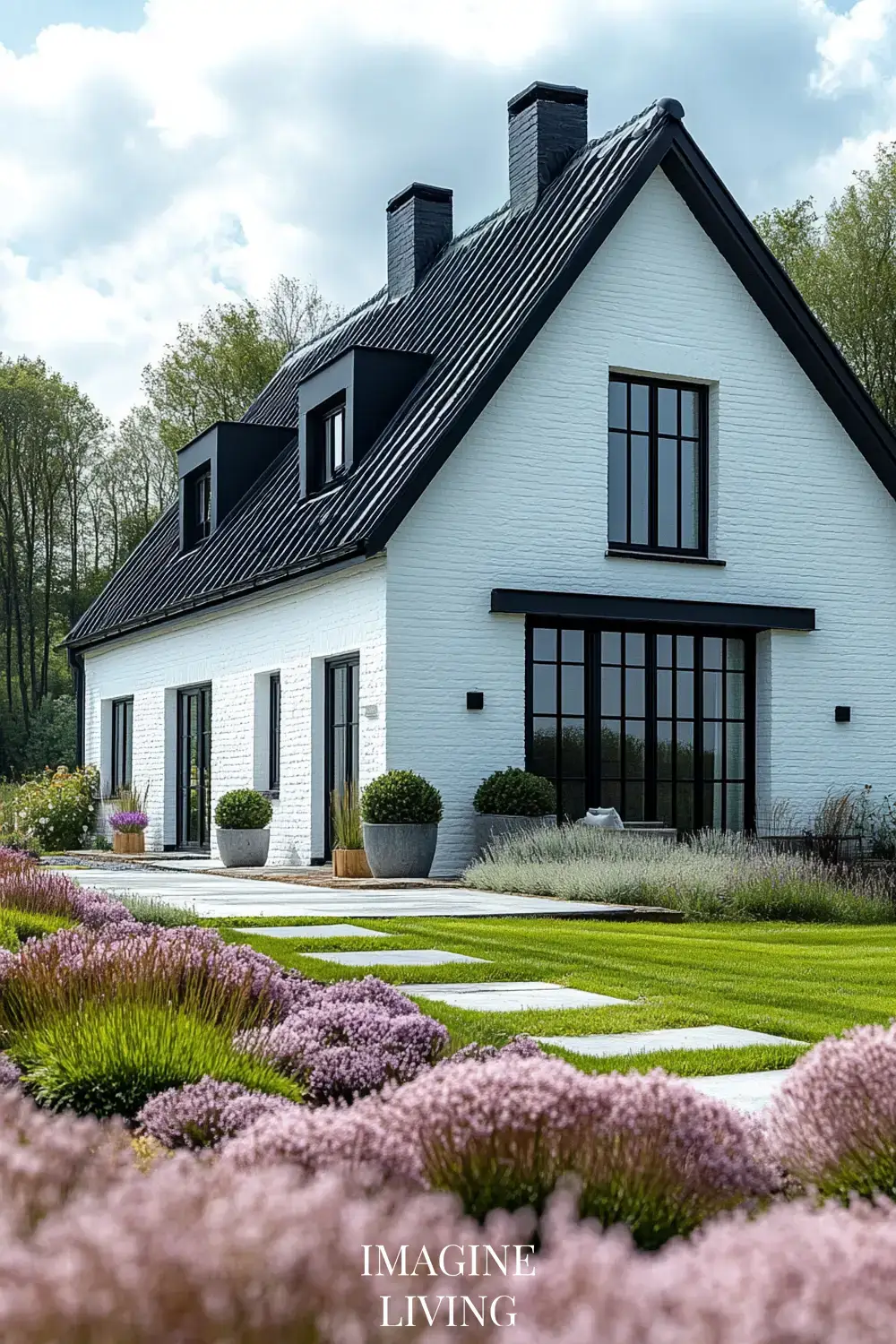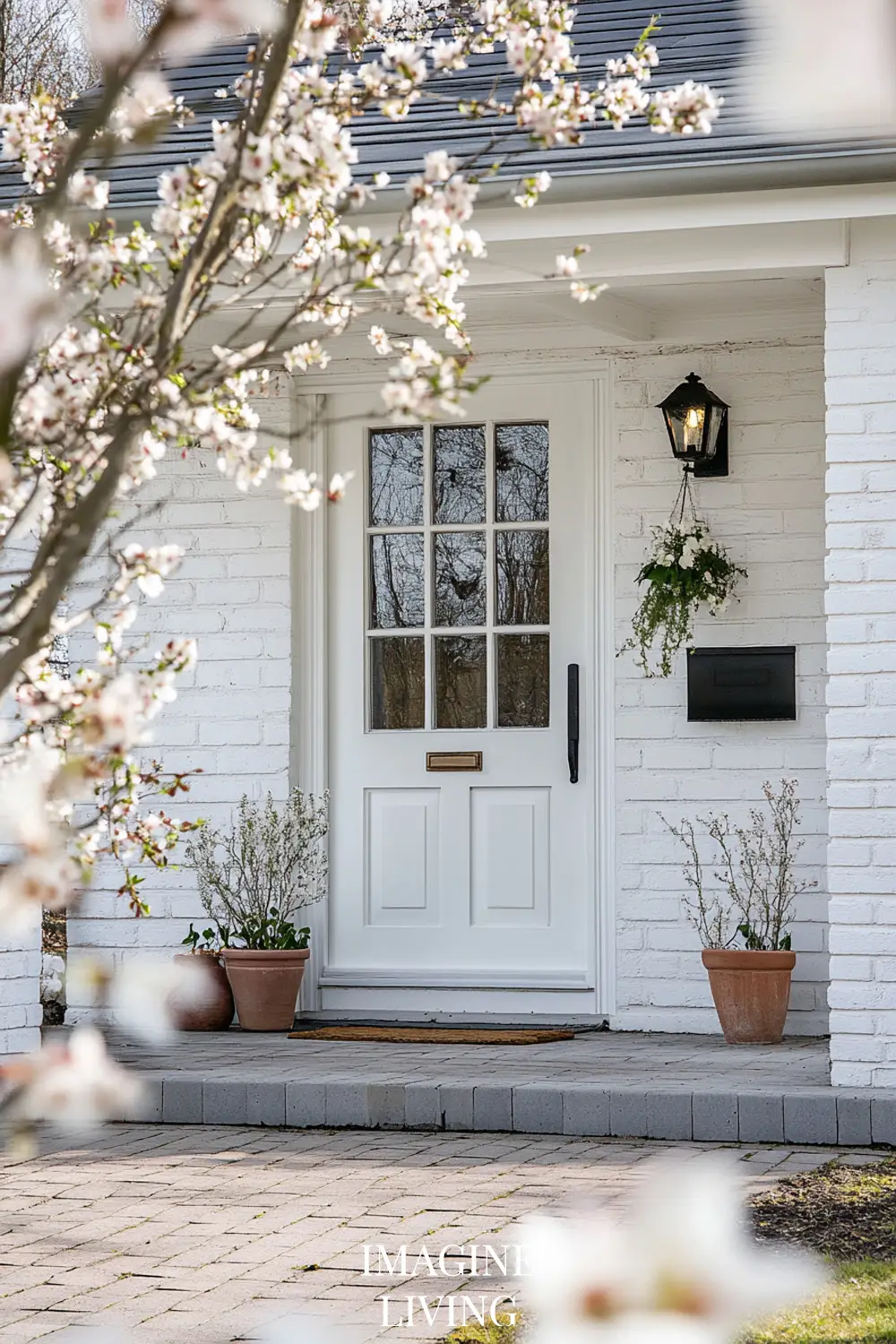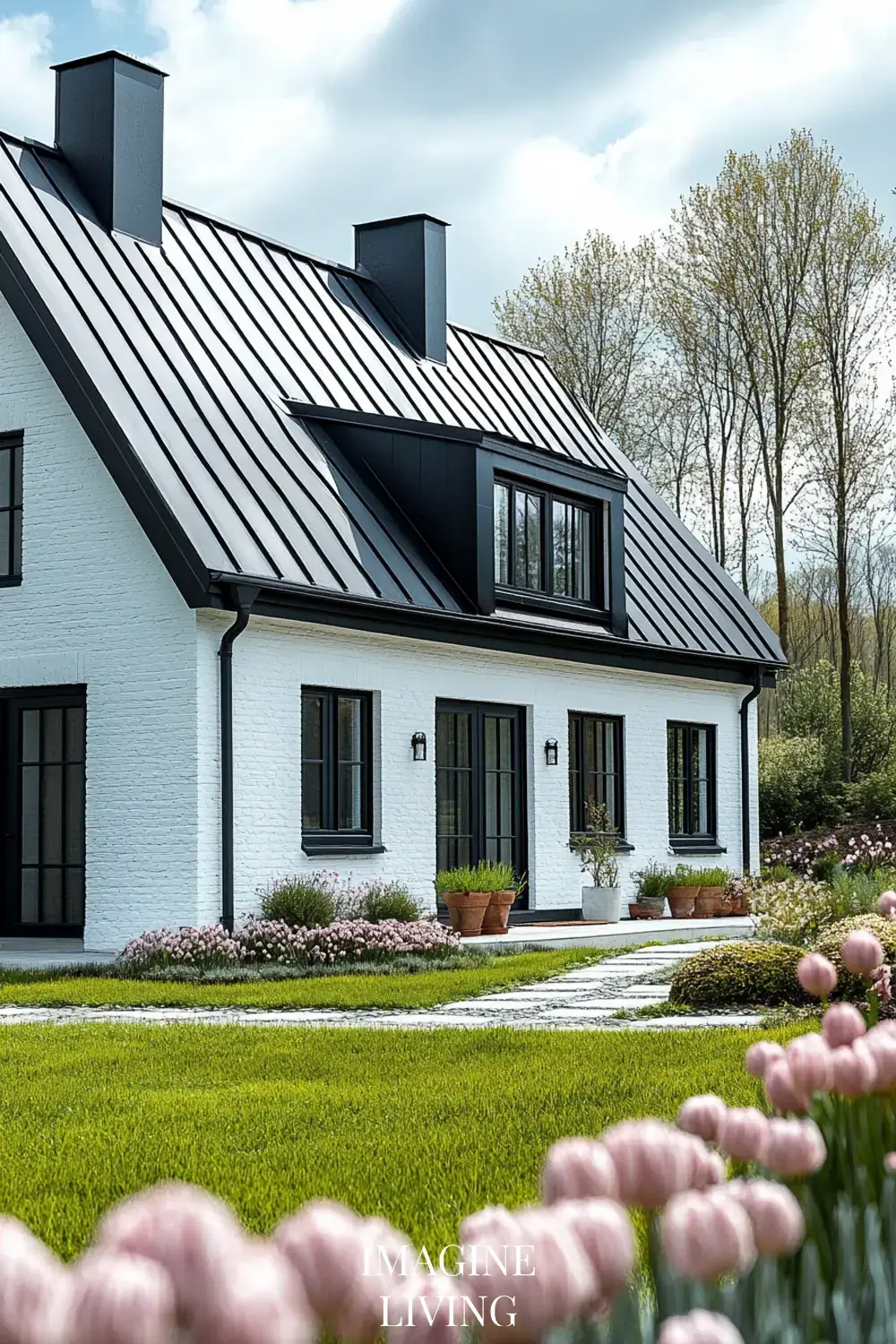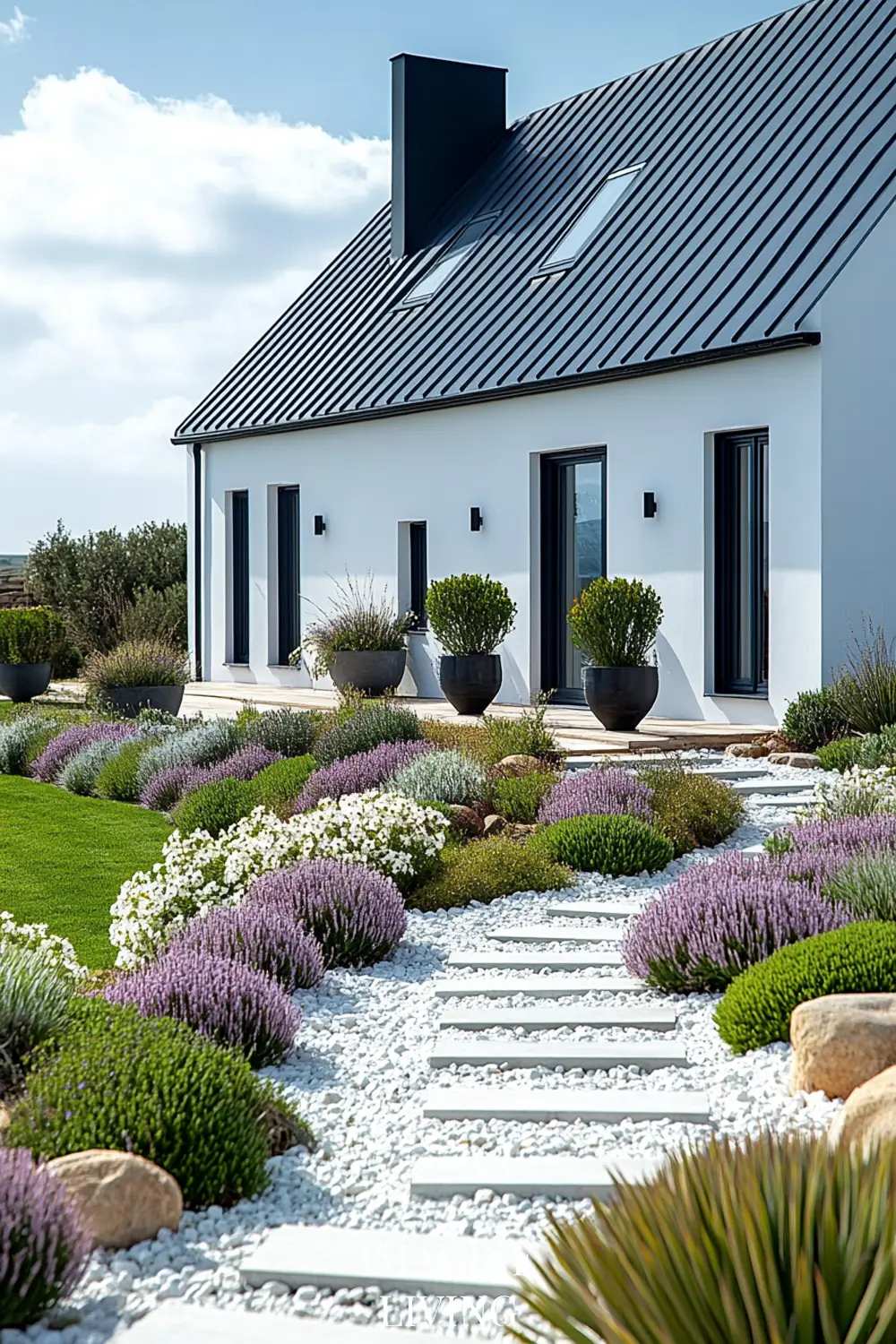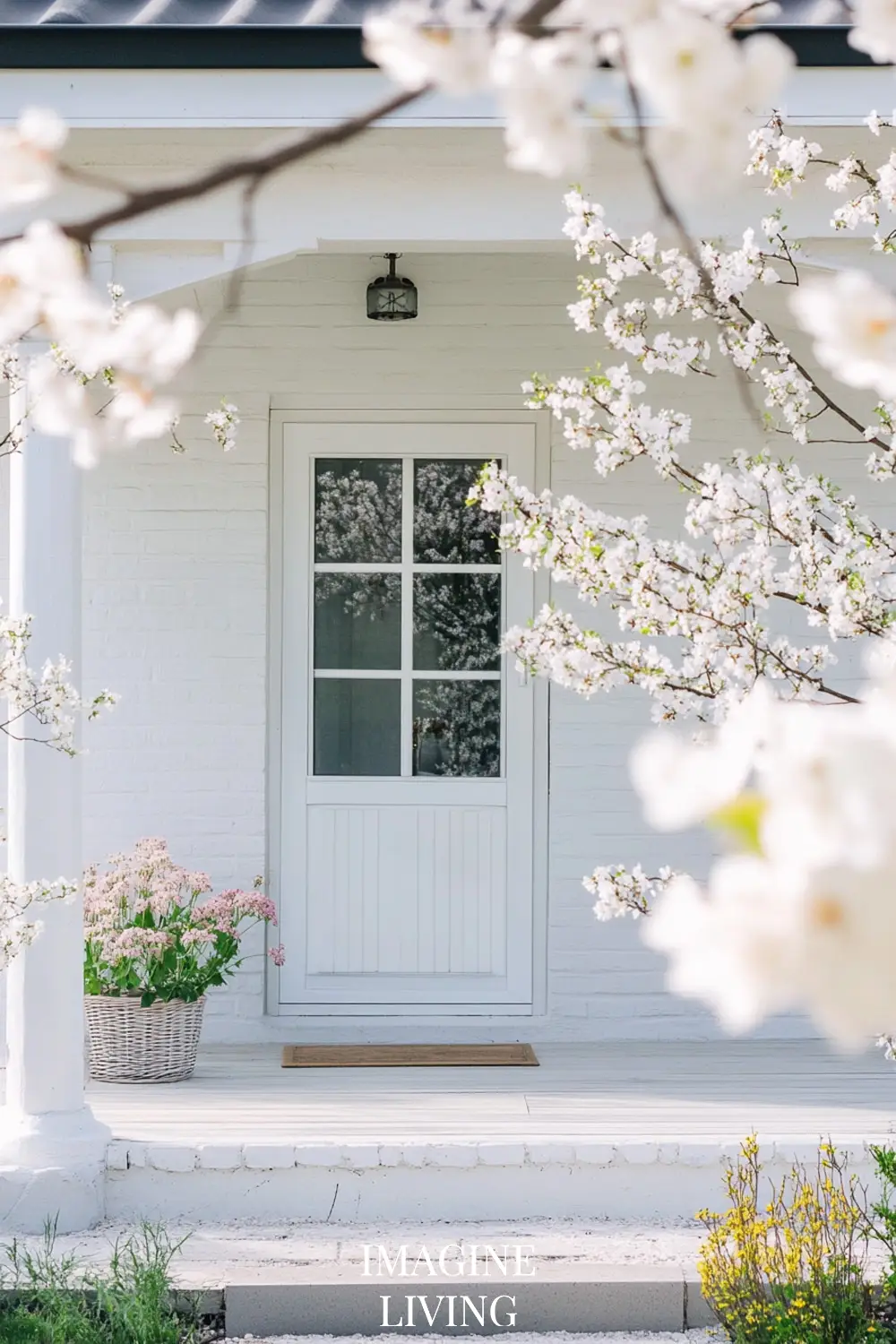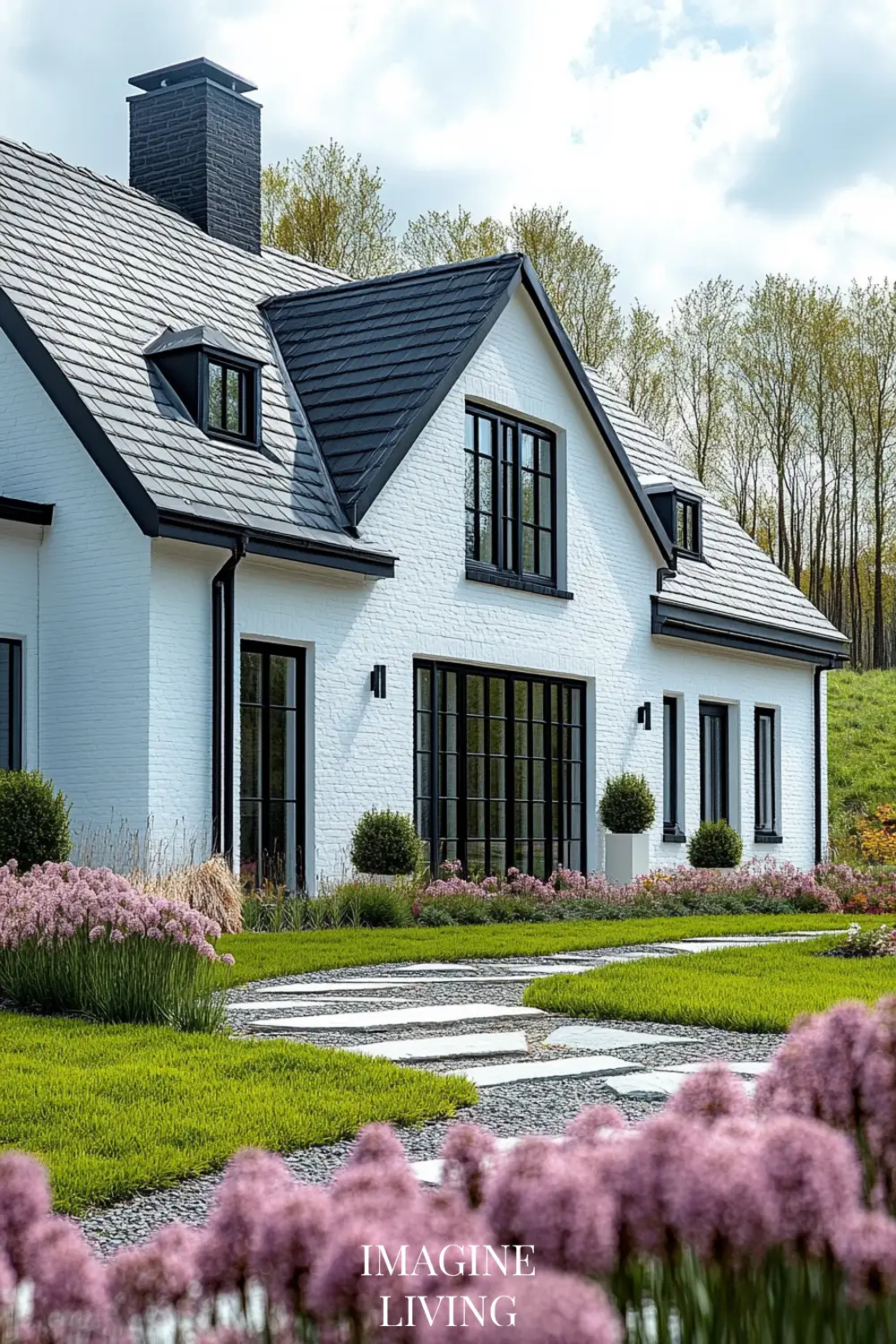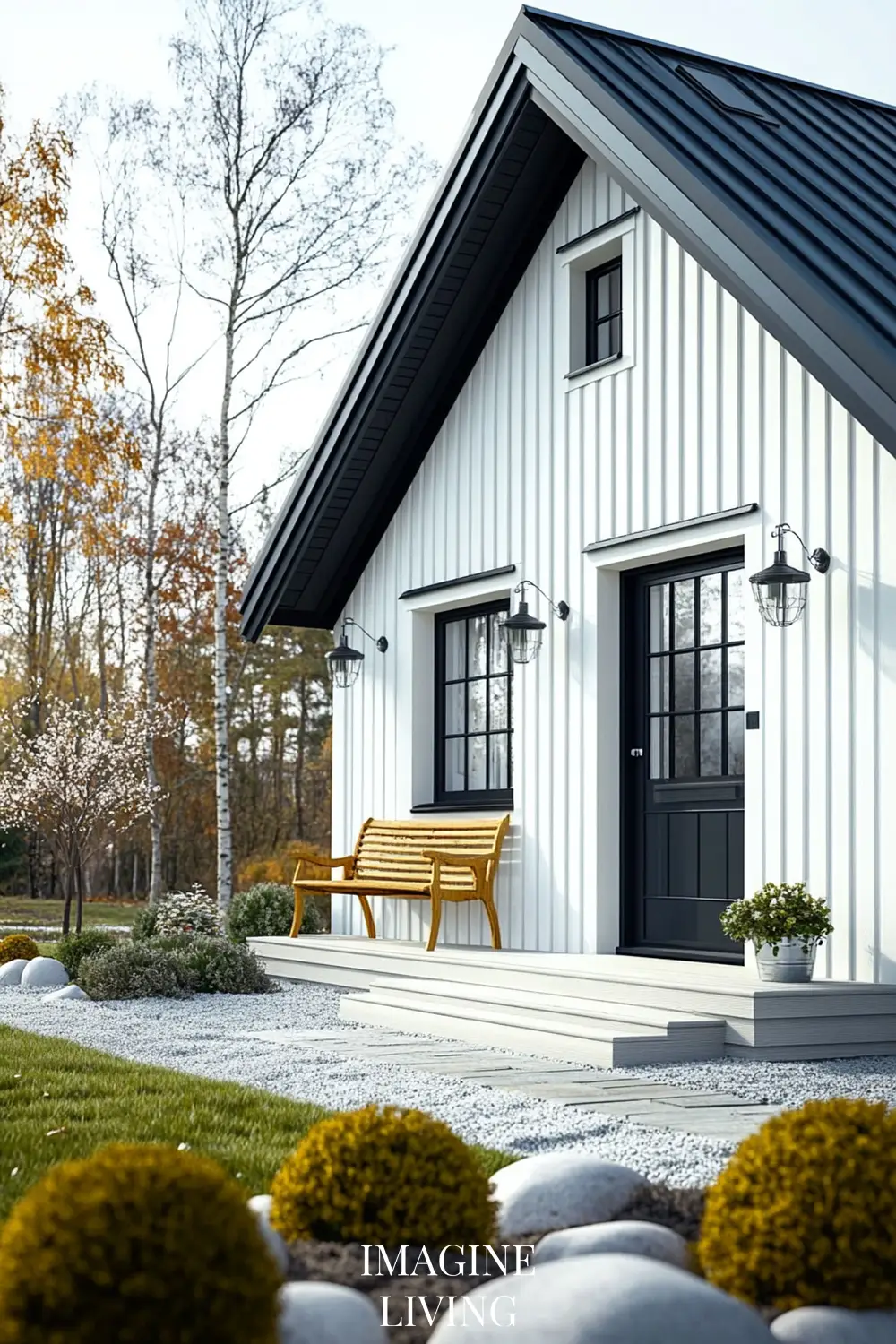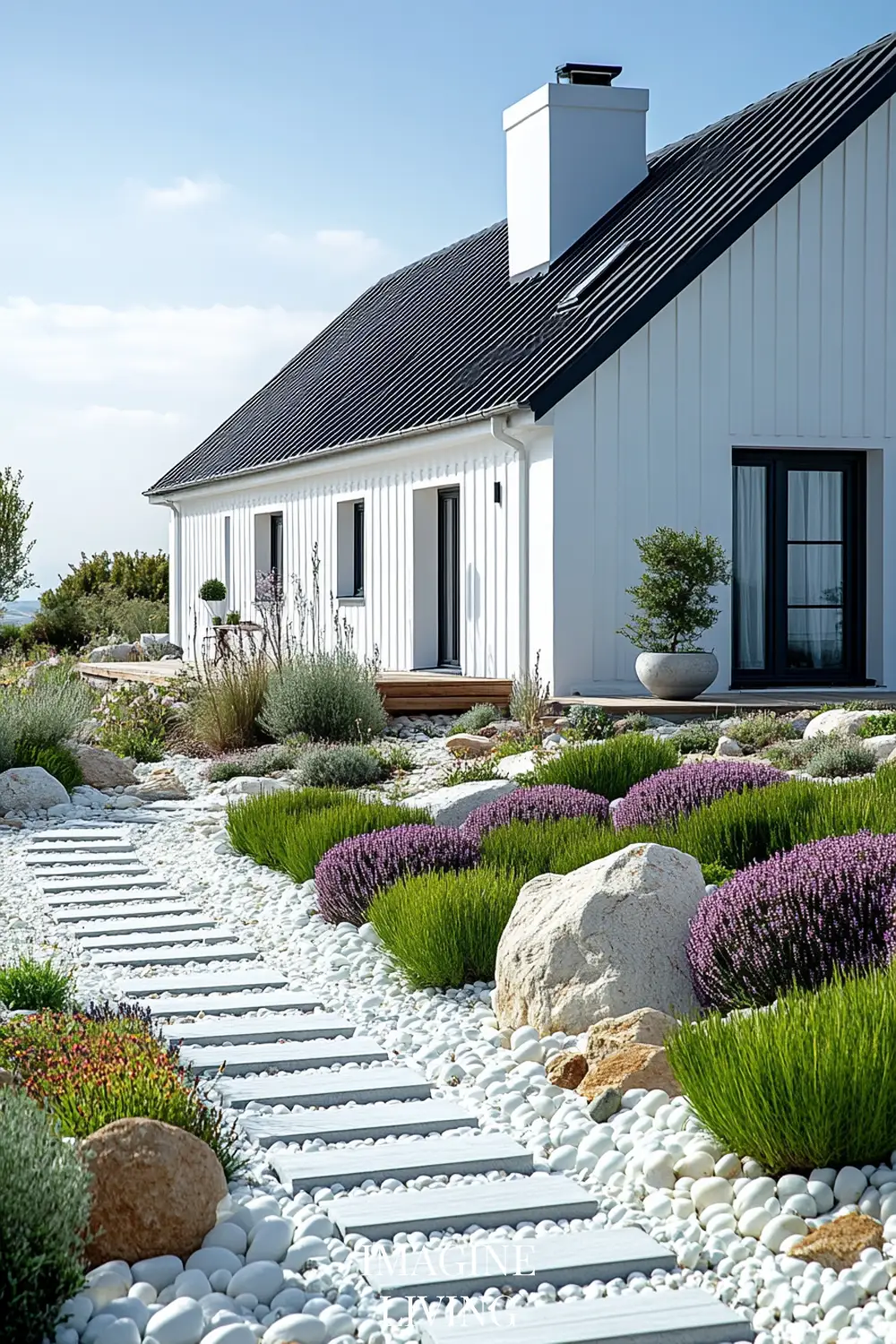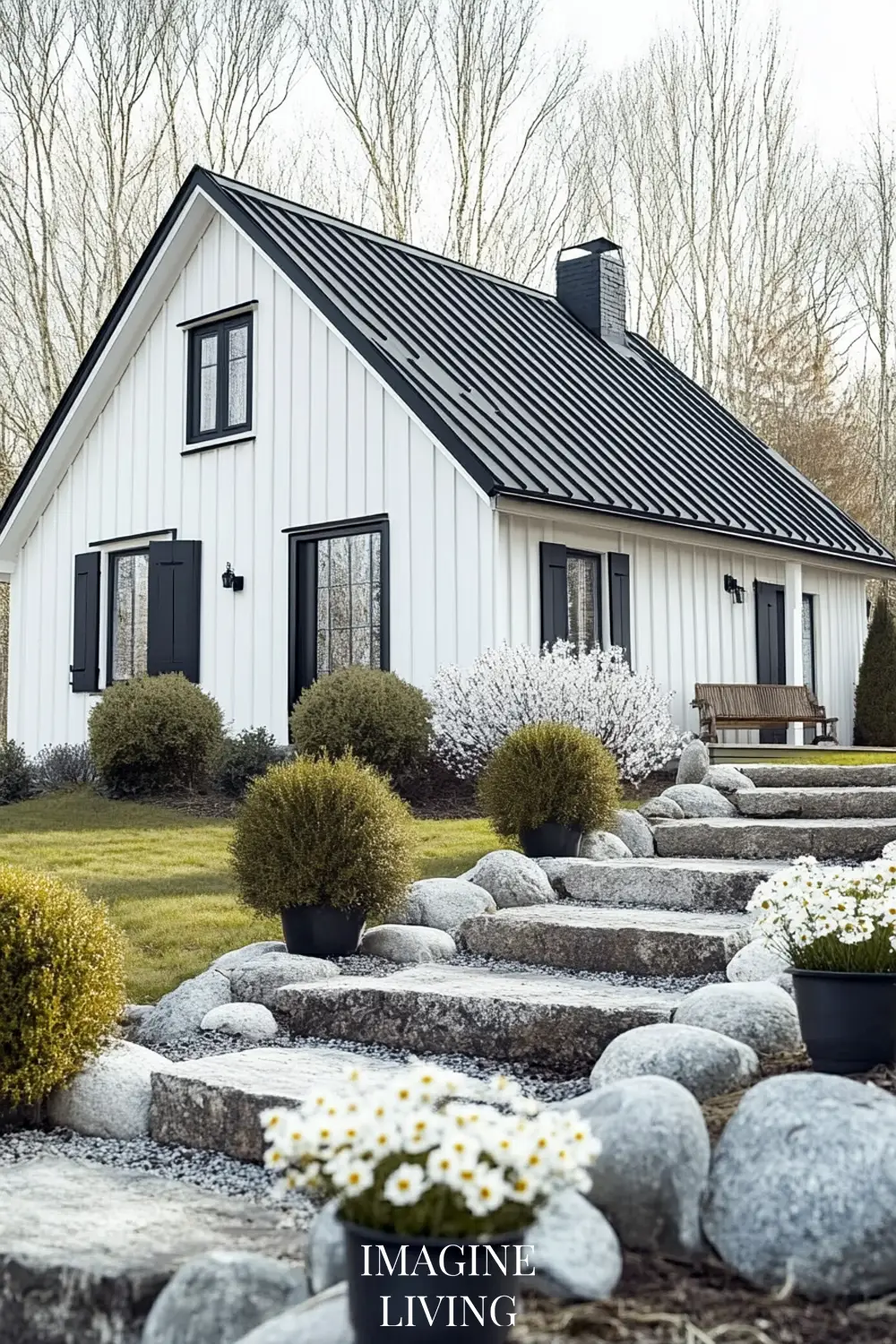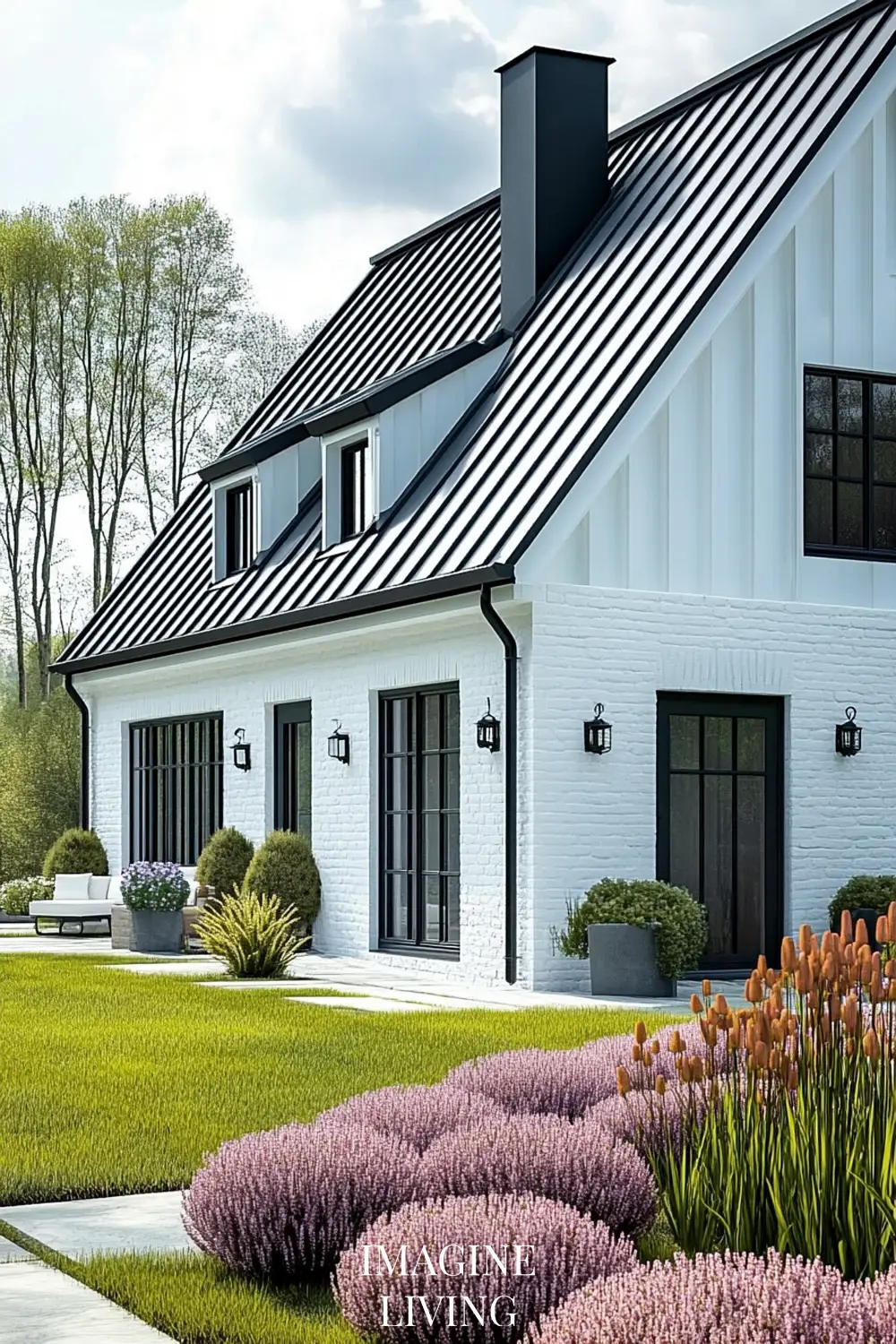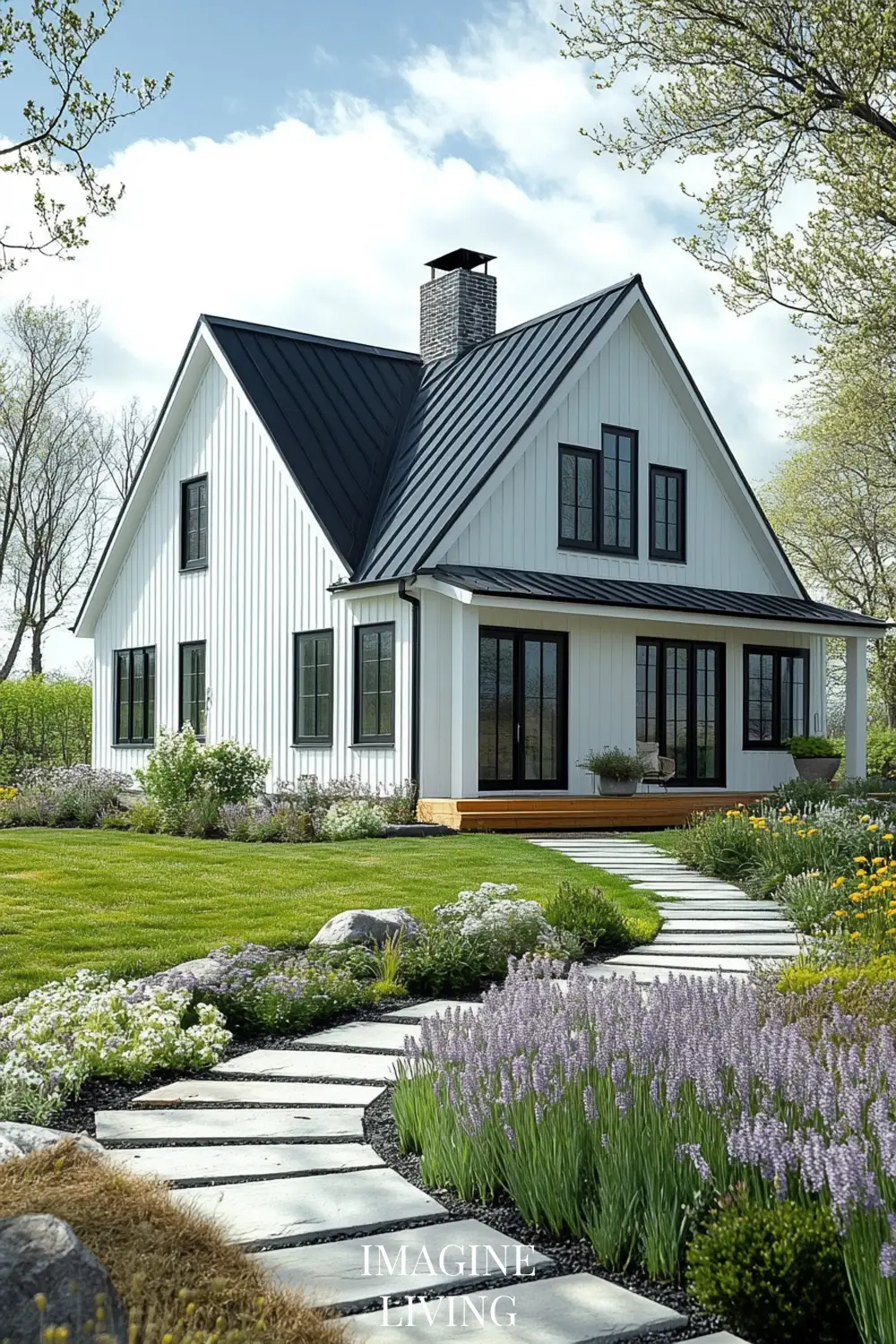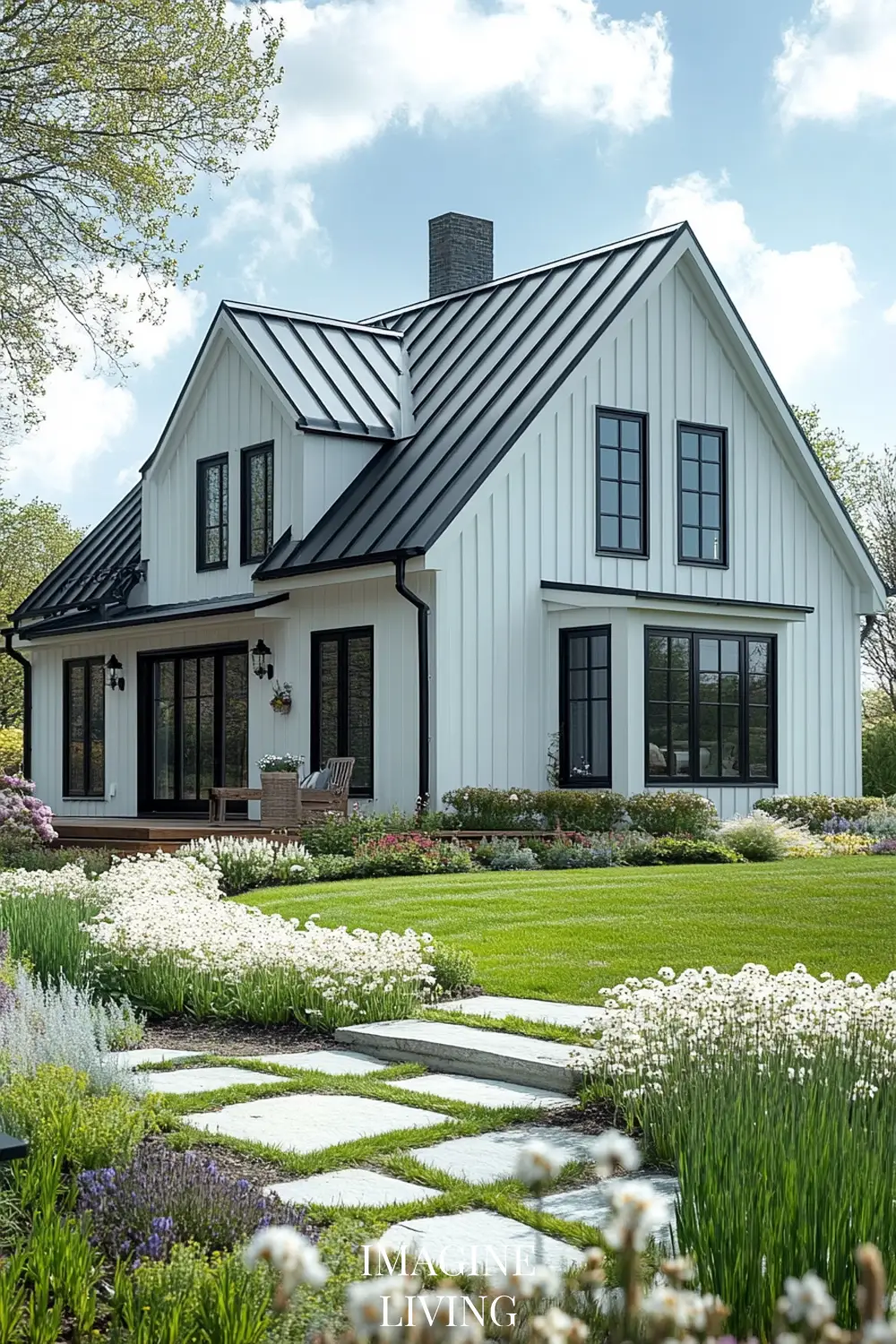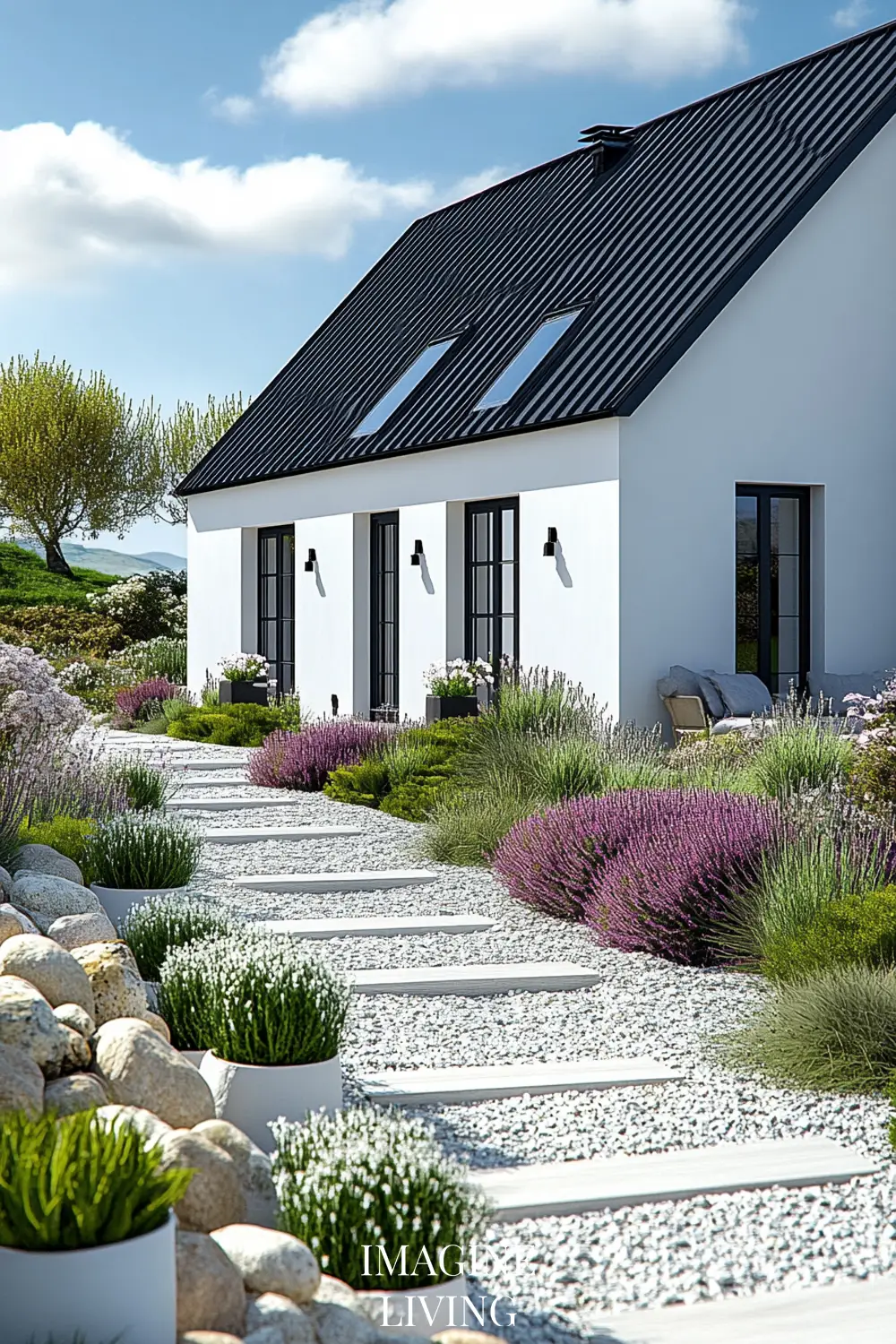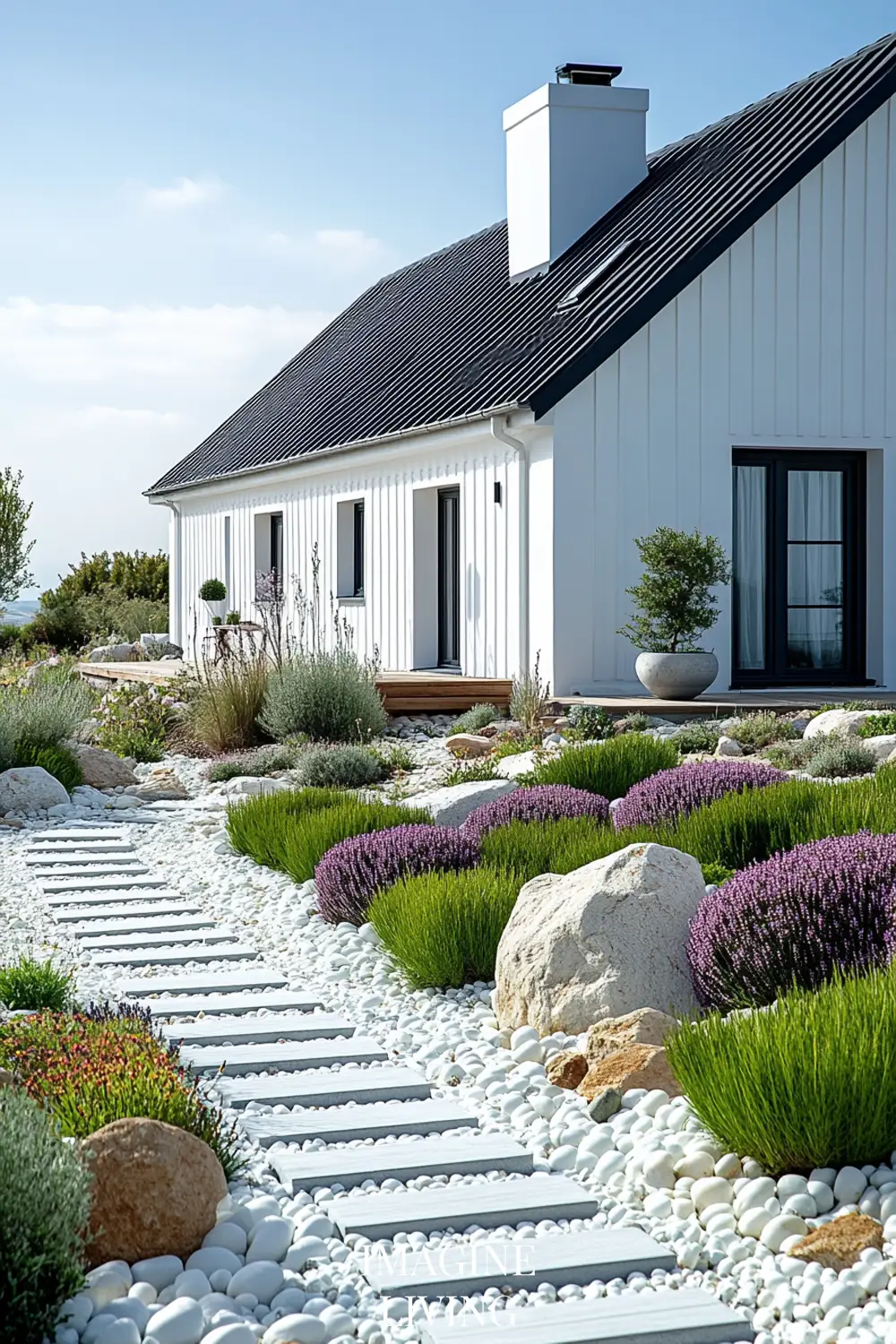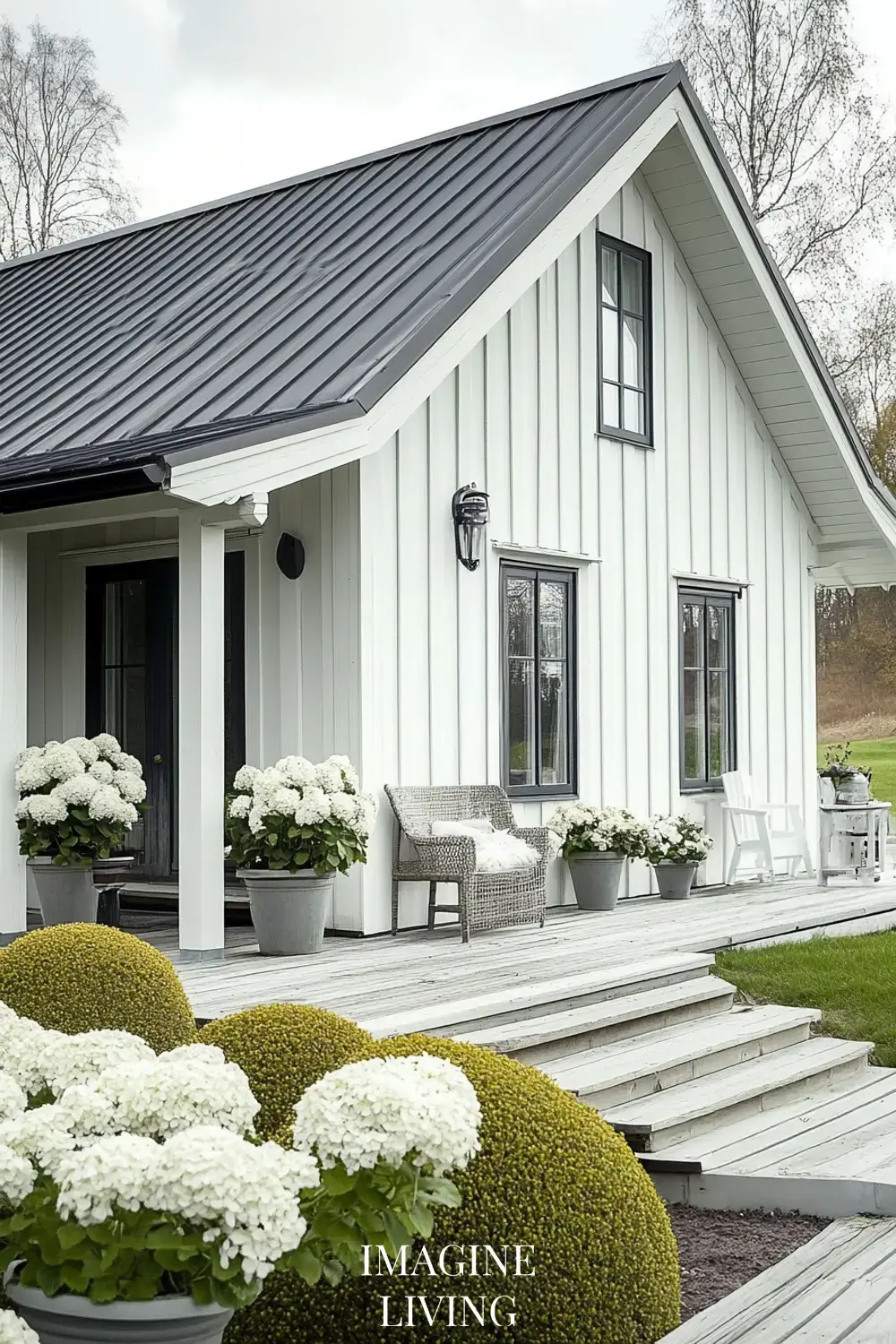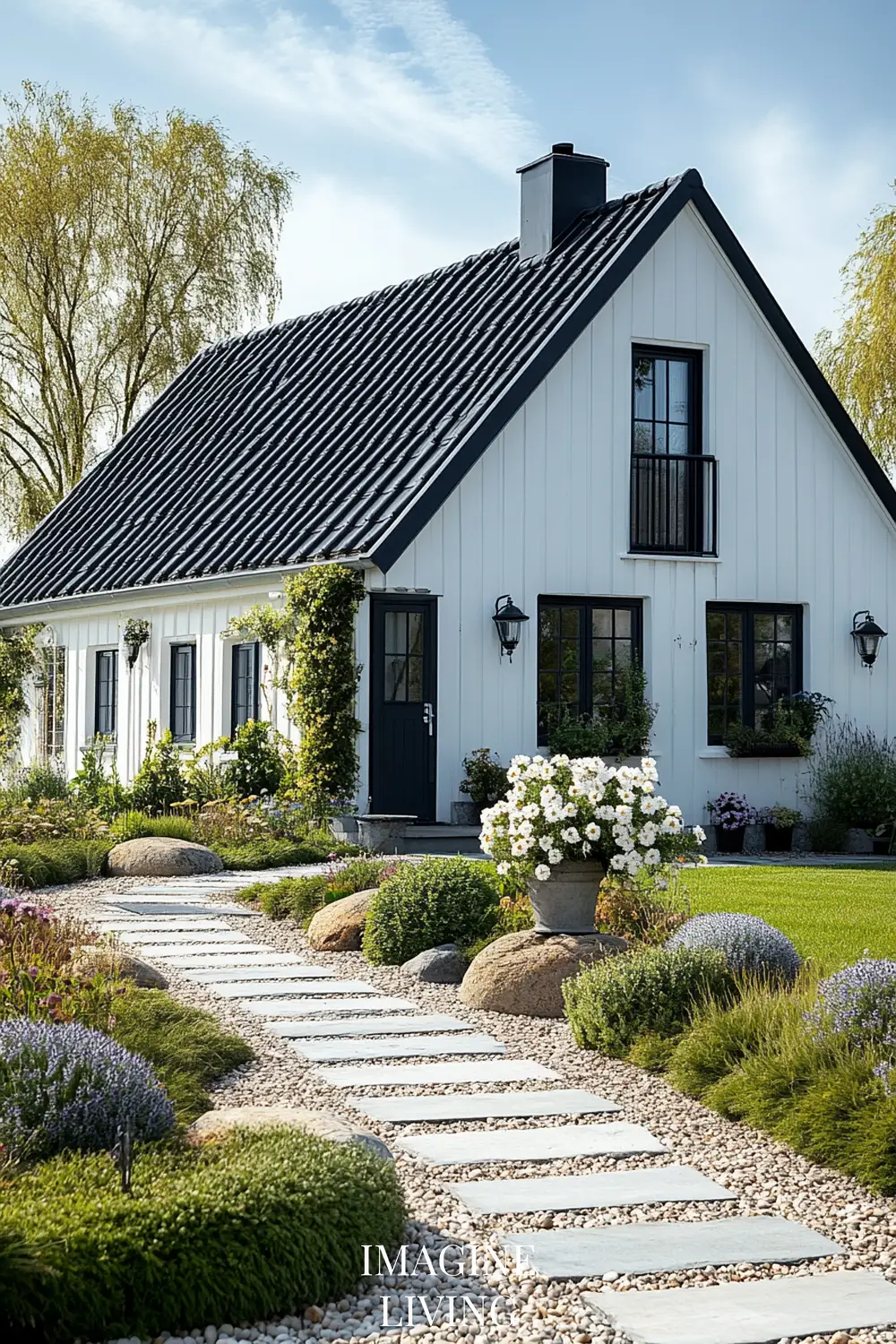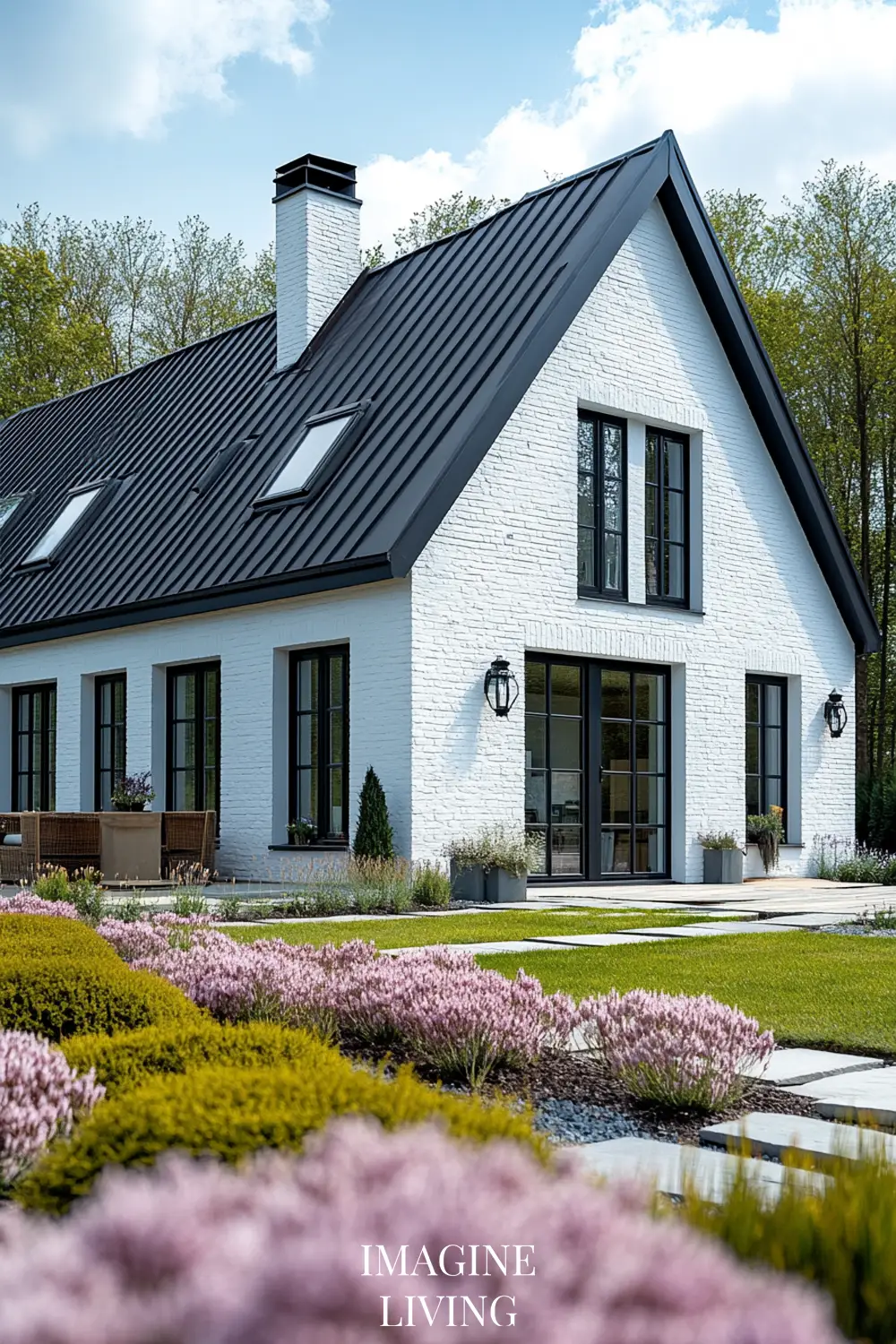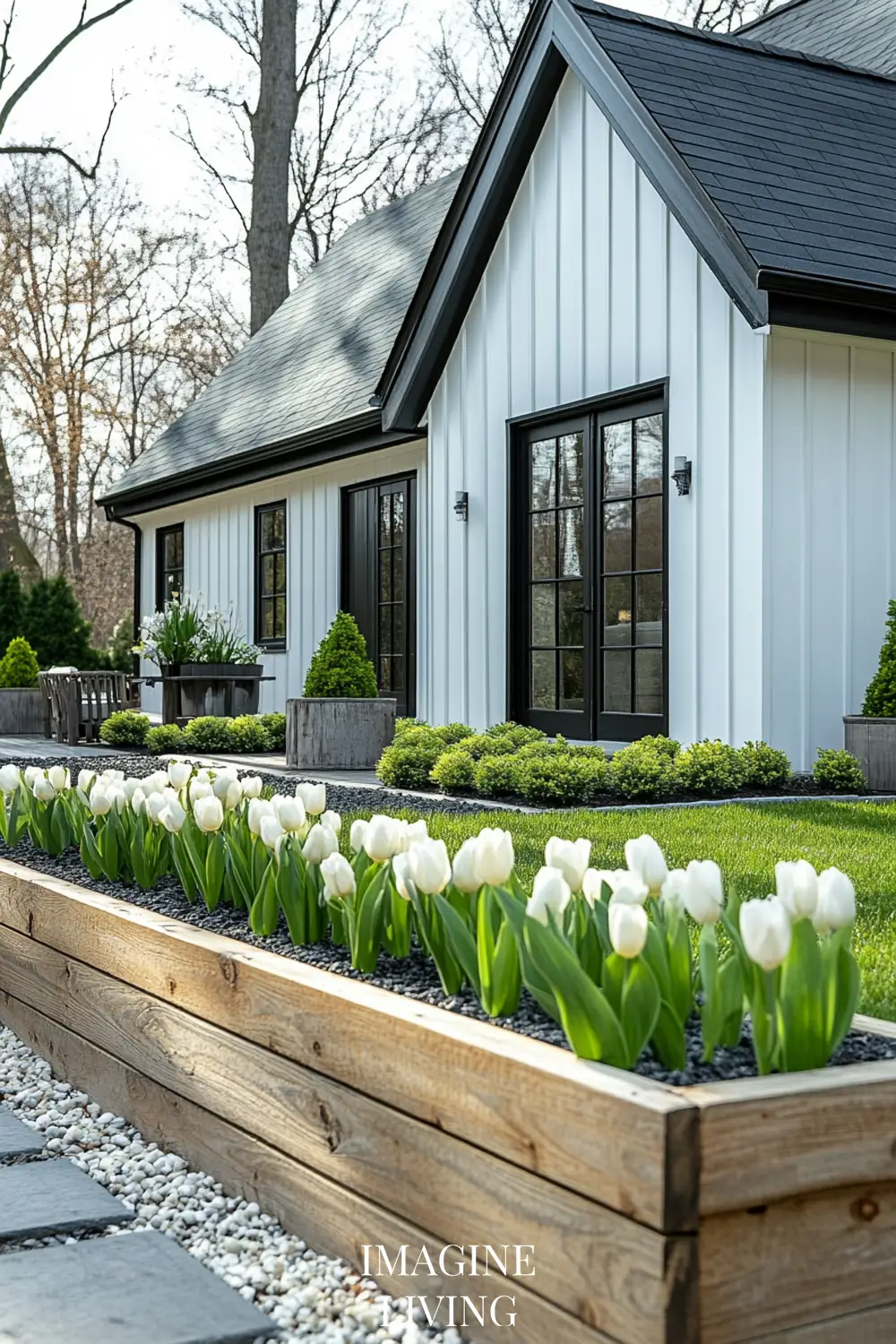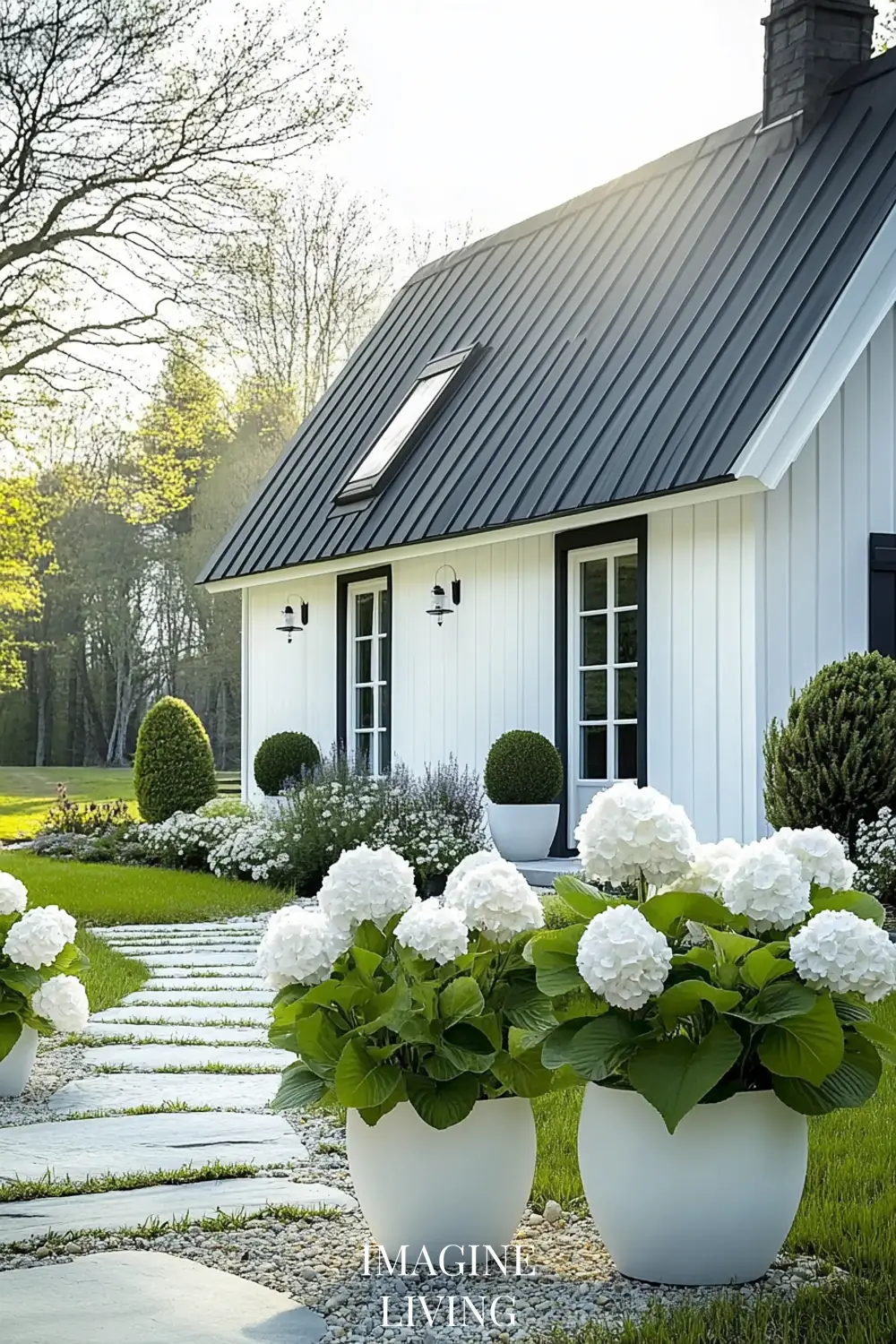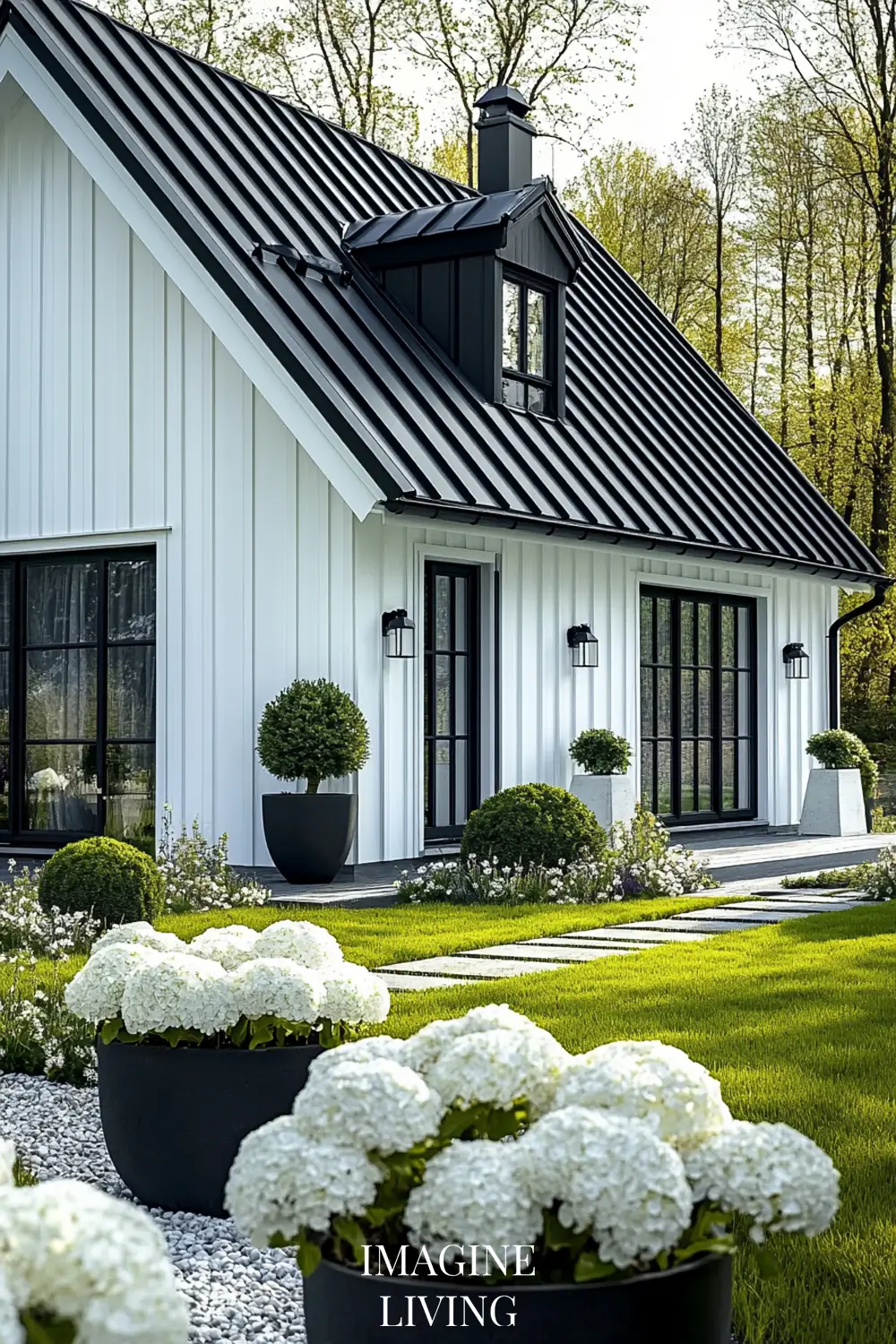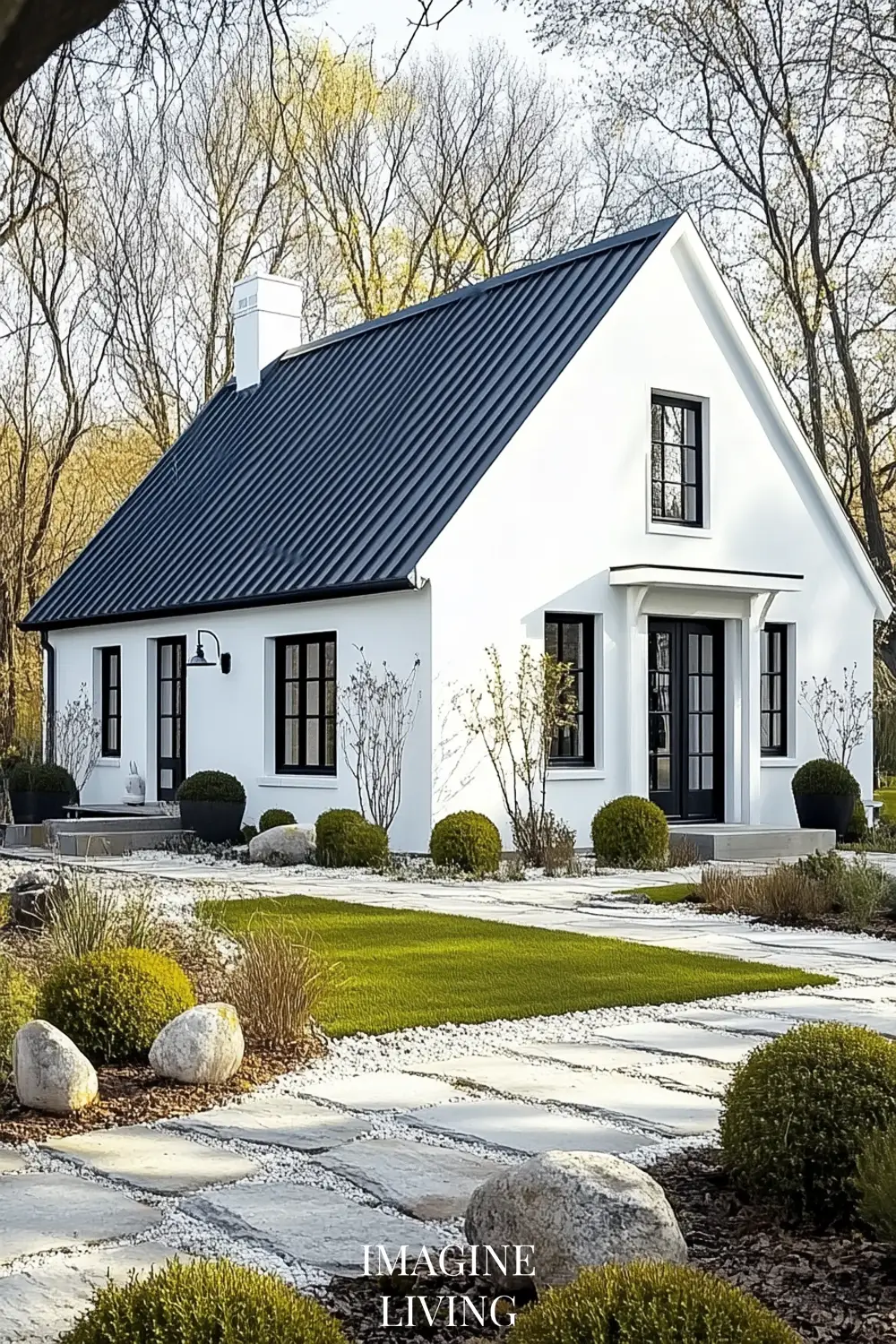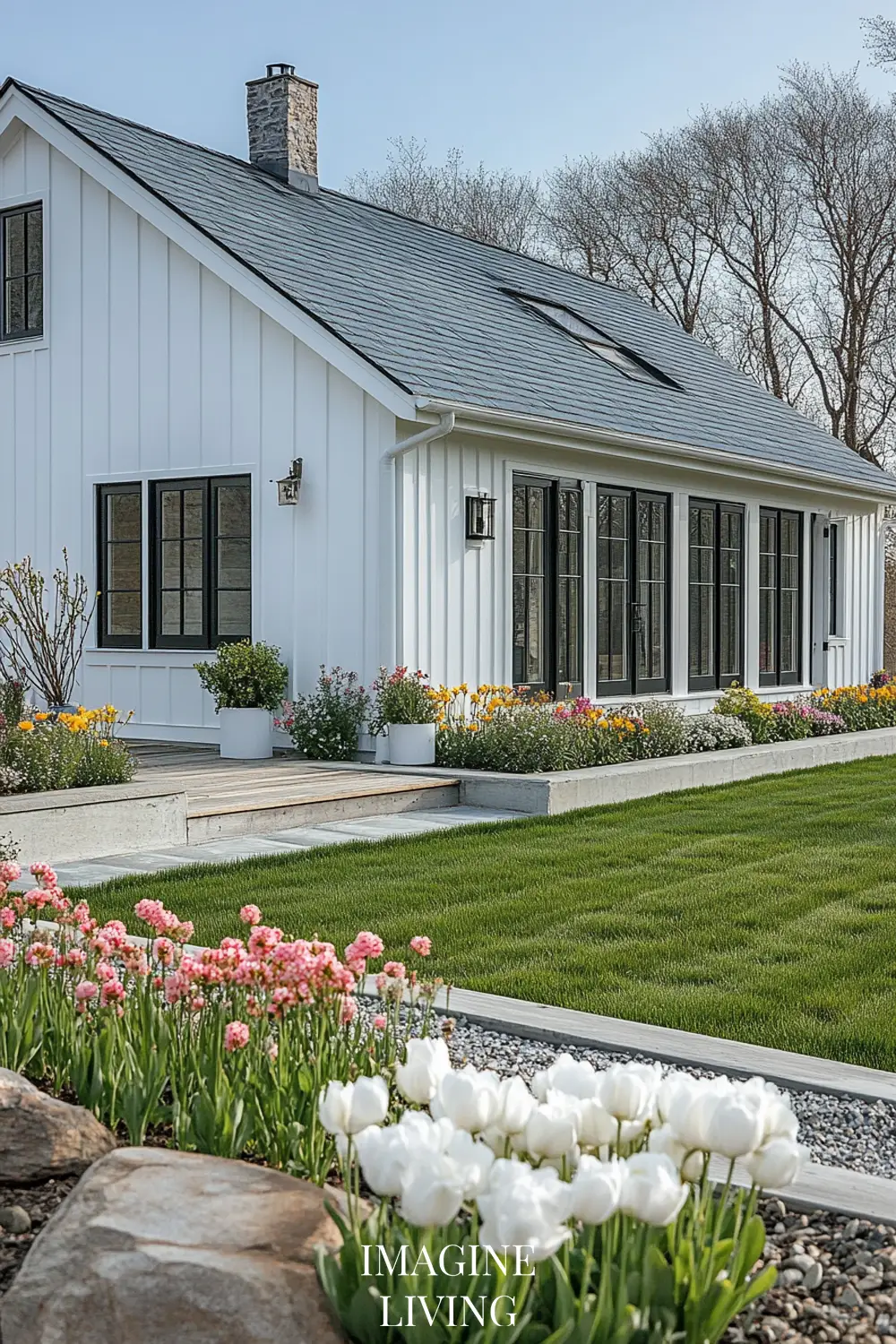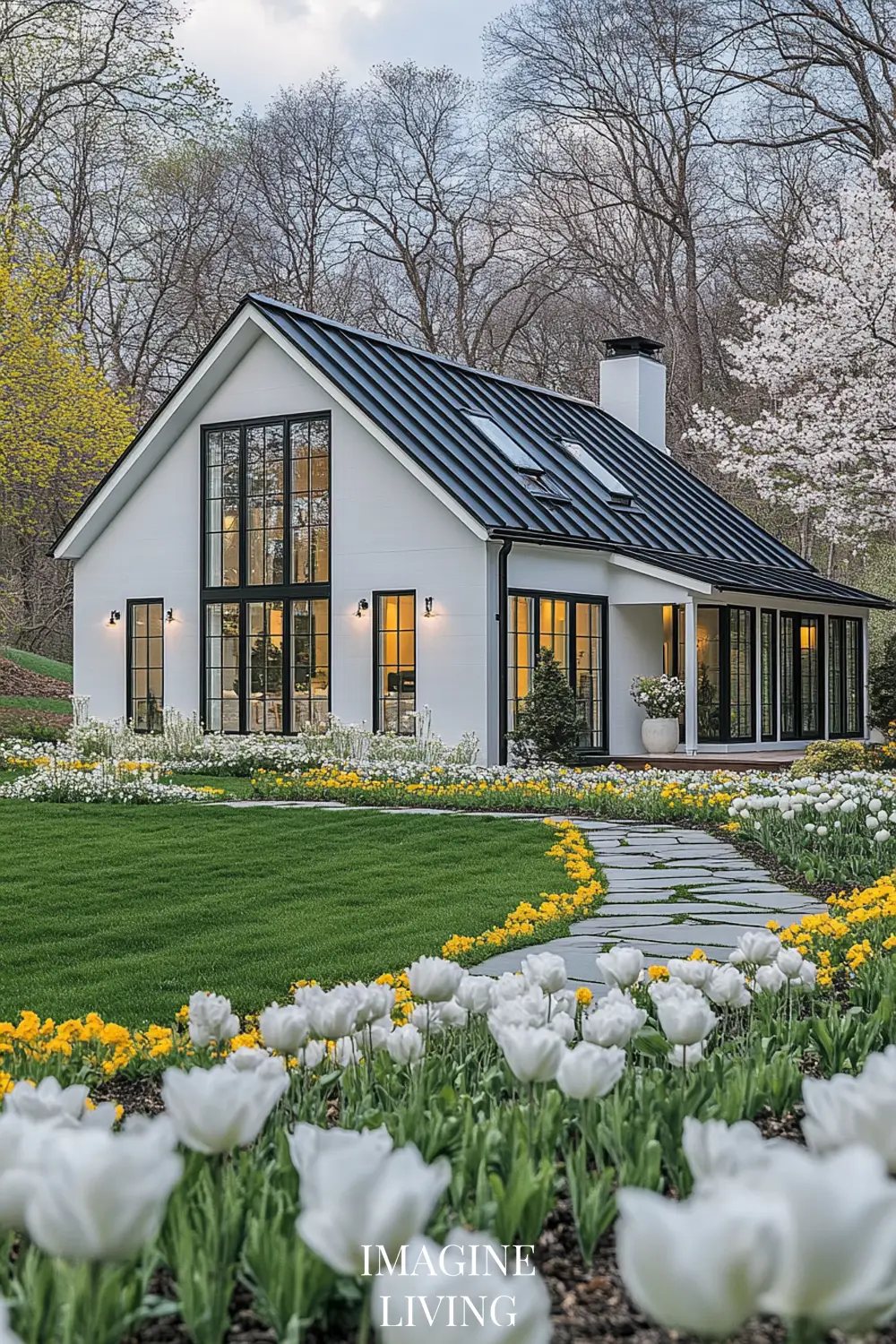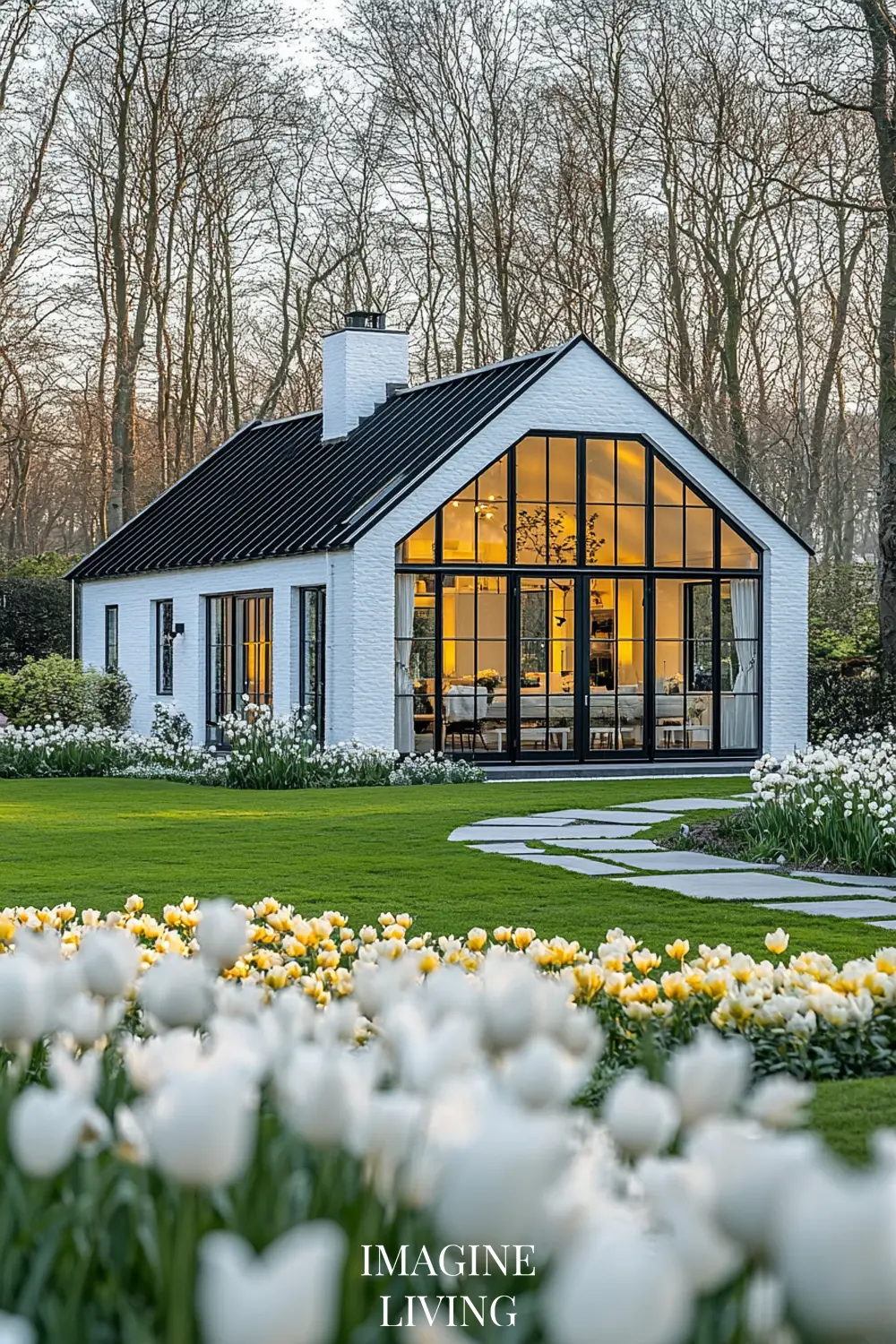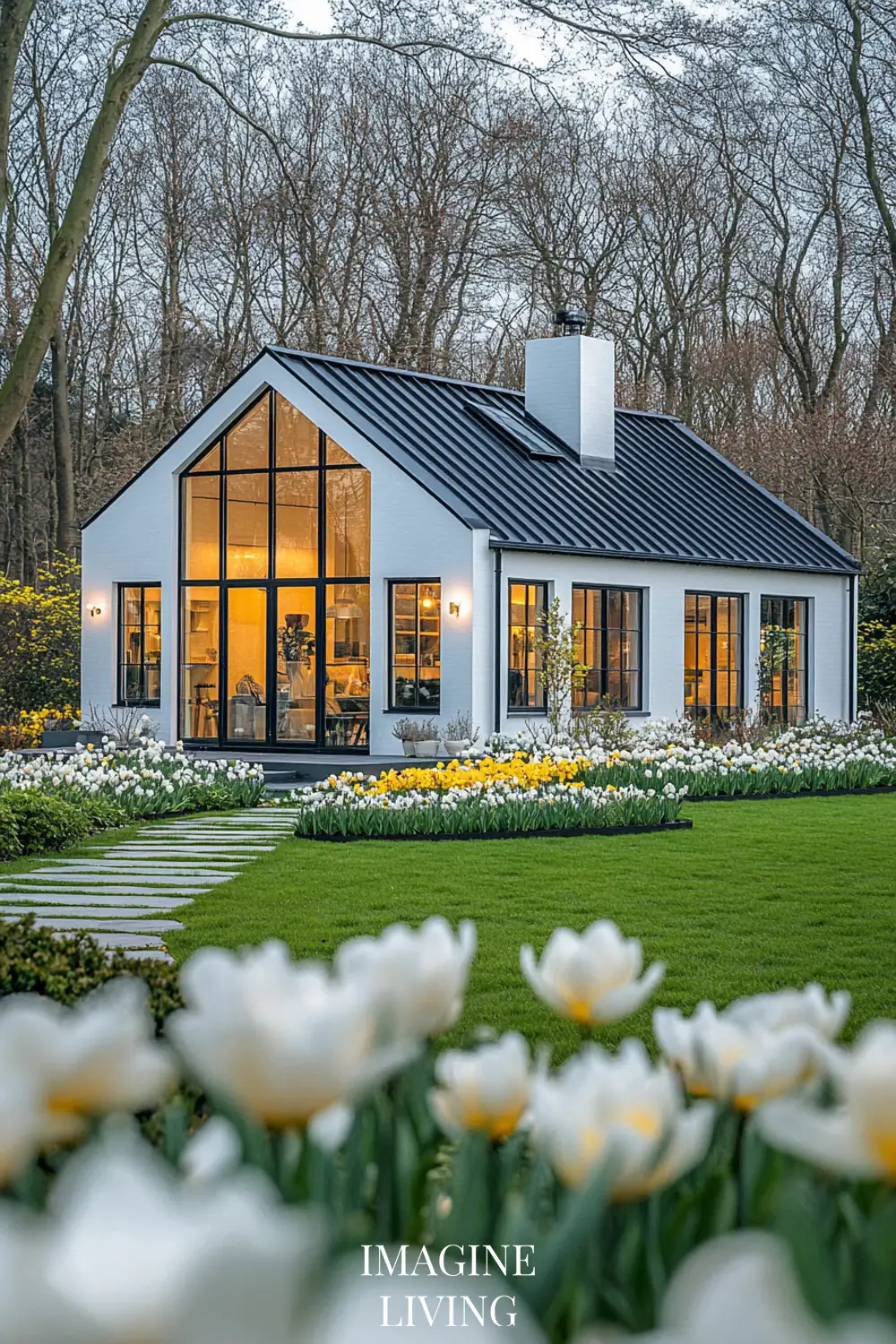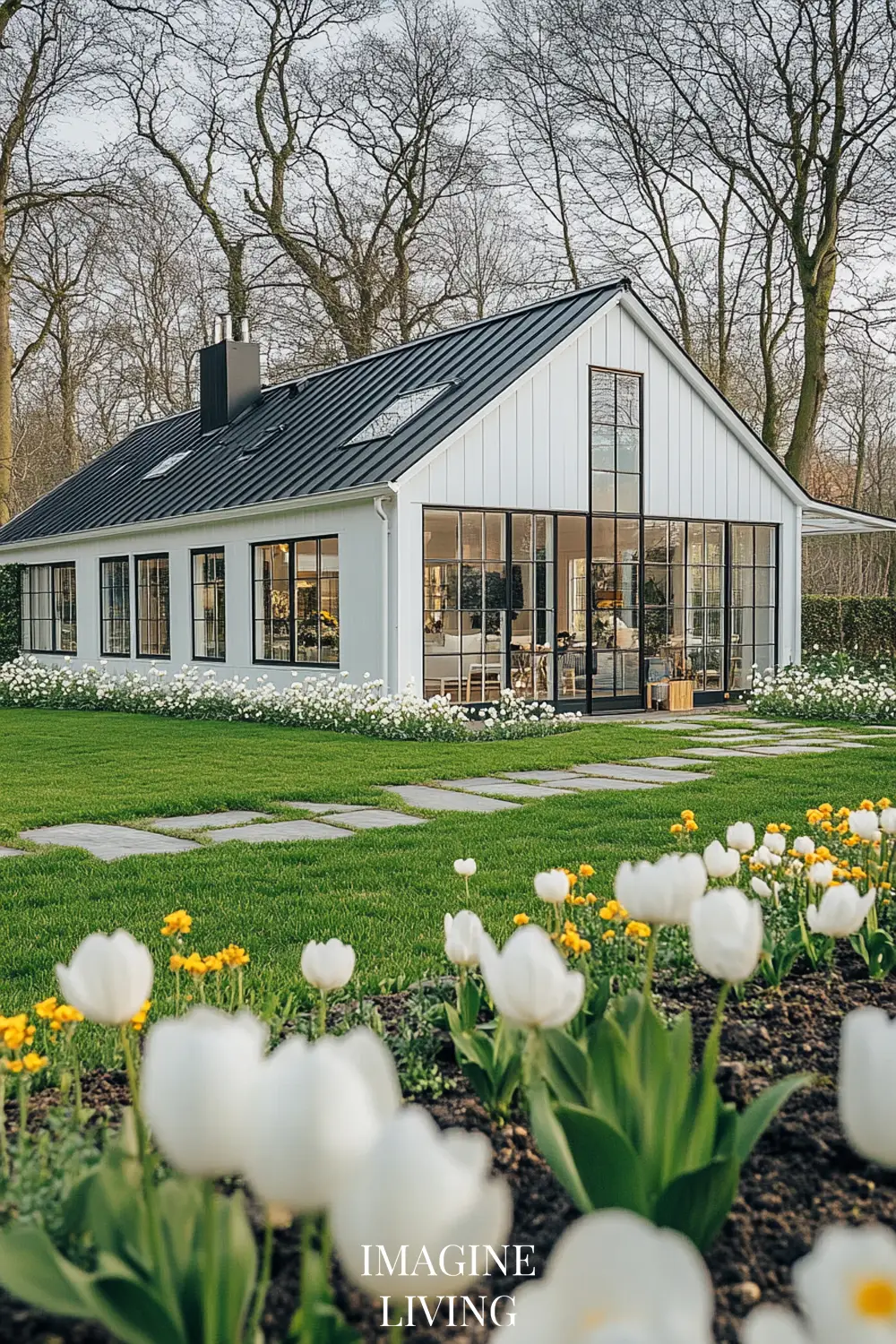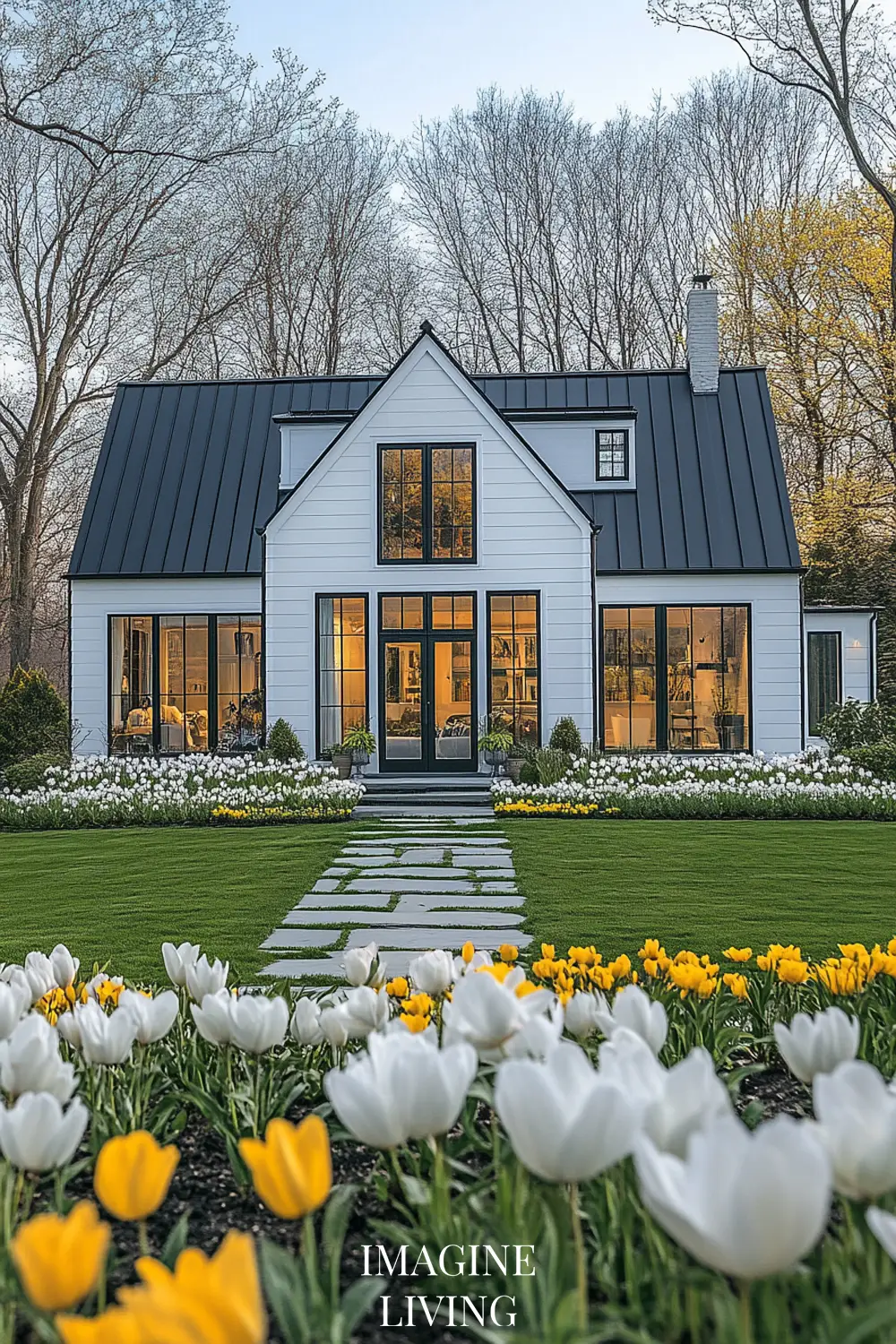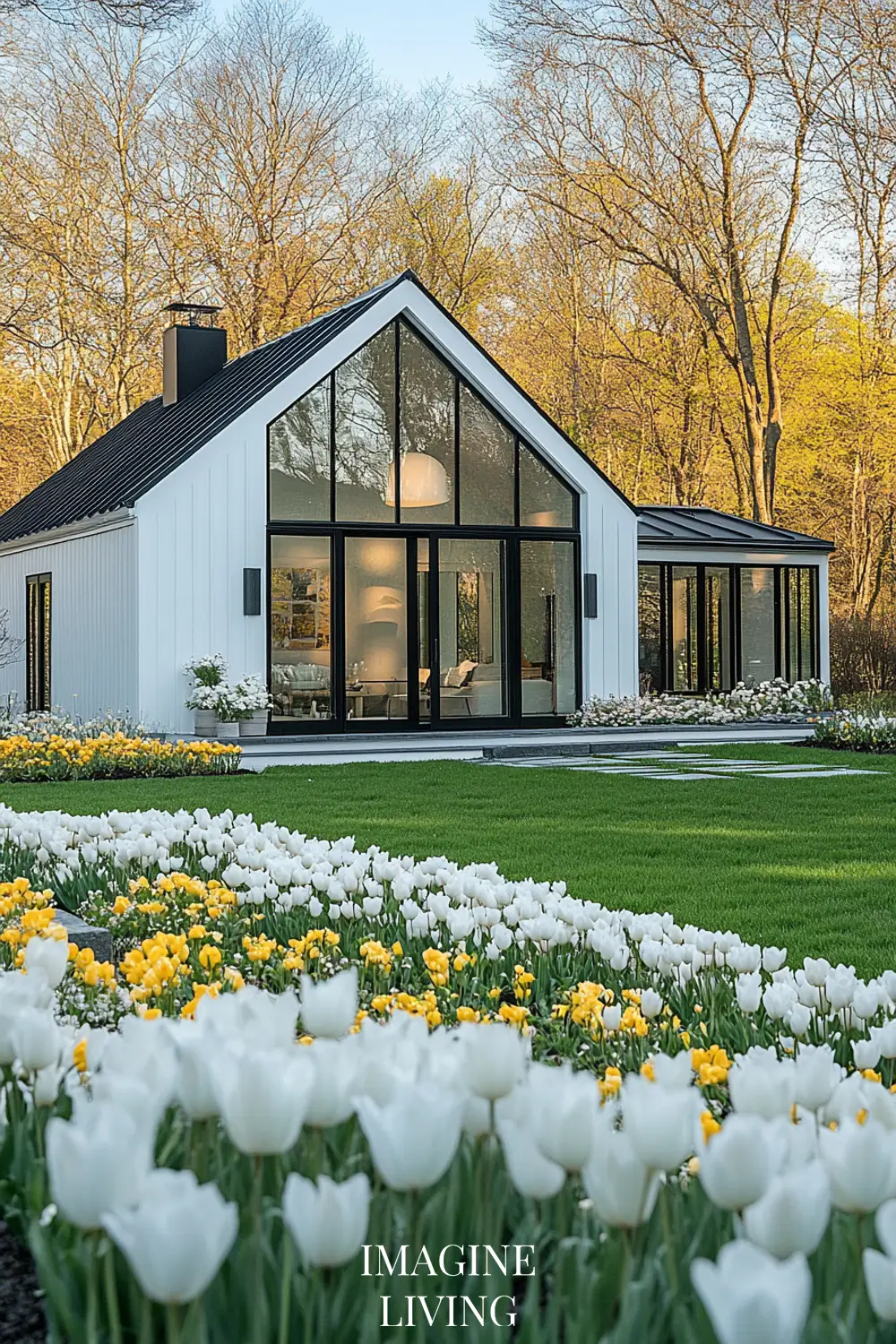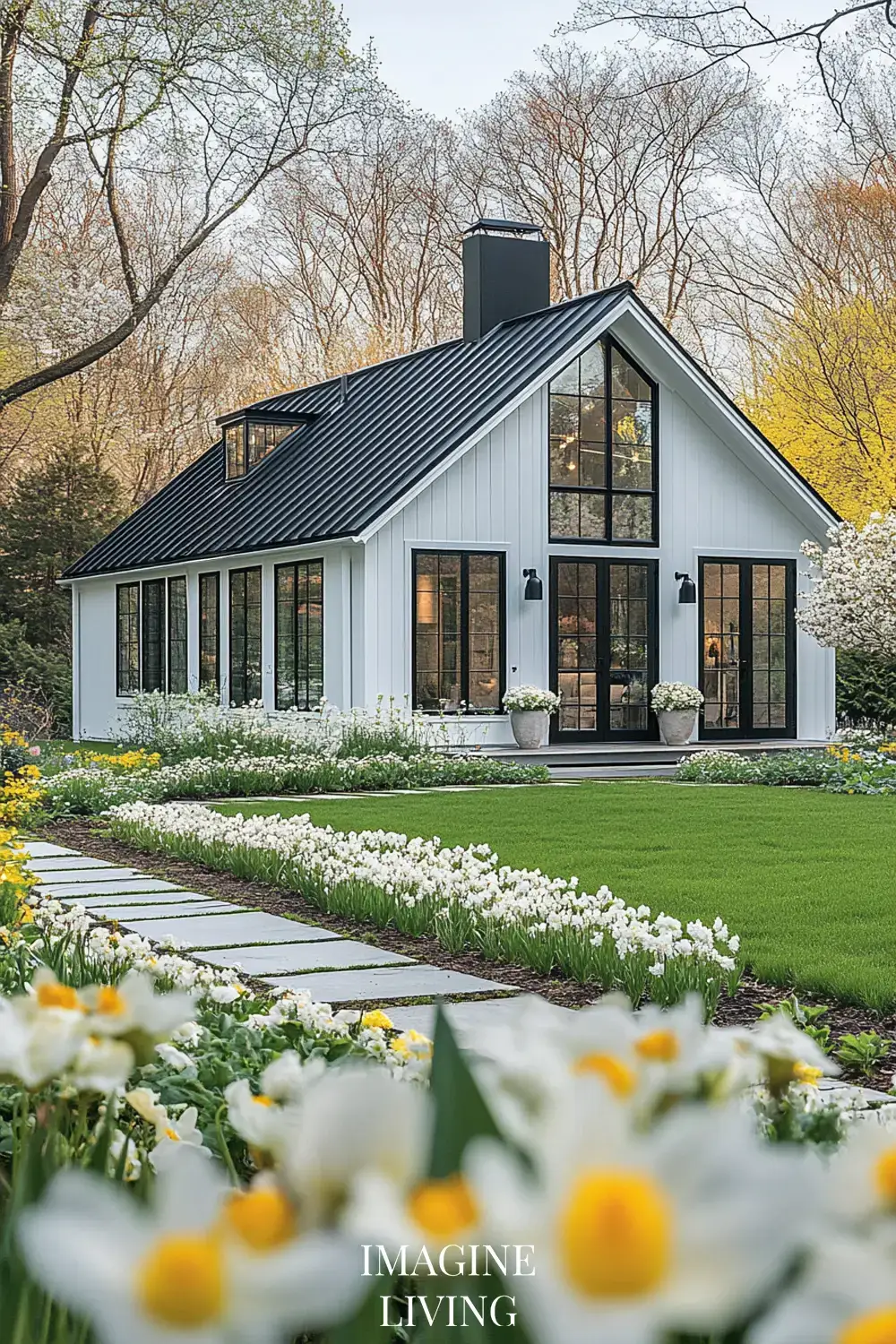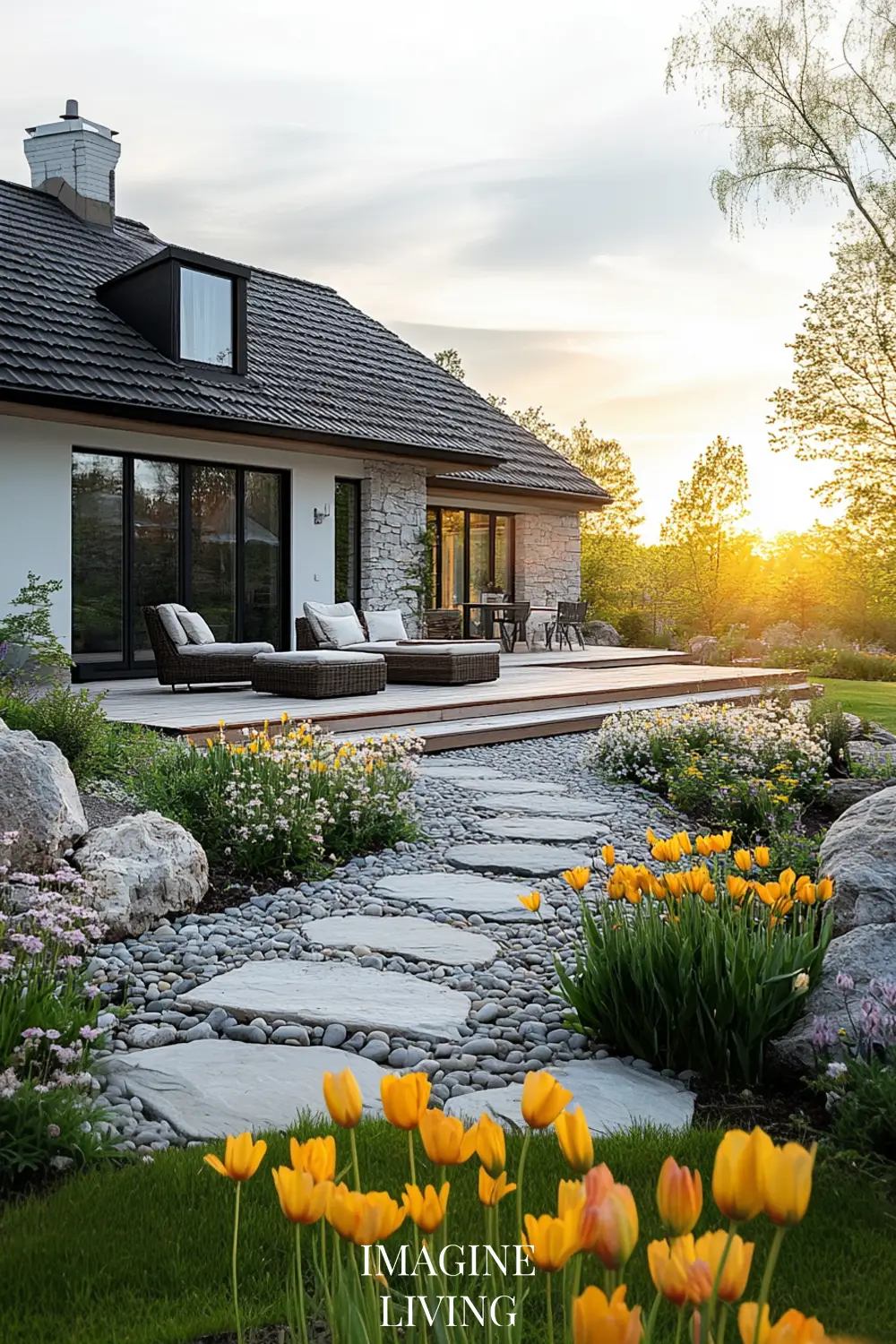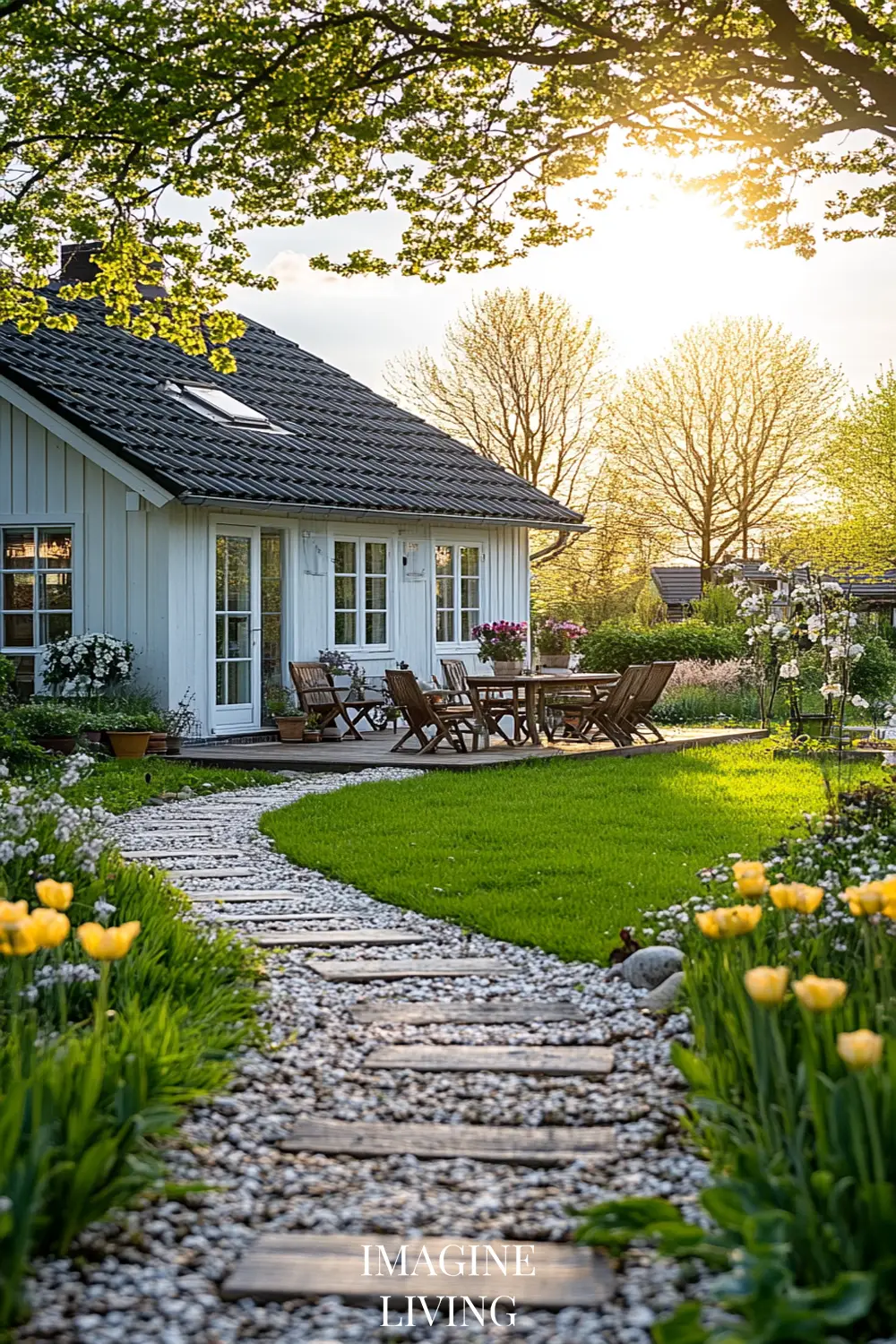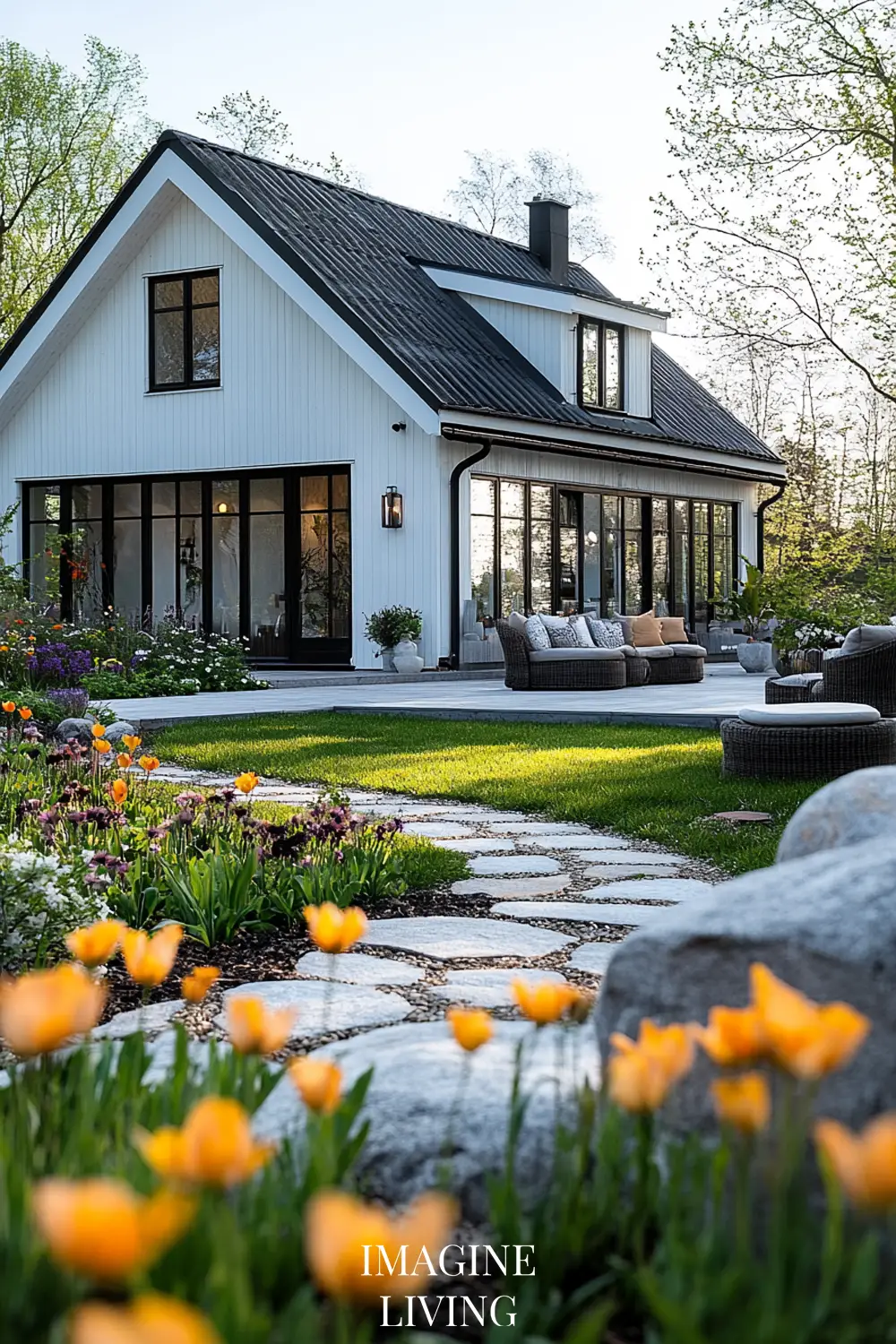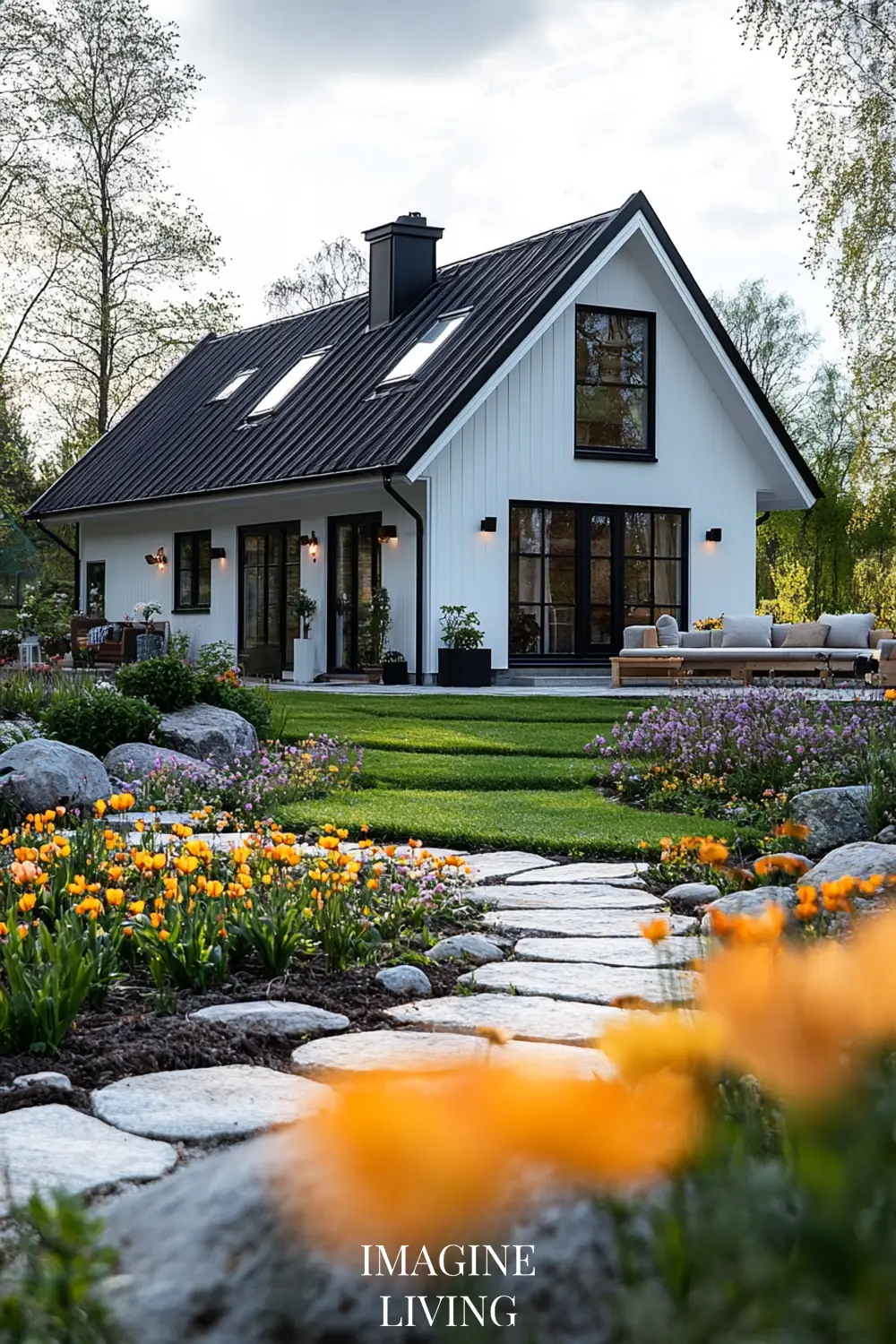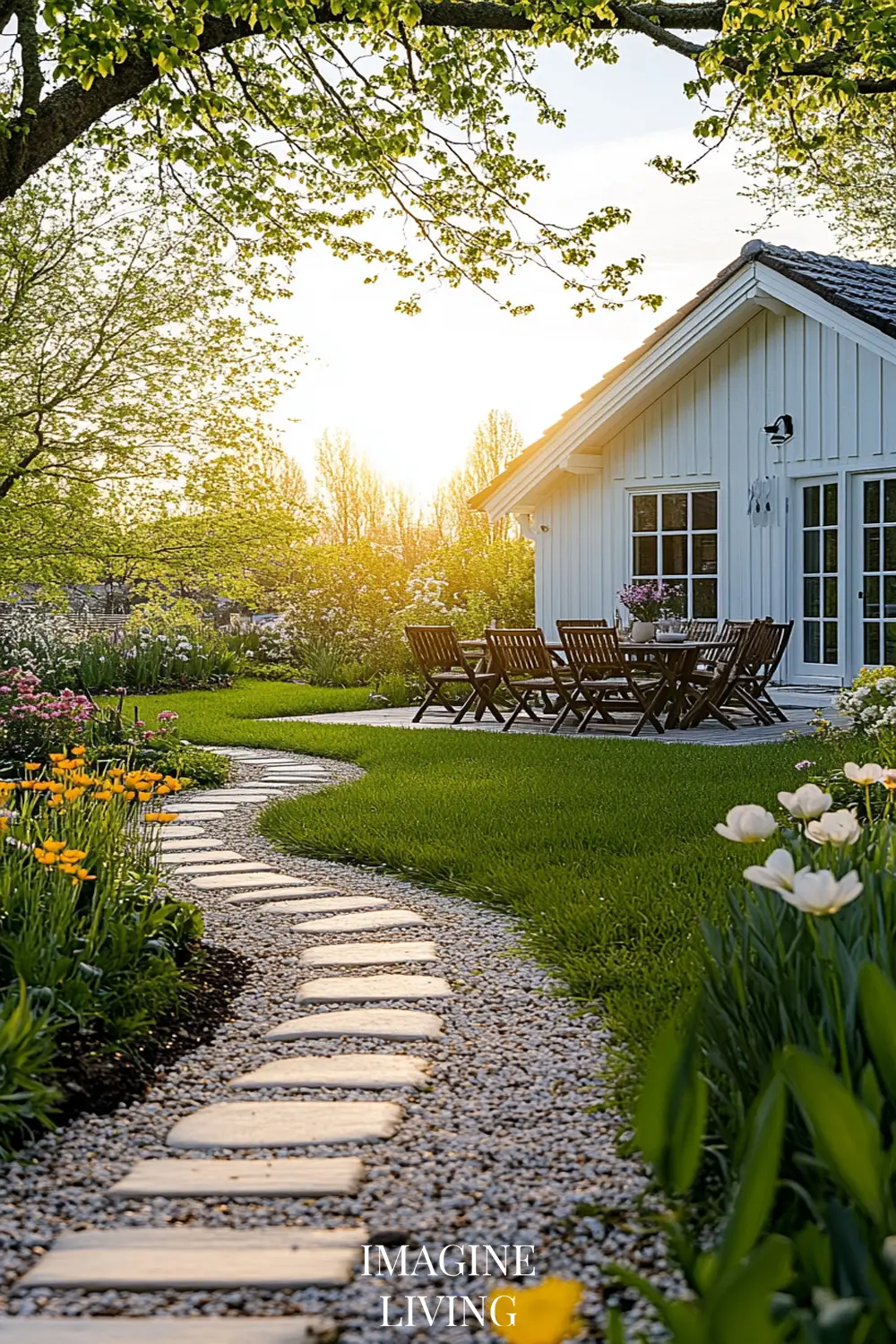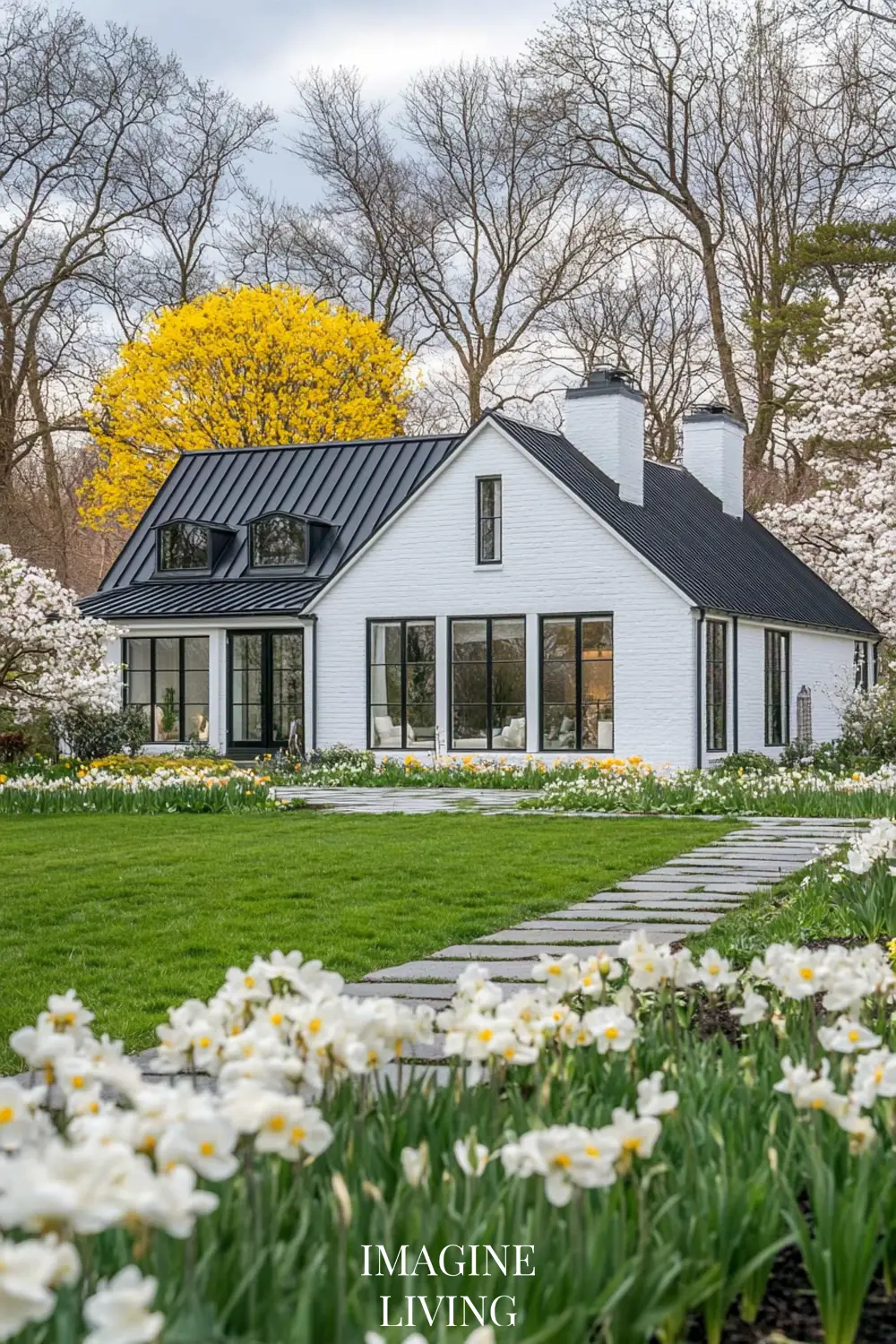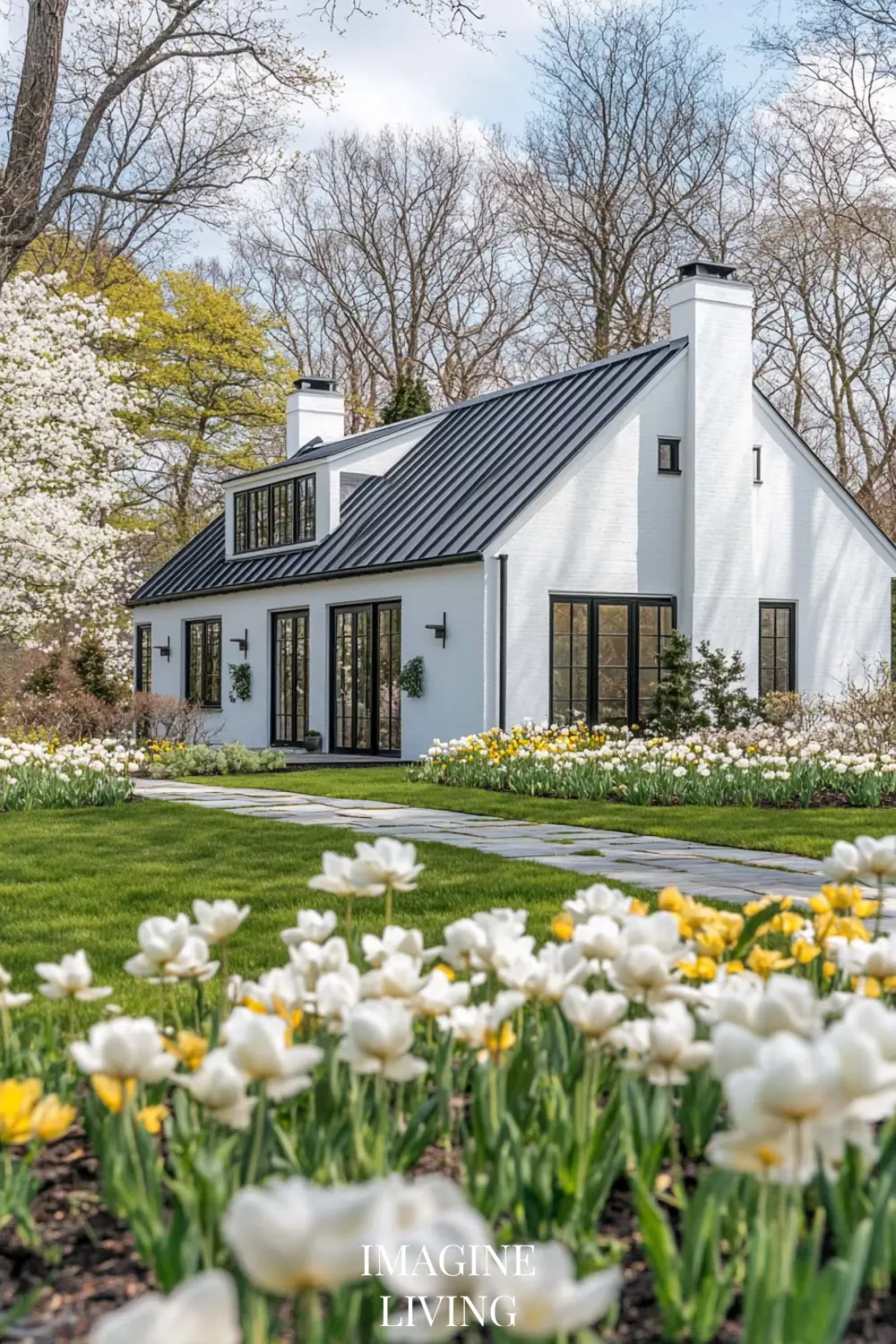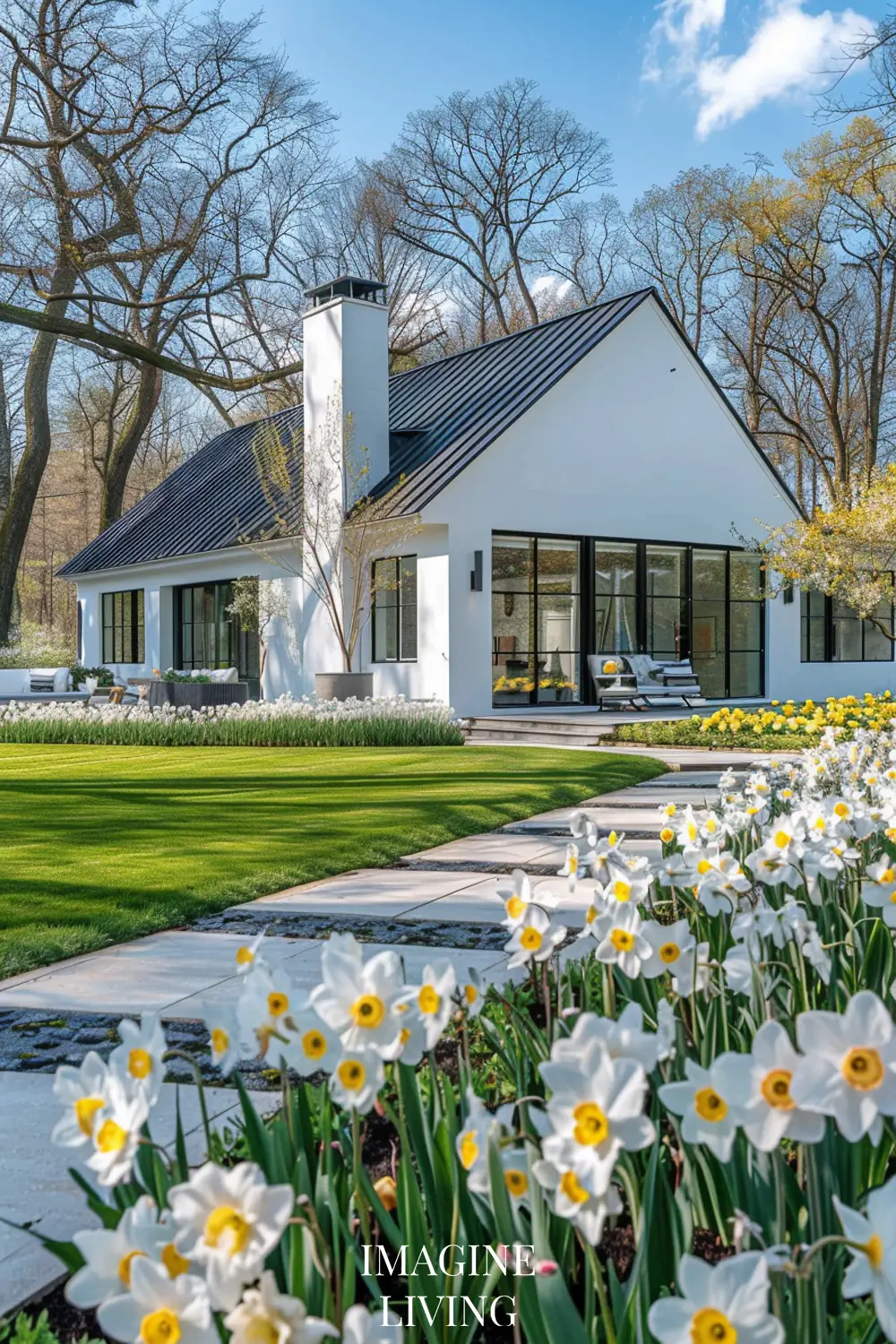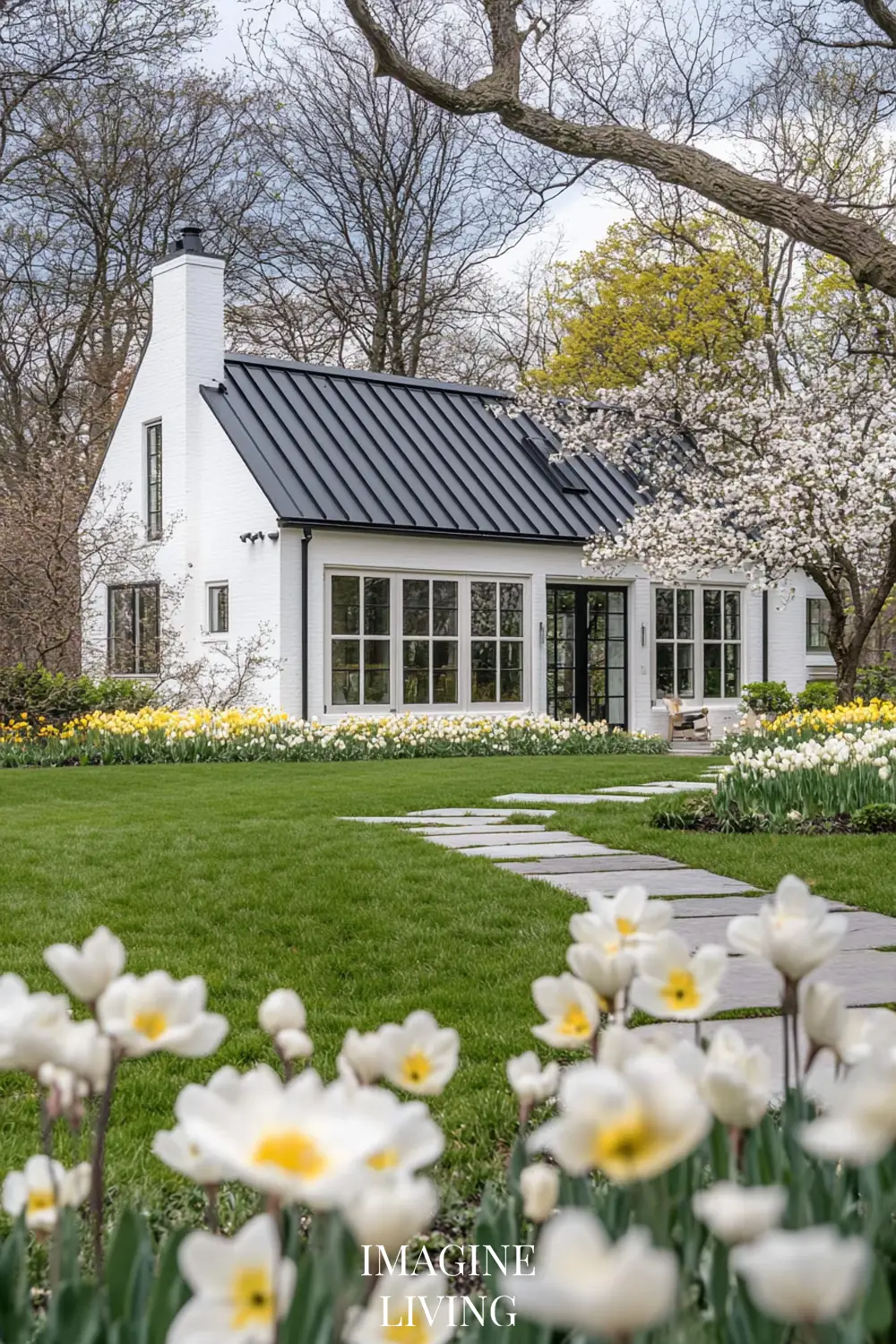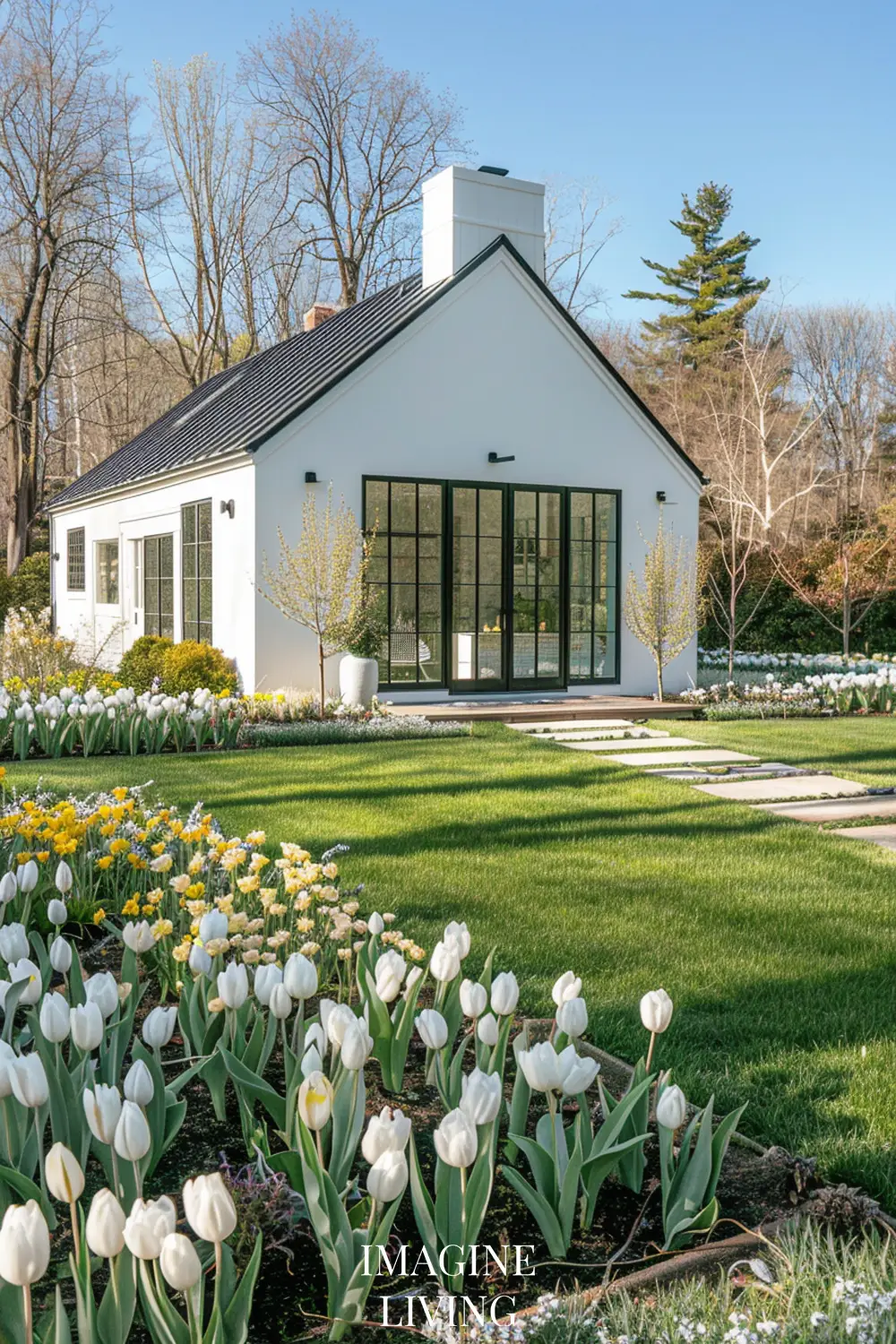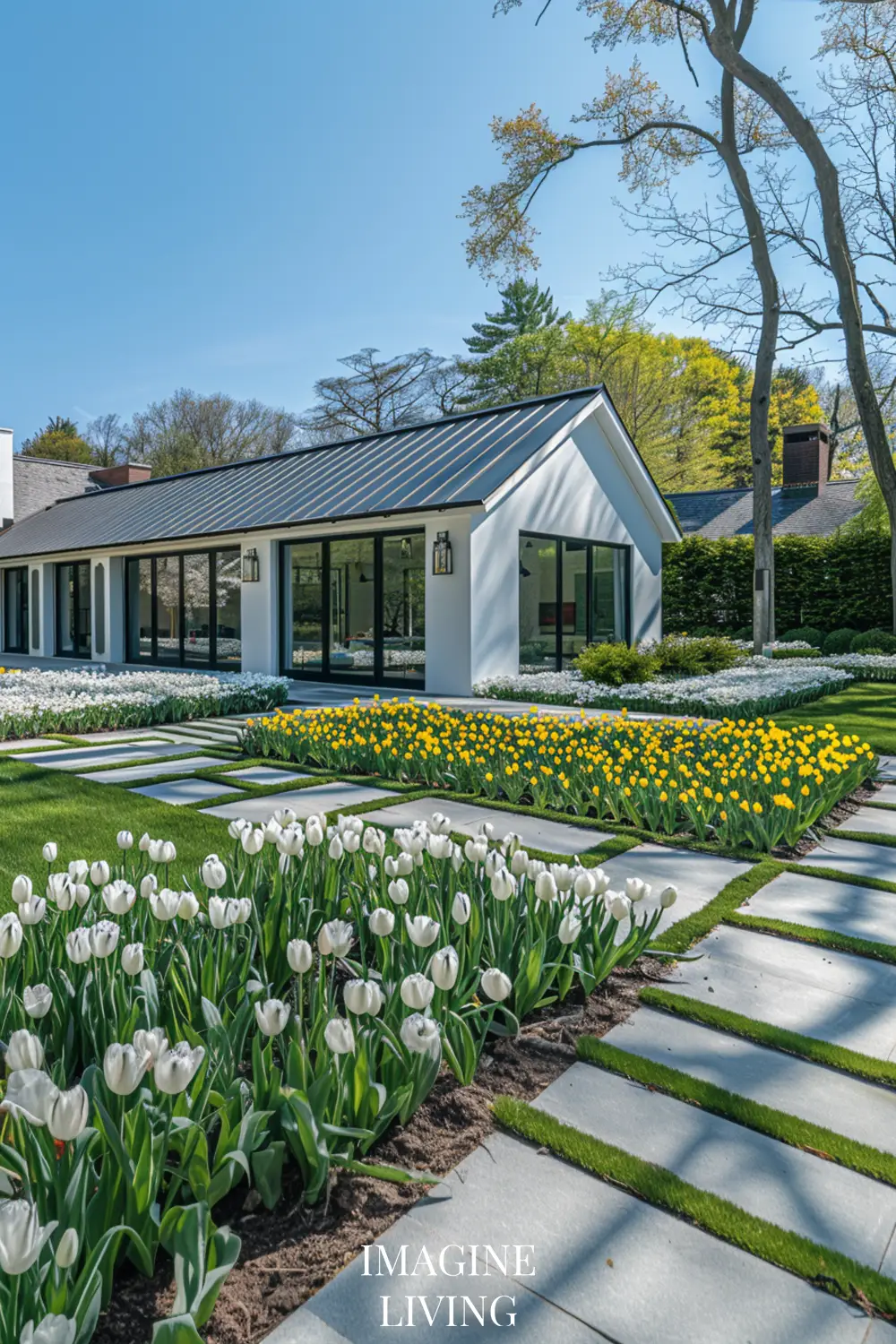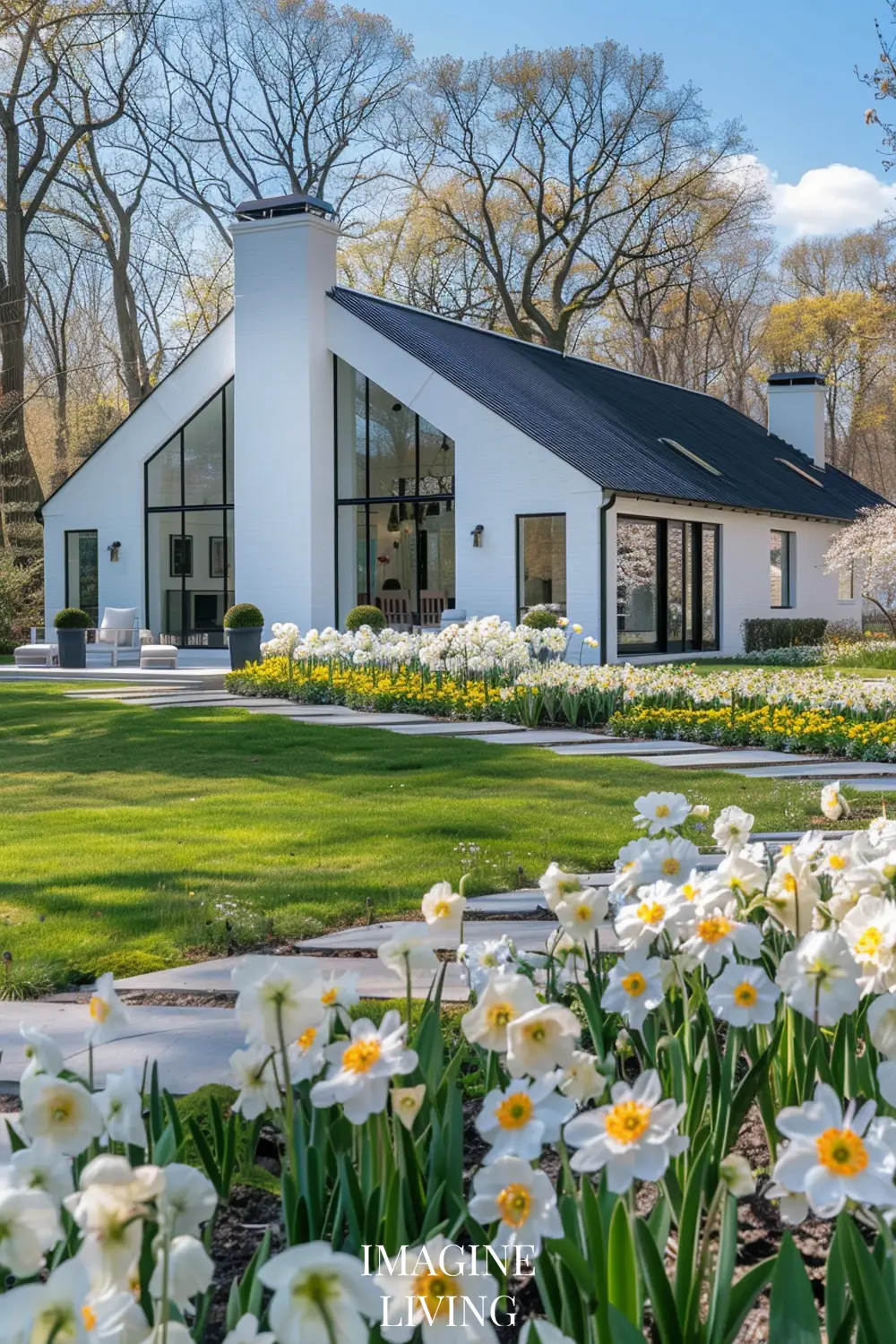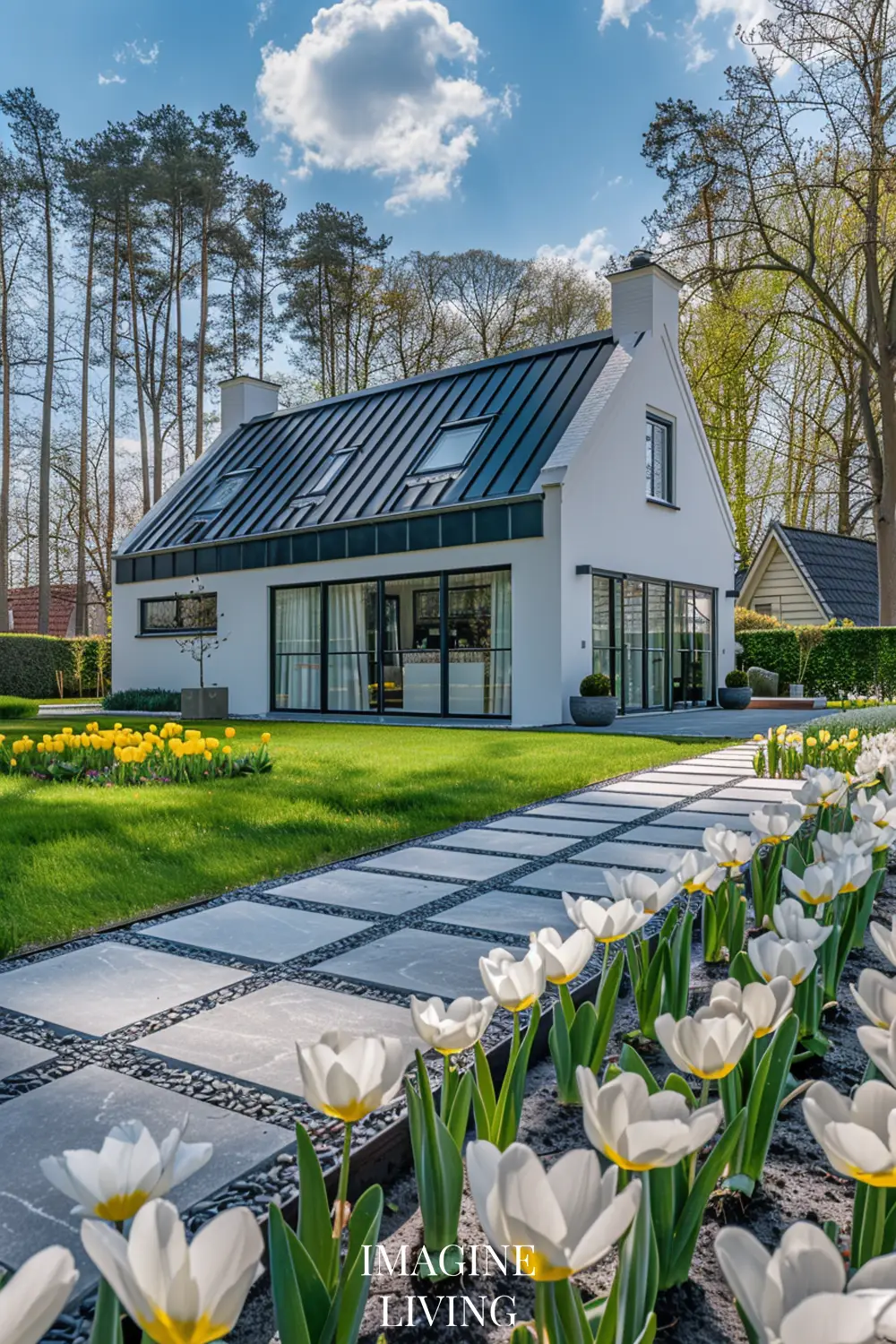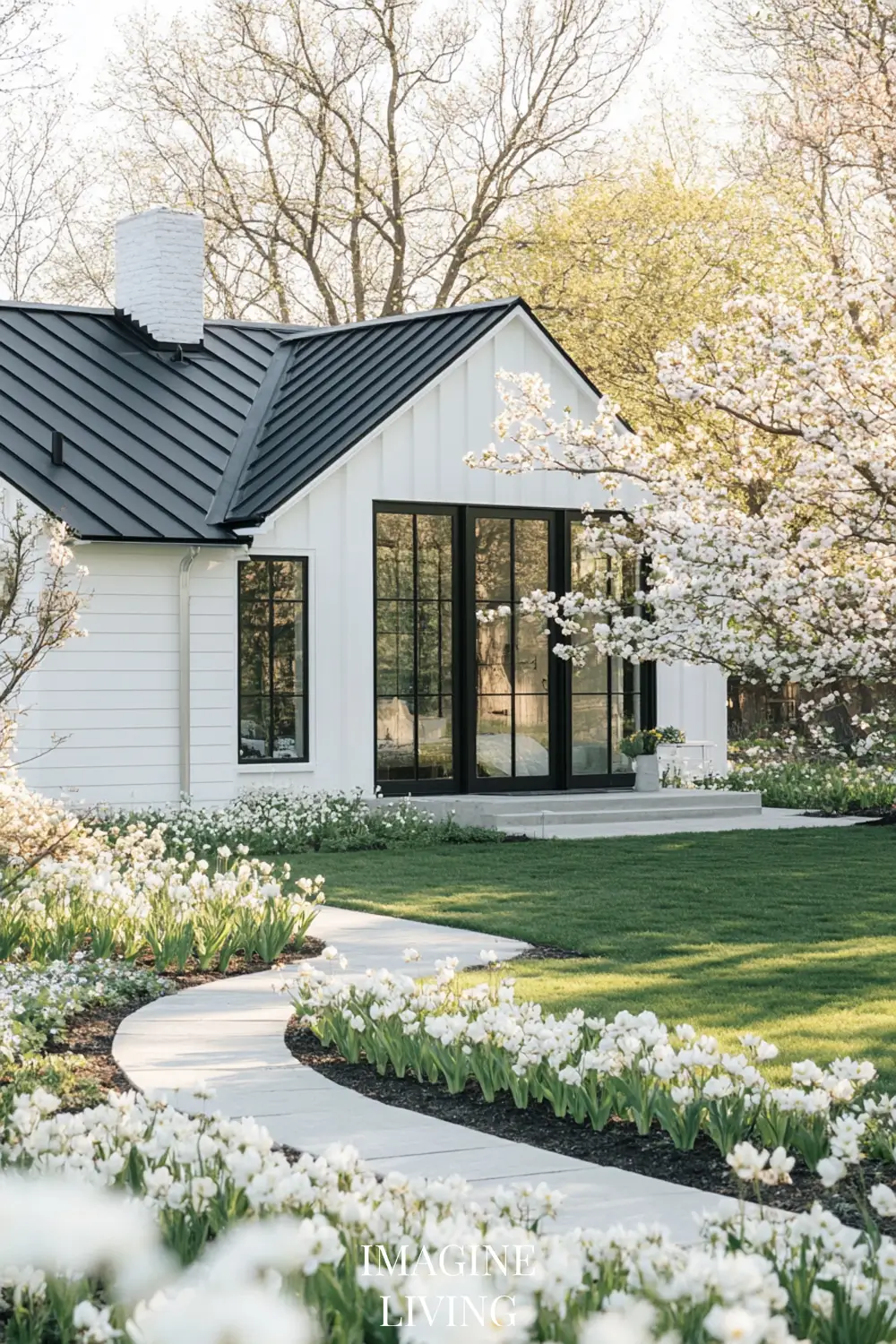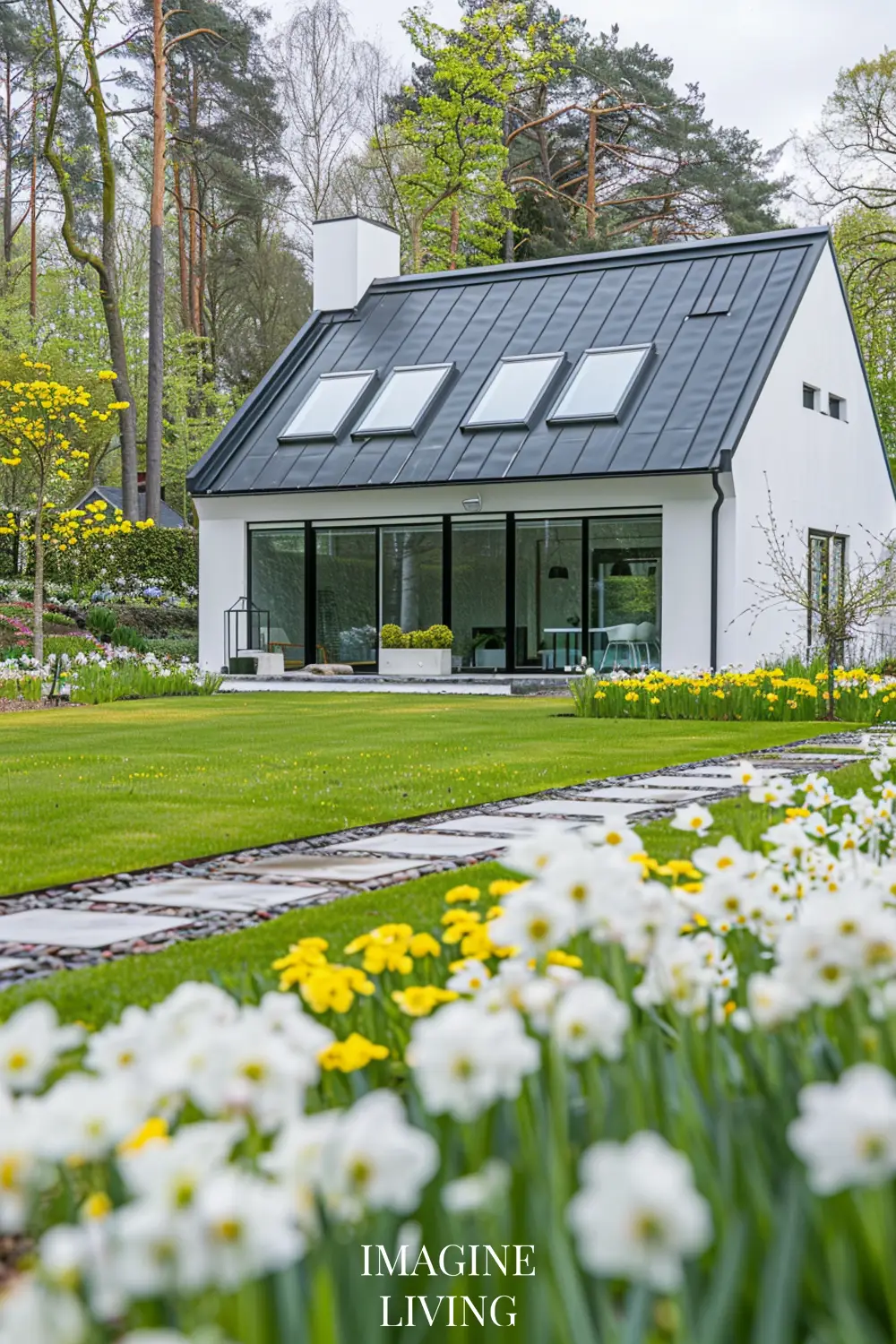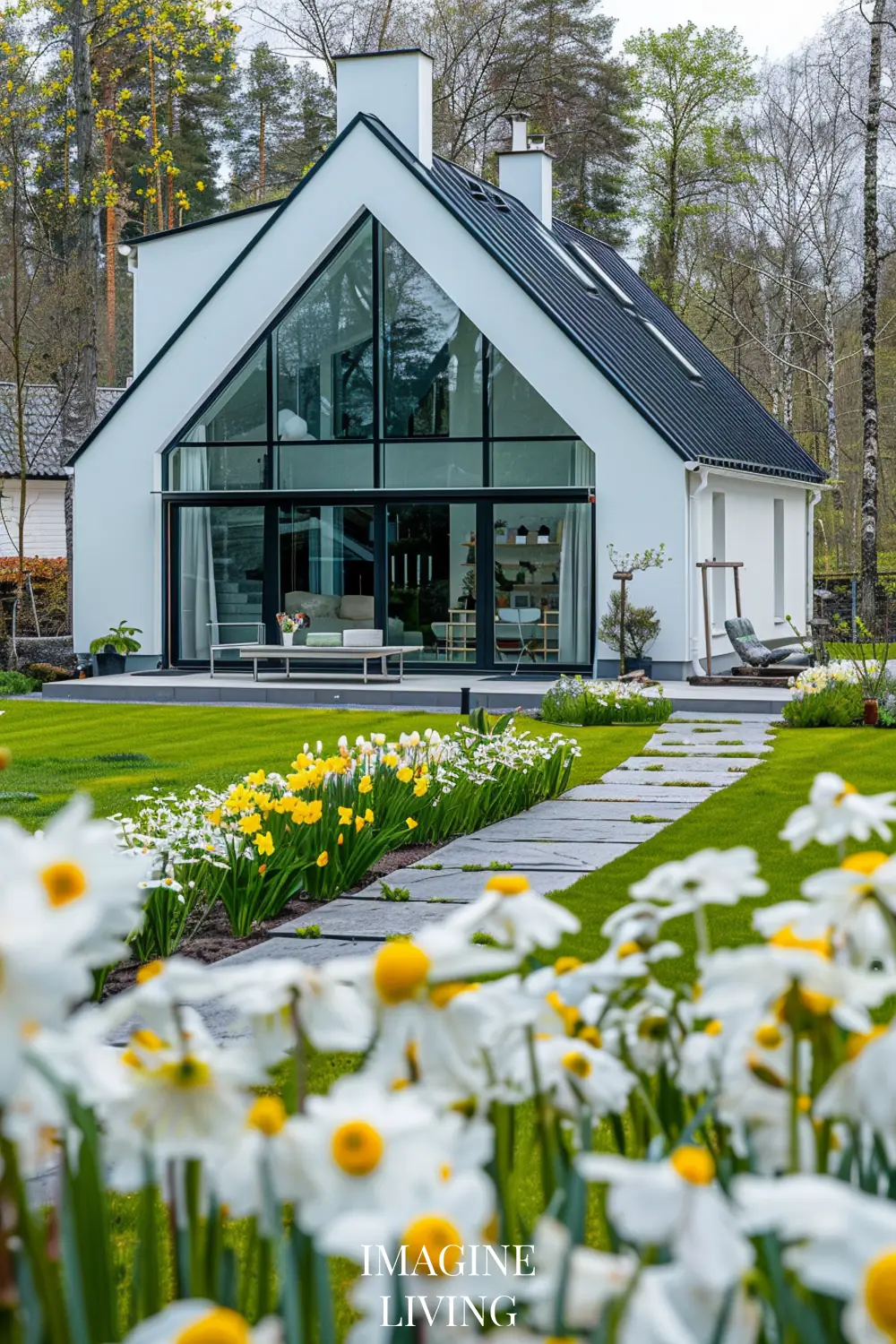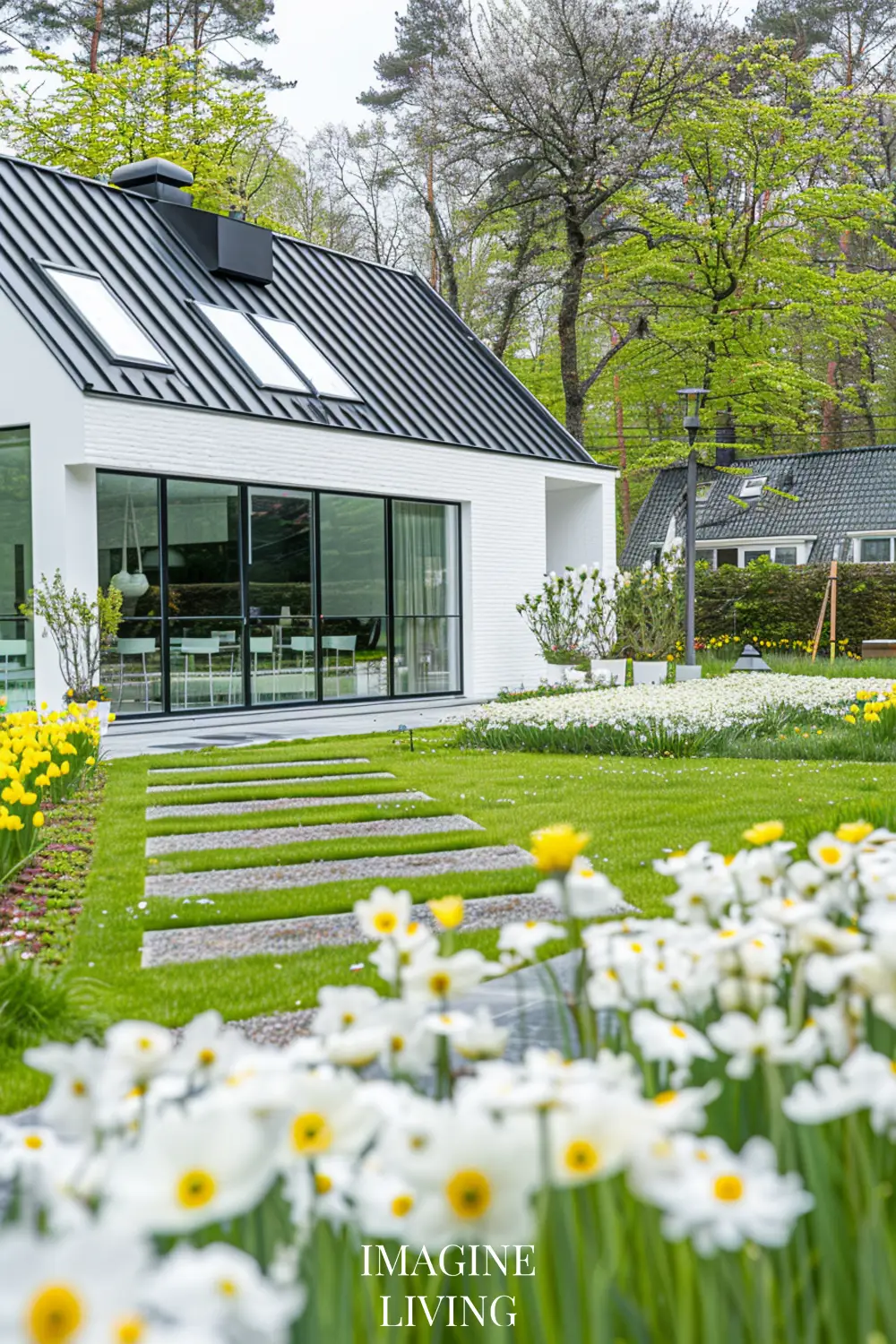40+ Minimalist Spring Cottage Exteriors: A Guide to Effortless Elegance
Spring has a way of reawakening spaces, bringing in light, softness, and a quiet kind of charm. A minimalist cottage exterior in spring isn’t about stripping everything down to stark simplicity—it’s about choosing beauty with intention. It’s the way fresh white facades reflect the morning light, how a single flowering tree can transform an entire entryway, or how clean lines and natural textures allow each detail to breathe.
I once visited a cottage on the edge of a Scandinavian forest, where the exterior was nothing but crisp white wood, black-framed windows, and a single wooden bench by the door. No excessive planters, no overflowing flower beds—just thoughtful restraint and quiet elegance. It was proof that a home doesn’t need abundance to feel warm, inviting, and effortlessly in tune with nature.
A minimalist spring cottage exterior is about finding that balance—a space that feels open, uncluttered, and fresh, yet still whispers a story of seasonal renewal. In this guide, we’ll explore how to create that look, from choosing the right color palette to adding just enough greenery to make it feel alive.
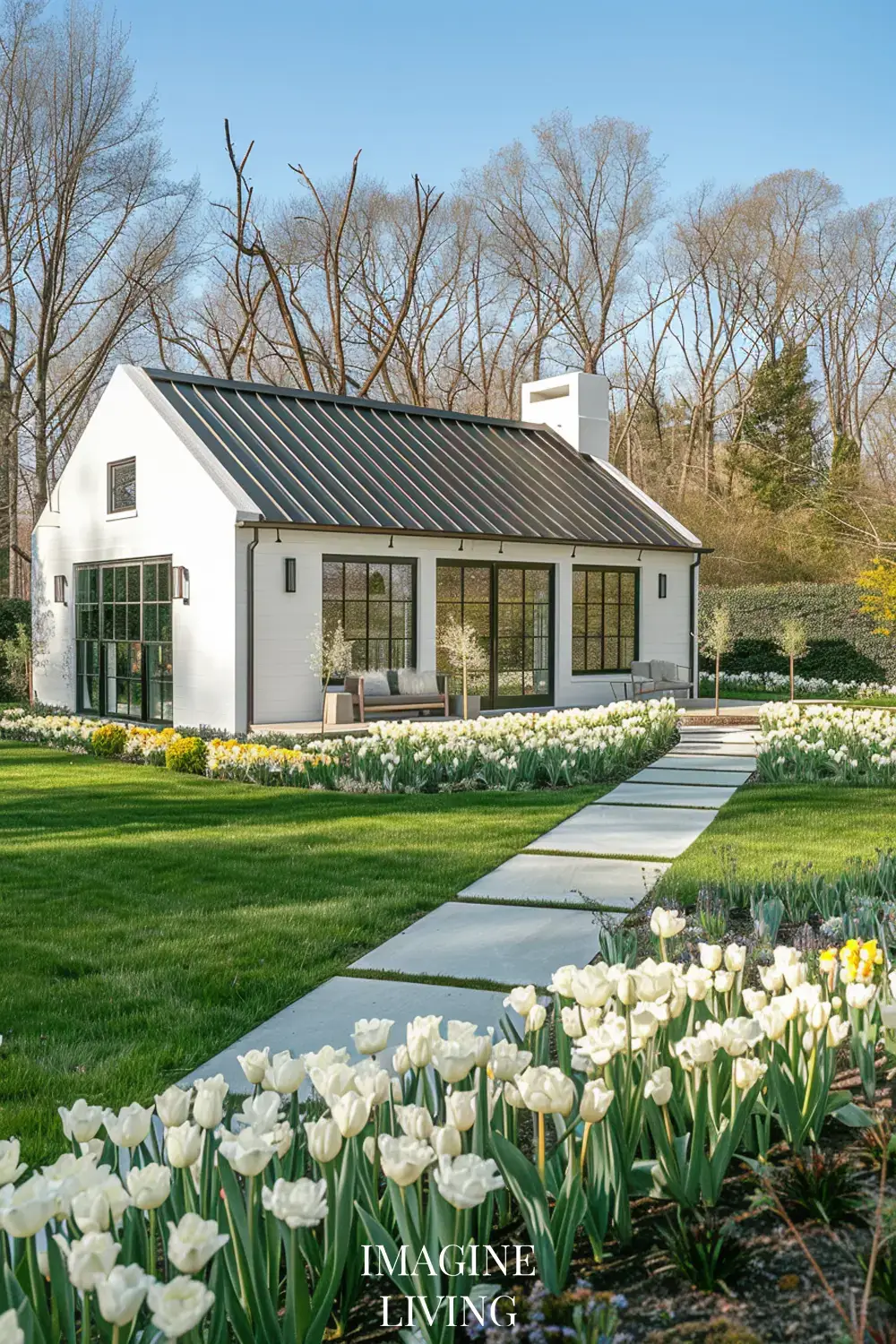
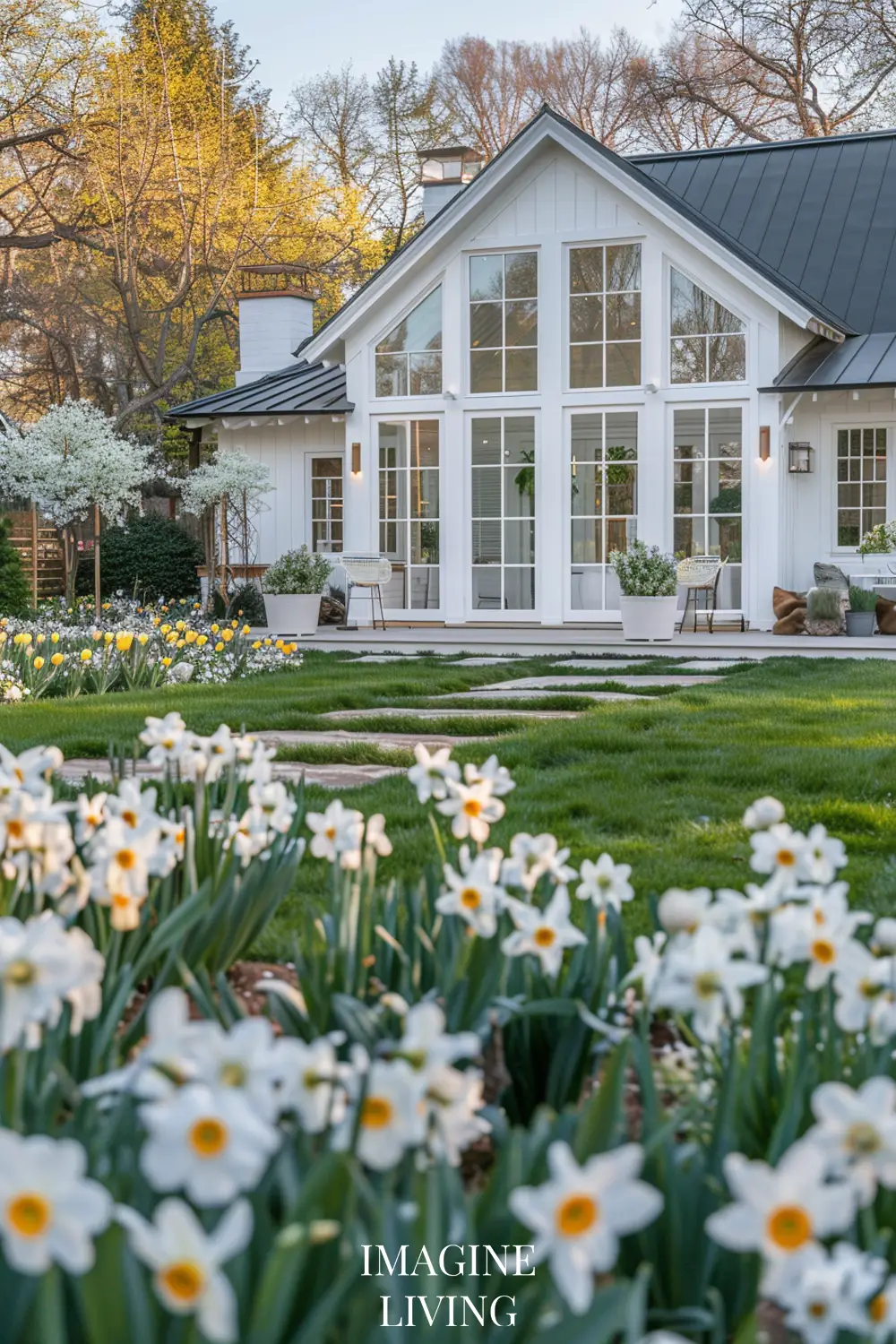
Why You’ll Love This Look
A minimalist spring cottage exterior is more than just an aesthetic choice; it’s a lifestyle statement. It’s about creating a space that feels fresh, uncluttered, and harmonious with nature, without losing warmth and personality. Here’s why this look is worth embracing:
- Effortless Elegance – Clean lines and neutral palettes give your cottage an elevated, yet relaxed charm.
- Timeless Appeal – A minimalist approach transcends trends, ensuring your cottage looks beautiful year after year.
- Easy Maintenance – Fewer elements mean less upkeep, making it ideal for those who love a beautiful space without the hassle.
- A Calming Atmosphere – The absence of visual clutter fosters a sense of peace and tranquility, perfect for unwinding.
- Subtle Spring Accents Shine Brighter – When the backdrop is minimalist, seasonal touches like cherry blossoms or soft greenery become the stars.
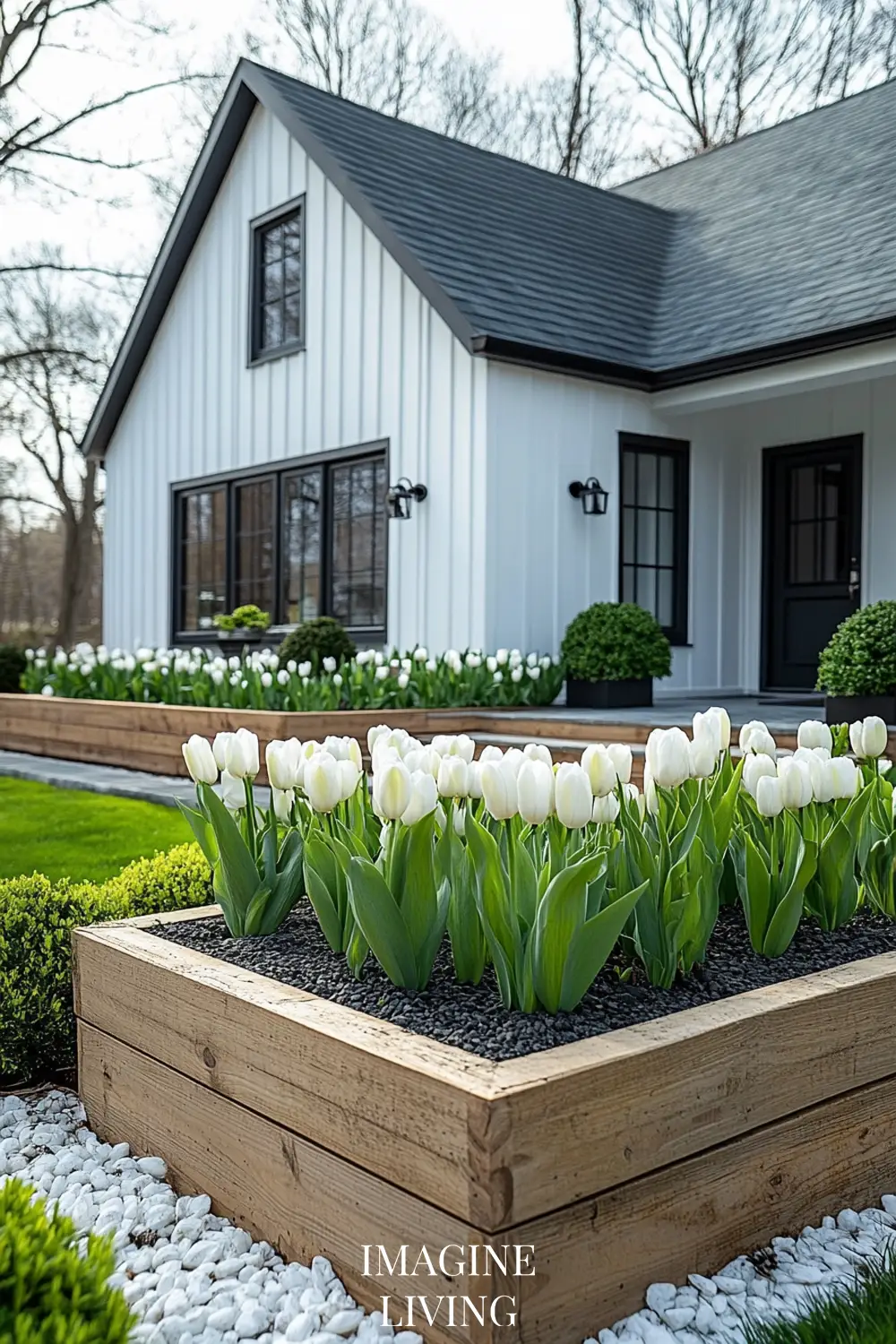
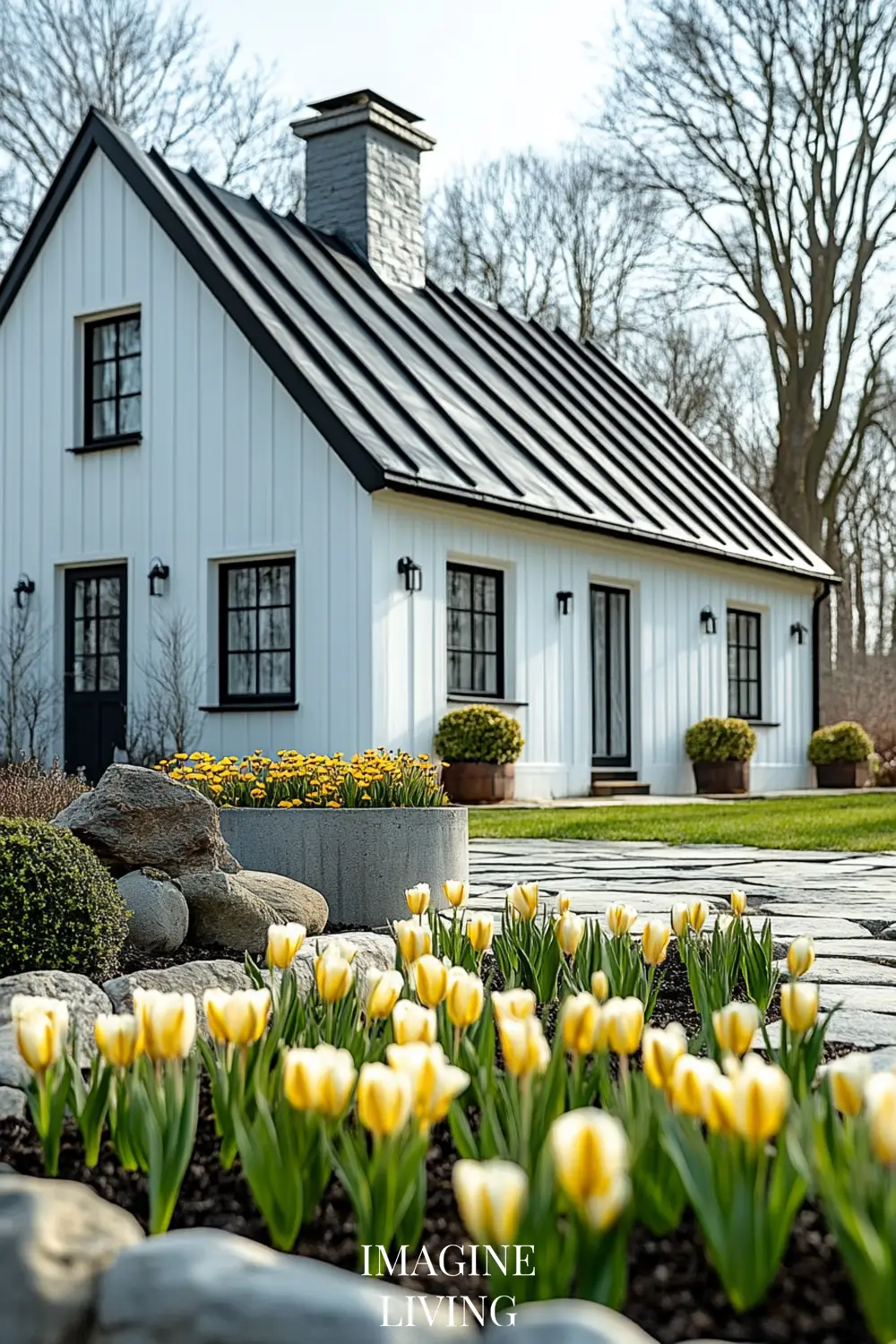
Key Elements of a Minimalist Spring Cottage Exterior
Minimalism in cottage exteriors is all about restraint and balance. These are the defining features that will give your home that clean, elegant spring-ready look:
1. A Crisp, Light Exterior Palette
- White, soft gray, or cream-colored facades work beautifully for a minimalist cottage aesthetic.
- If using contrast, go for black-framed windows or muted tones like sage, beige, or pale blue.
2. Structured Landscaping
- Instead of overgrown gardens, opt for neatly arranged flower beds with limited but impactful choices (think white tulips, lavender, or delicate greenery).
- Keep pathways clean and defined, using materials like gravel, stone, or light wood.
3. Subtle Architectural Details
- Minimalist doesn’t mean boring—wooden beams, clean window shutters, or simple porch columns add subtle depth.
- Choose matte black or brushed brass light fixtures for a hint of contrast without visual clutter.
4. Potted Plants Over Flower Beds
- Potted plants add a curated, intentional feel while being easy to rearrange for the seasons.
- Stick to one or two varieties of plants per space—white hydrangeas, olive trees, or simple clay pots of herbs.
5. Natural Wood or Stone Accents
- Warm up the look with wooden benches, planters, or stone garden edging.
- Scandinavian cottages often use light or weathered wood tones to balance the white facades.

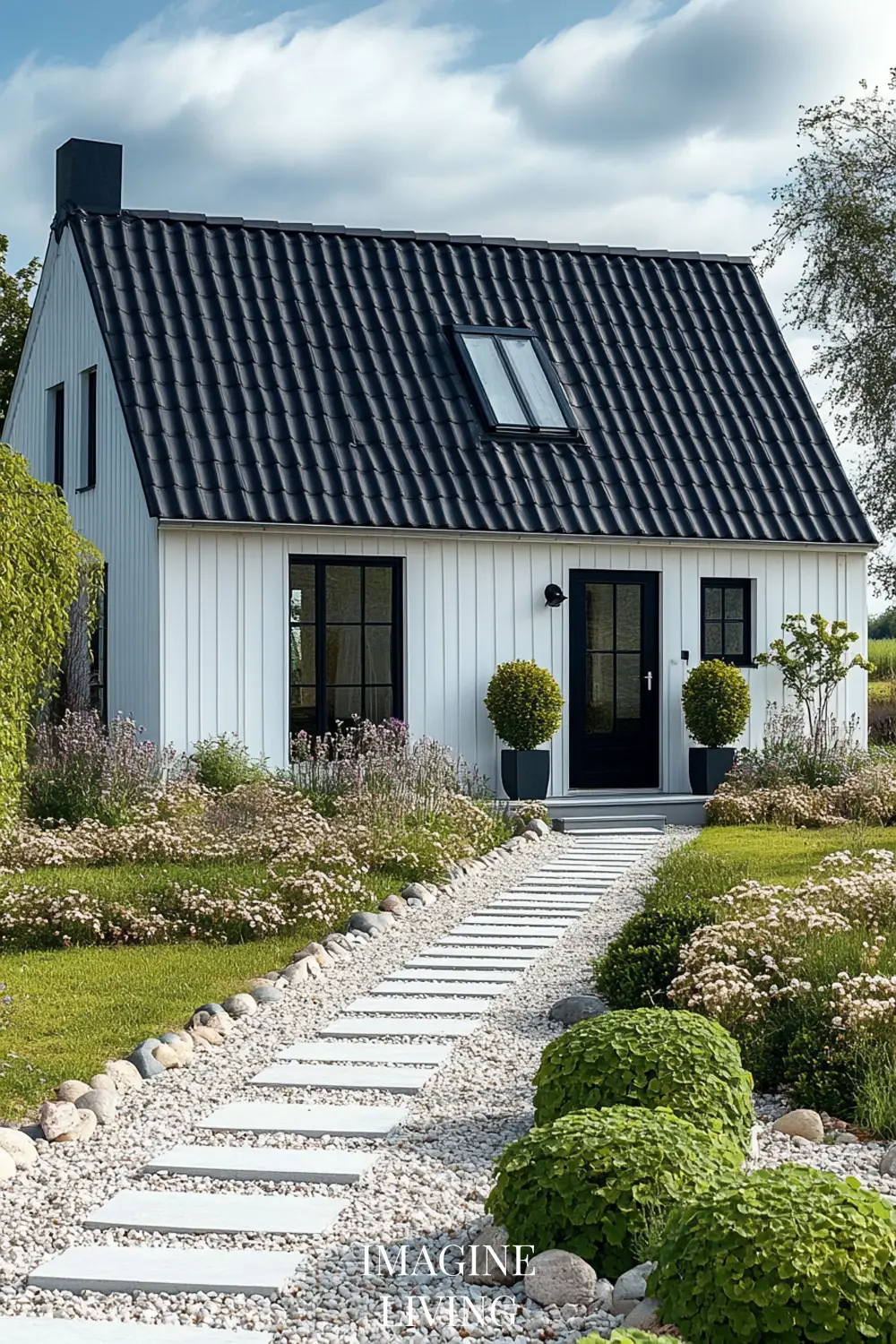
Step-by-Step Guide to Achieving a Minimalist Spring Cottage Exterior
Minimalist design is all about balance—paring things down to essentials without losing warmth and character. A minimalist spring cottage exterior should feel light, airy, and intentional, blending clean lines with nature’s seasonal beauty. Here’s how to bring this vision to life:
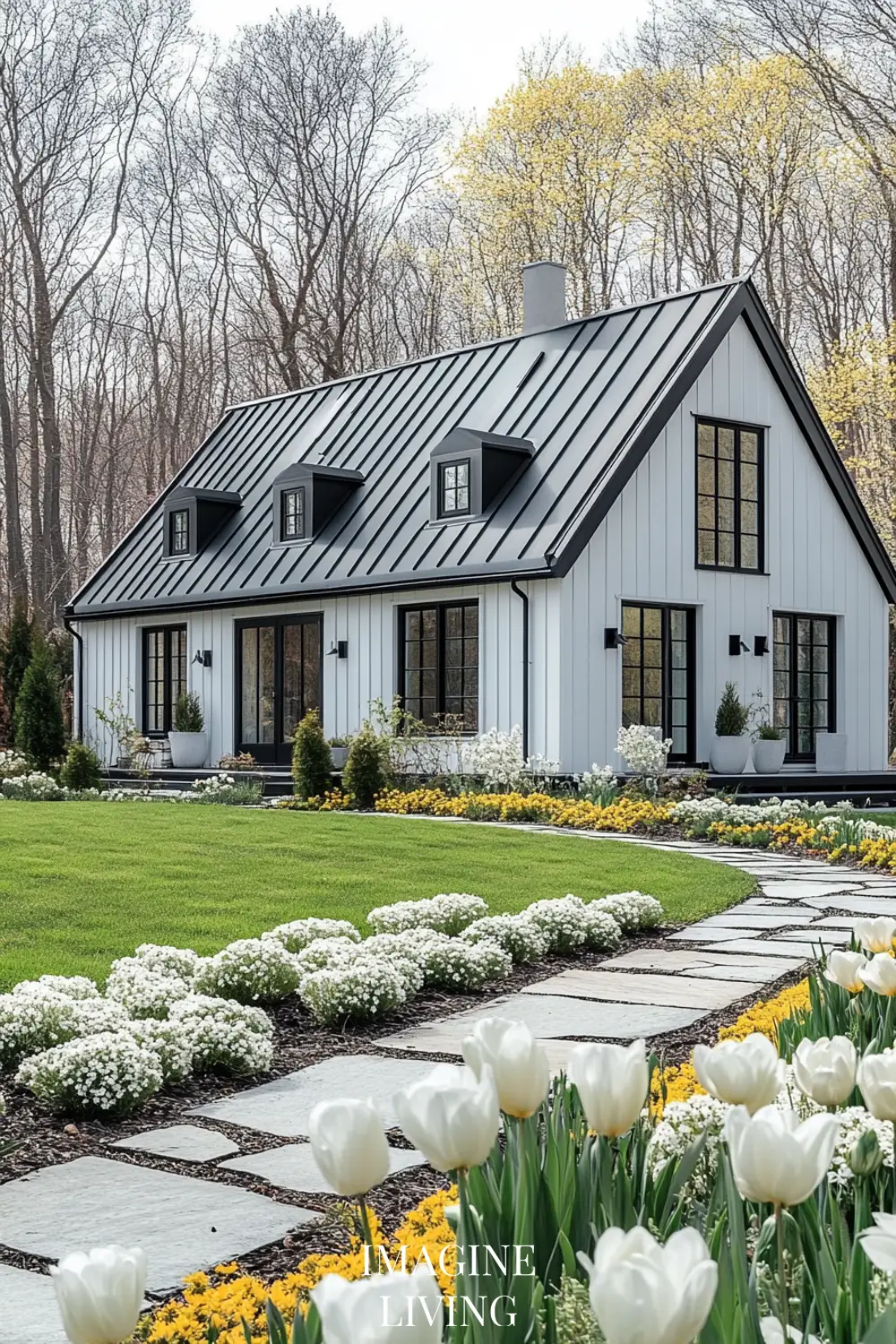
1. Choose a Crisp, Neutral Base for Your Exterior
The foundation of minimalist design starts with a neutral color palette. Think whitewashed wood, soft greys, or warm beige tones for the exterior walls. If your home has natural stone or brick, consider whitewashing it to soften the contrast while maintaining texture.
Best Exterior Colors for a Minimalist Spring Look:
- Pure White – A clean and bright base for a fresh spring aesthetic.
- Soft Gray – A subtle contrast that complements modern cottage design.
- Warm Greige – A balanced tone for a Scandinavian-inspired home.
Tip: If your cottage already has a darker exterior, soften the look by painting window trims and doors in off-white or light gray for a refreshing contrast.
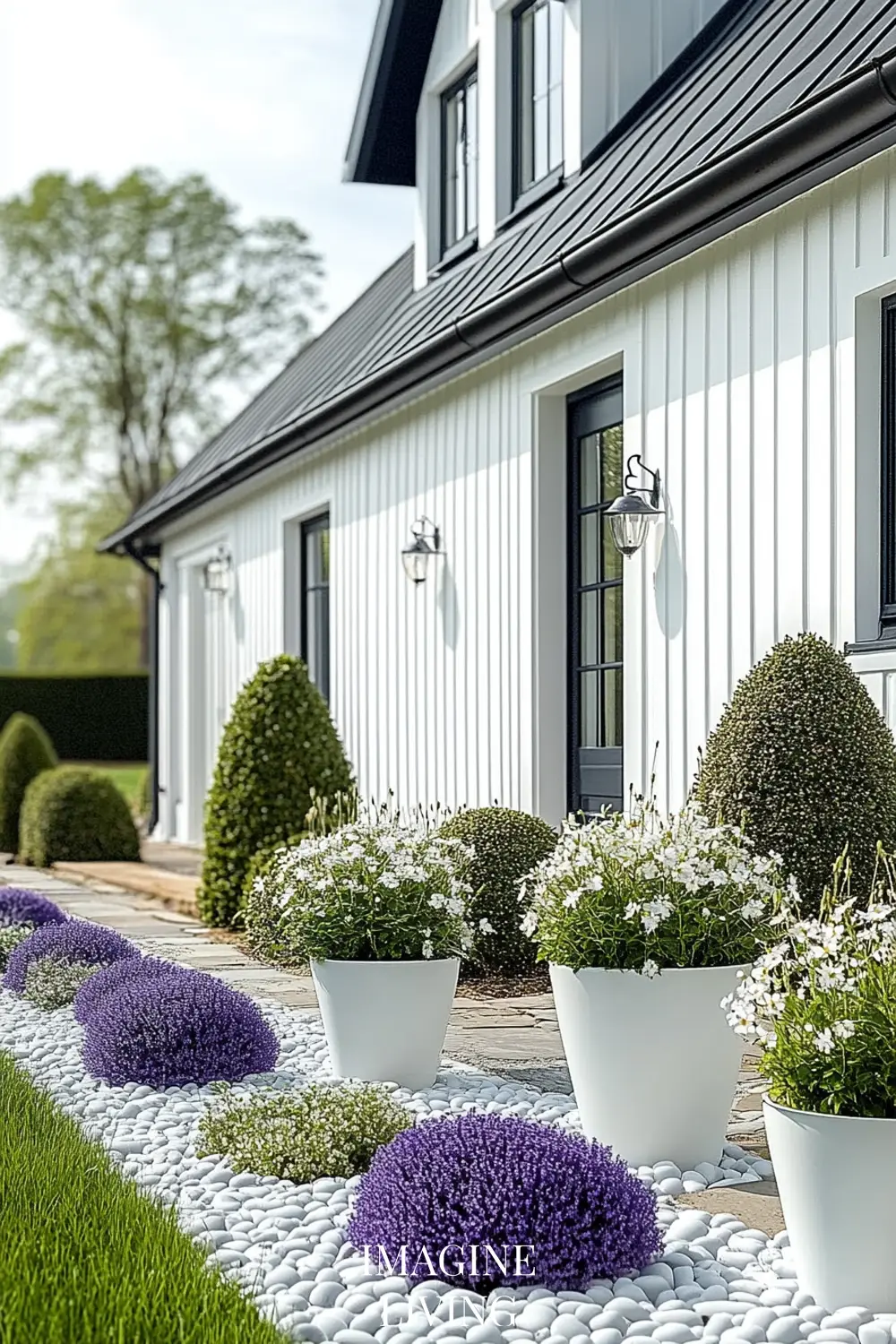
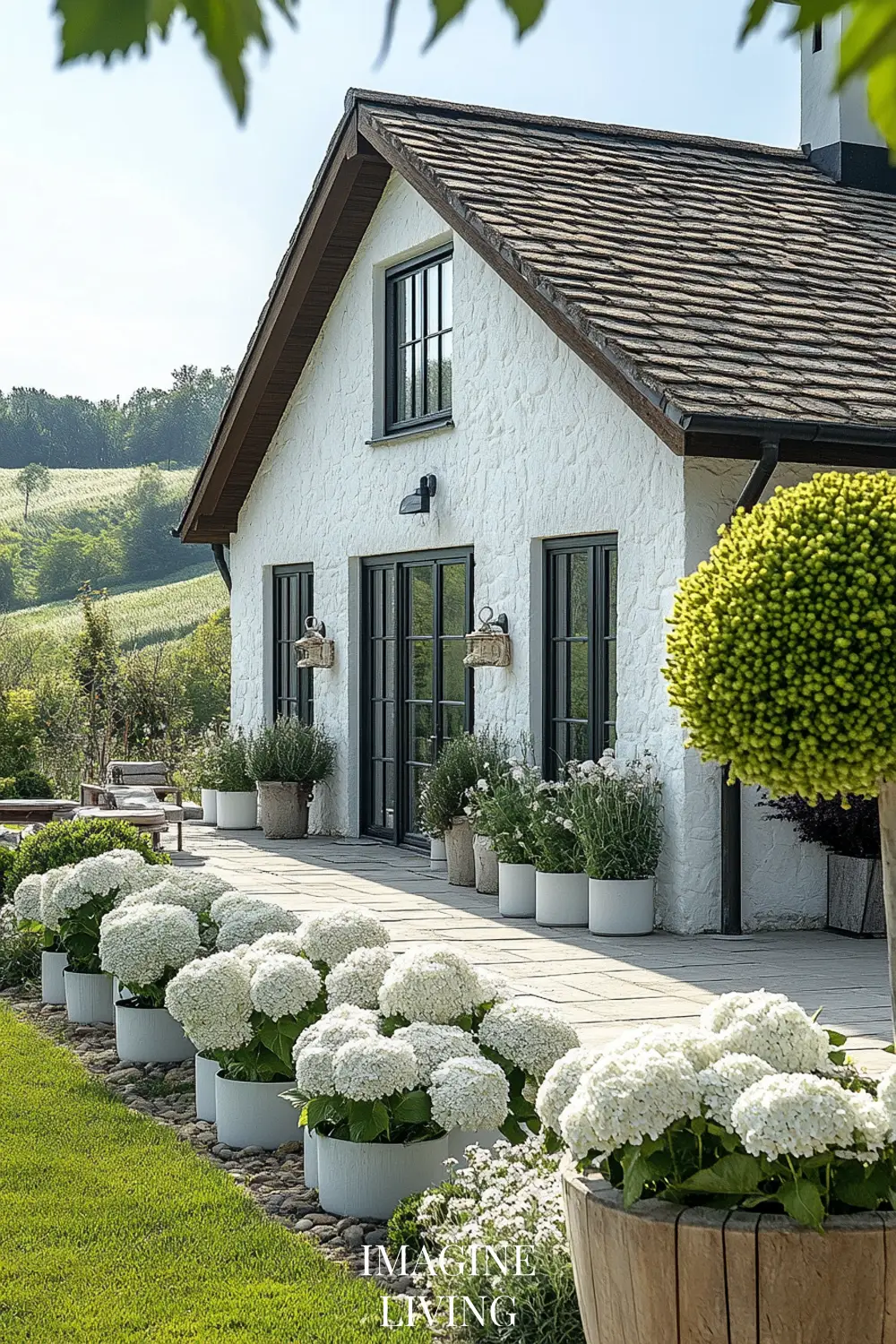
2. Keep Landscaping Intentional and Understated
Minimalist cottage gardens are structured yet organic, meaning every plant and pathway has a purpose. Instead of dense, overgrown flower beds, opt for low-maintenance greenery and a few focal floral arrangements.
Best Plants for a Minimalist Cottage Garden:
- Boxwood shrubs – Provide clean, structured greenery without overwhelming the space.
- Lavender – Adds a soft, delicate touch with muted purple tones.
- Climbing Roses (White or Blush Pink) – Adds romance while keeping the color scheme subtle.
- Ornamental Grasses – Creates movement while maintaining an effortless, natural look.
Pro Tip: Use symmetry in your landscaping by mirroring plants on either side of a pathway or entrance. This keeps the look clean and refined rather than overgrown.
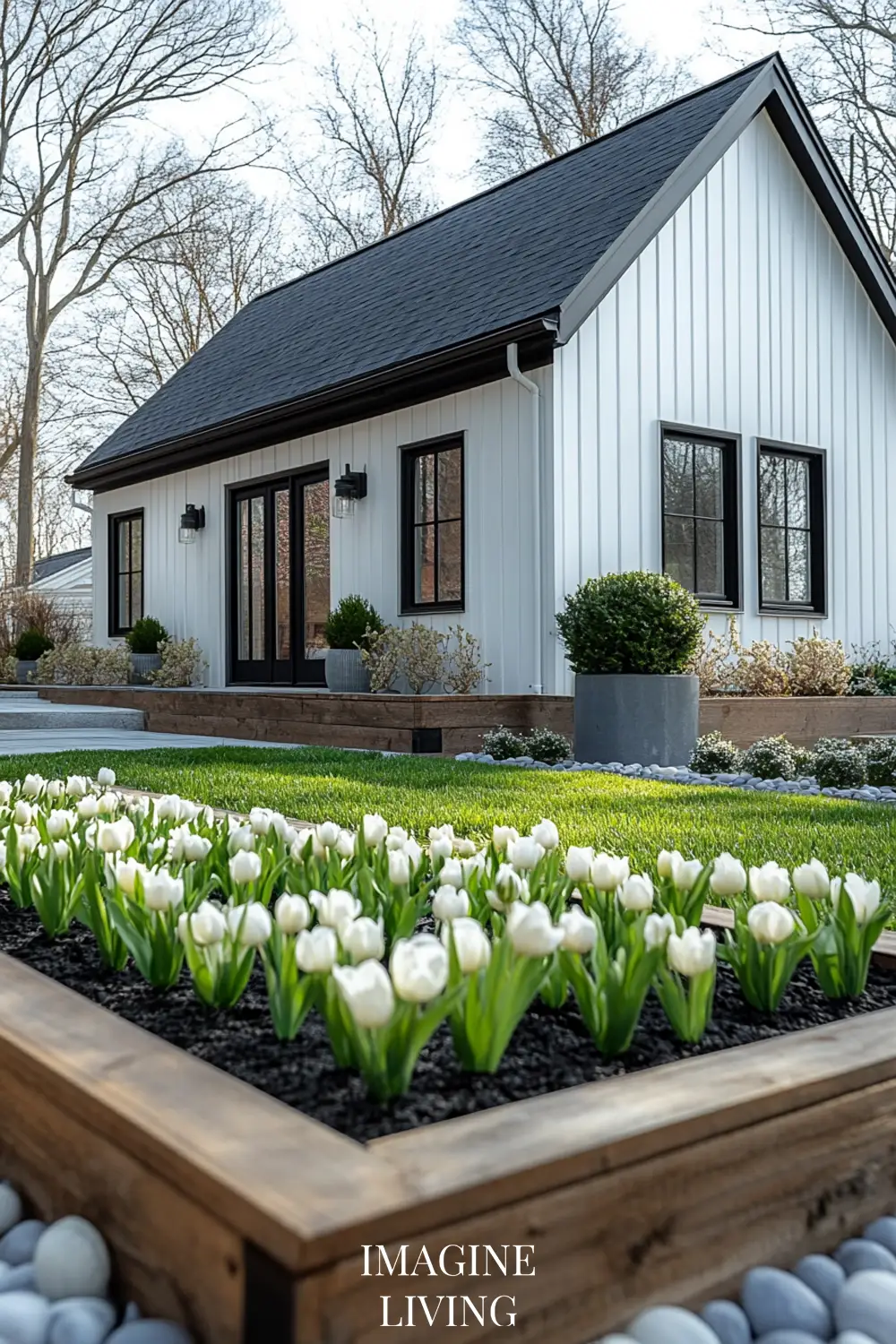
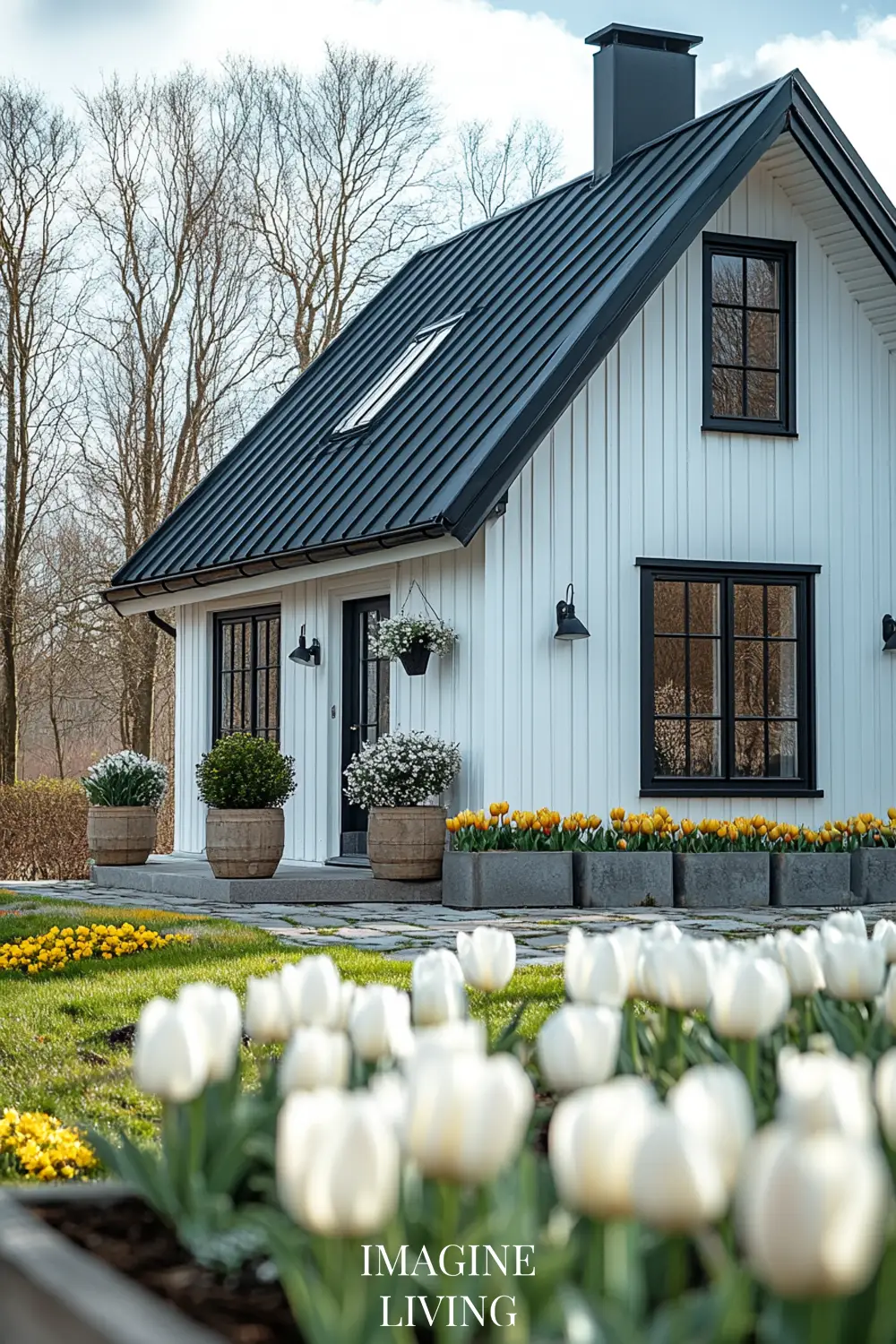
3. Incorporate Clean Architectural Lines
If you’re updating an older cottage or building new, consider simplified architecture that embraces Scandinavian or modern farmhouse aesthetics. Flat panel siding, vertical wood paneling, and sleek black-framed windows are perfect for achieving a fresh yet timeless look.
Minimalist Architectural Elements to Consider:
- Vertical board and batten siding for a classic yet streamlined effect.
- Black steel-framed or wooden windows to add definition.
- A simple front porch with wooden decking to frame the entrance.
- Hidden gutters and minimalist rooflines for a clutter-free finish.
Tip: If your home has too many ornate details, painting everything in one cohesive color (like white or taupe) can simplify the look instantly.

4. Style Your Porch with Thoughtful Simplicity
A minimalist spring cottage should have an outdoor space that feels inviting but not overdone. Instead of overcrowding your porch with furniture, keep it functional and curated.
Porch Styling for a Minimalist Look:
- A single wooden or rattan bench with linen cushions.
- One or two large planters with structured greenery or seasonal florals.
- A neutral outdoor rug to ground the space.
- Wall-mounted lighting that blends seamlessly with the house’s design.
Optional: If your style leans toward modern cottage luxury, add a soft linen canopy or pergola to frame the space.
Tip: Layer textures instead of colors—woven baskets, ceramic planters, and linen fabrics create visual interest without cluttering the aesthetic.
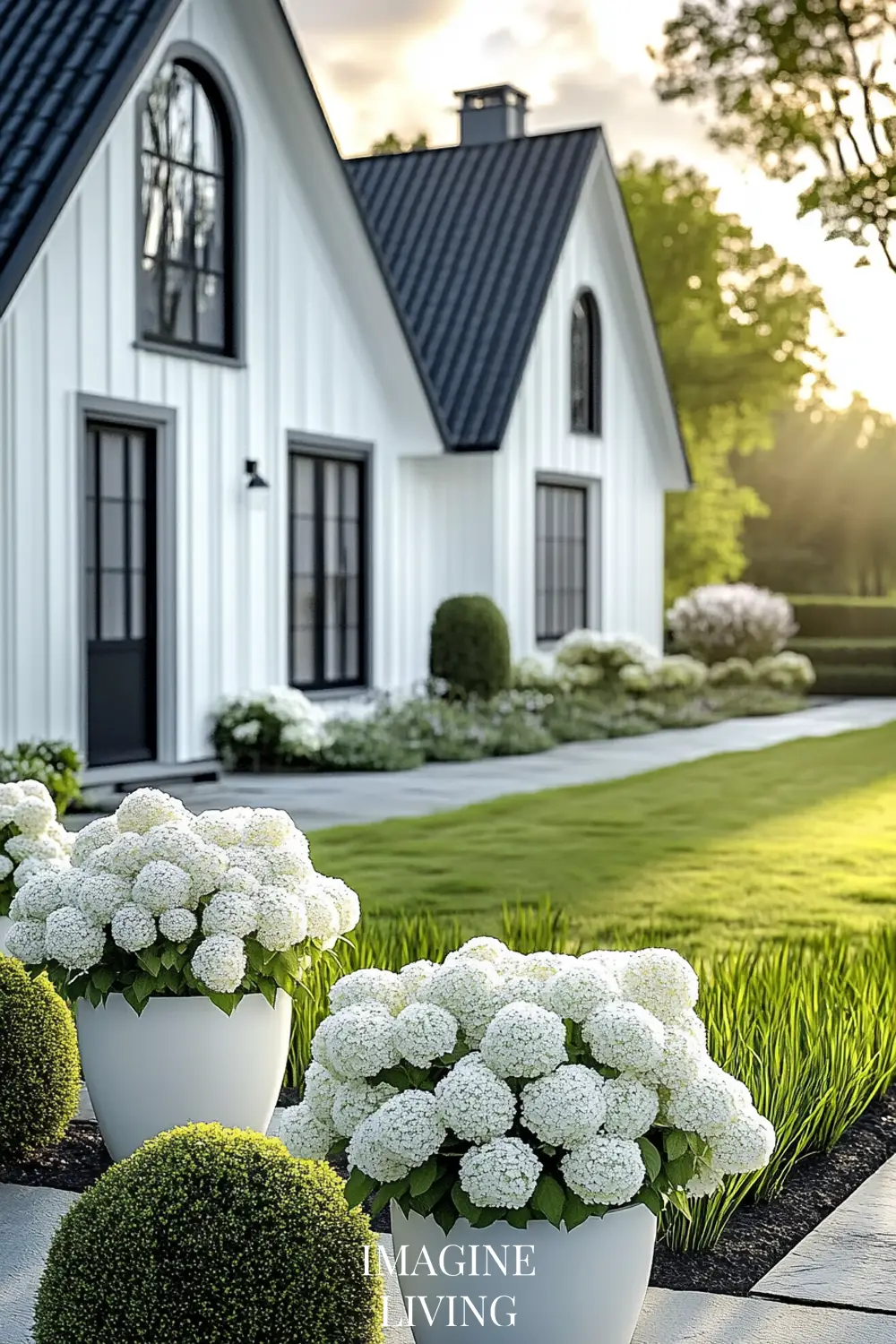
5. Use a Subtle, Nature-Inspired Color Palette
Minimalist spring cottages lean on neutral tones but embrace muted earthy accents to add depth. Instead of bright pastels, opt for desaturated hues inspired by natural materials.
Perfect Color Palette for a Minimalist Spring Cottage:
- Exterior: Soft white, warm taupe, pale gray
- Accent Colors: Black window frames, muted sage green, soft charcoal
- Natural Touches: Light oak wood, off-white linen, hand-thrown ceramics
Tip: If your exterior feels too stark, introduce a soft blue-gray door for a coastal-inspired Scandinavian look.
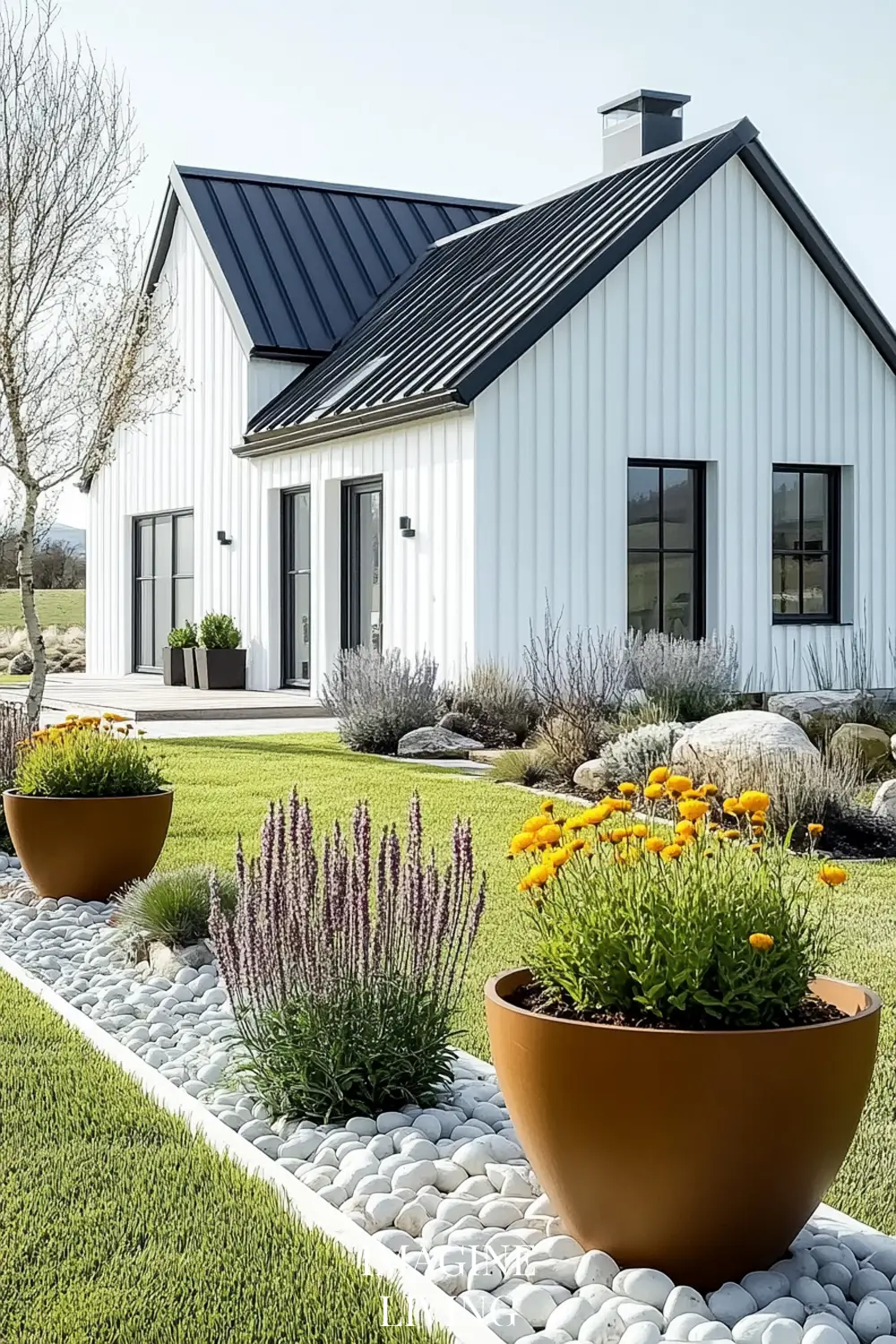
Color Palette & Styling Tips for a Minimalist Spring Cottage
A minimalist cottage exterior doesn’t mean bare or cold—it means every element is intentional. The key is layering natural materials while keeping the overall look clean and balanced.
1. Natural Wood Elements
Introducing natural oak, cedar, or light pine adds warmth to a predominantly white exterior.
Where to Use It:
- Porch beams or overhangs
- Front door accents
- Window trim in a soft wood tone
- Outdoor furniture

2. Subtle Seasonal Floral Touches
Minimalist cottages can still embrace florals—just in a refined and effortless way. Instead of densely packed flower beds, use single statement planters.
Best Spring Flowers for a Minimalist Cottage:
- White or blush peonies in terracotta pots
- Soft blue or white hydrangeas for a cottage feel
- Climbing clematis or wisteria to add height
Best Color Pairings:
- White cottage + yellow and white flowers (tulips, daffodils, and delicate wildflowers) for a fresh, inviting spring look.
- Soft taupe siding + sage green potted plants for a calm, earthy elegance.
- Warm gray exterior + lavender and blue hydrangeas to create a soft, romantic contrast.
- White cottage + soft butter yellow blooms (daffodils, pale yellow roses, or peonies) for a gentle warmth that feels sunlit and airy.
- Black-roofed white home + structured green hedges and white flowering trees for a clean, Nordic-inspired aesthetic.
Tip: Use ceramic or terracotta pots instead of plastic planters to maintain the organic, minimalist aesthetic.
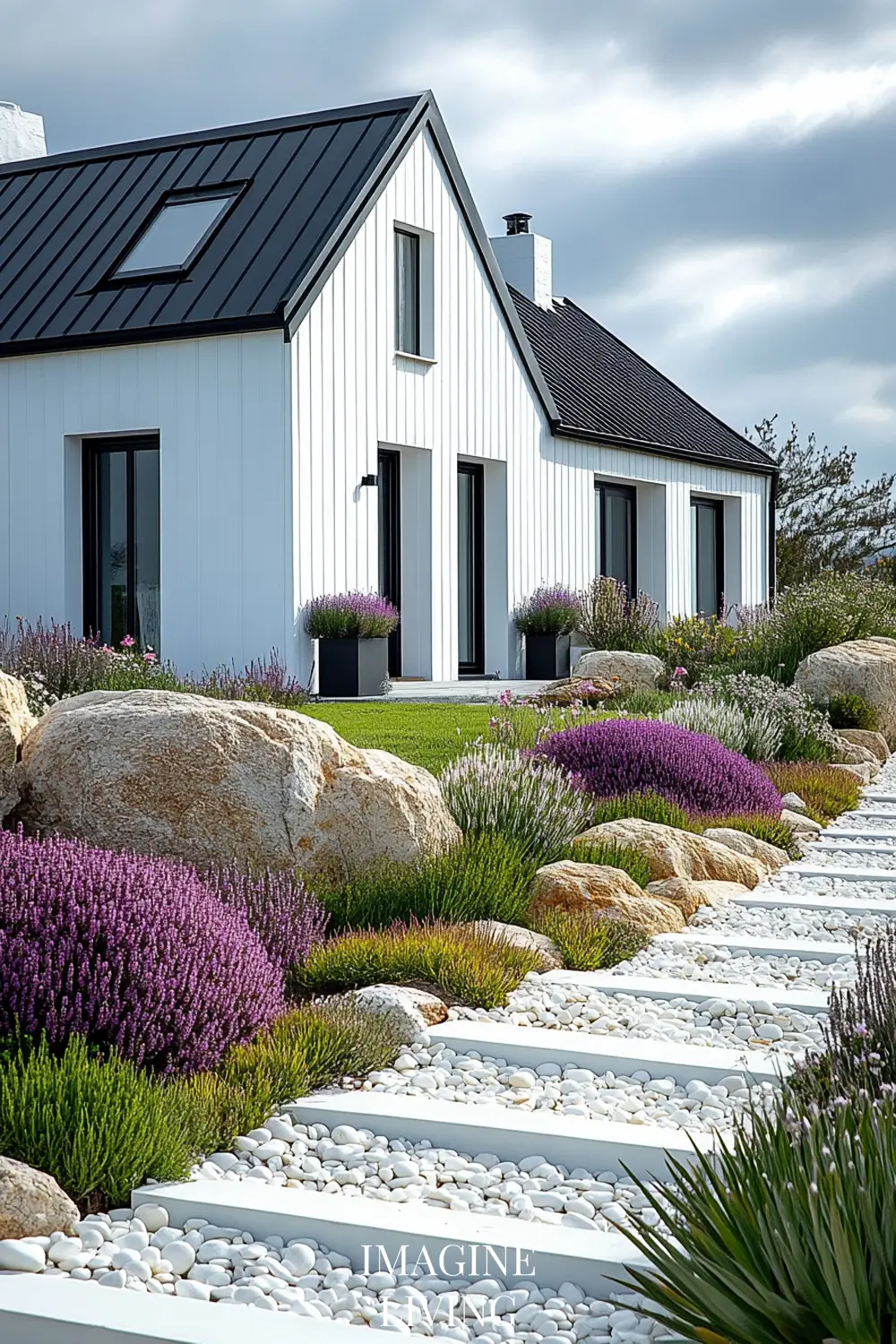
3. Textural Contrast with Stone & Woven Materials
To avoid a sterile look, mix in earthy textures like light stone, weathered wood, and linen textiles.
Ways to Incorporate Texture:
- A single stone pathway leading to the porch
- A woven basket planter instead of traditional pots
- A linen or cotton throw draped over a porch bench
Tip: If your home already has stone accents, keep it in a natural color palette—whites, greys, and warm beige stones pair best with a minimalist look.
Final Styling Takeaways
A minimalist spring cottage is all about balance—combining clean architectural lines, soft neutrals, and natural textures. The key is intentional simplicity.
Do:
✔ Keep your color palette neutral with desaturated greens or blush pinks.
✔ Opt for structured landscaping with selective flowers rather than wild, untamed gardens.
✔ Use natural materials like stone, wood, and linen for added warmth.
✔ Keep porch styling clean and functional, using one or two statement pieces.
Don’t:
✖ Overcrowd the exterior with too many decorative elements—keep it airy.
✖ Mix too many contrasting colors—stick to one or two accent shades.
✖ Overdo florals—minimalist gardens are curated, not chaotic.
By following these principles, you’ll create a timeless, serene, and welcoming minimalist cottage exterior, perfectly styled for spring.
Common Mistakes to Avoid When Styling a Minimalist Spring Cottage Exterior
Achieving a minimalist spring cottage exterior is all about refinement and restraint. While the concept seems simple, it’s easy to drift away from the clean, effortless look by adding too many elements or choosing the wrong materials. Here’s what to avoid when styling your space:
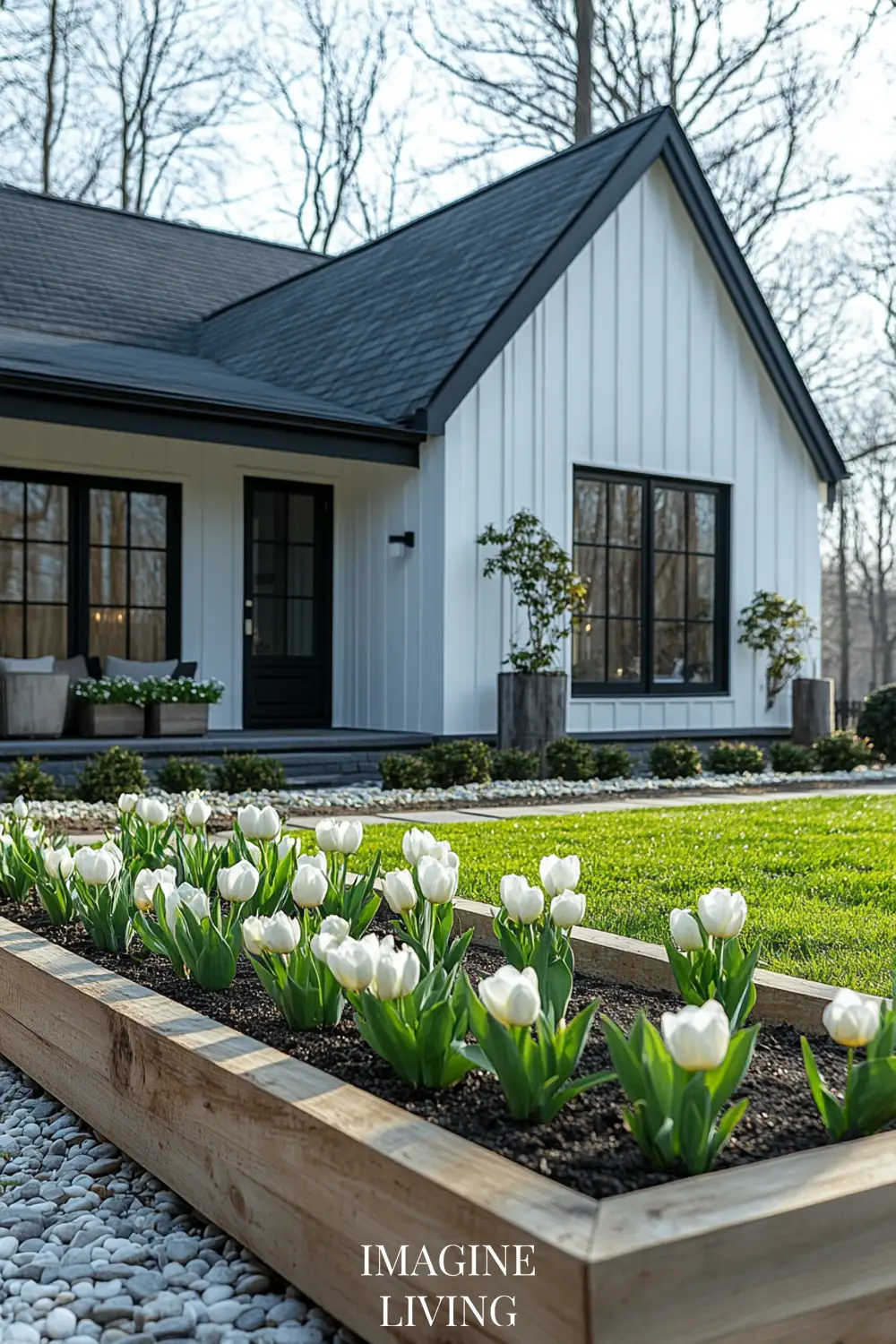
1. Overcrowding the Entryway with Too Many Accessories
Minimalism thrives on intentionality, so an entryway filled with excessive planters, layered rugs, and oversized décor can quickly make the space feel cluttered rather than serene.
Mistake:
- Adding multiple doormats, stacked planters, and seasonal wreaths that compete for attention.
- Using bright-colored flower pots or decor that contrast too much with a neutral house exterior.
Tip:
- Stick to one statement planter, a simple doormat, and a clean-lined porch bench or chair.
- Choose muted, natural colors for entryway décor to keep the look cohesive.
2. Choosing High-Maintenance Plants That Overgrow Quickly
A well-balanced minimalist spring exterior should feel structured yet natural, but certain fast-growing plants can quickly take over the space and ruin the clean aesthetic.
Mistake:
- Planting wildflowers, creeping vines, or dense bushes that grow uncontrollably.
- Using plants with overly bold colors that clash with the house’s minimalist color palette.
Tip:
- Opt for low-maintenance shrubs or plants that keep their shape, such as lavender, hydrangeas, or boxwood.
- If using flowers, stick to one or two key colors that complement the home’s tones.
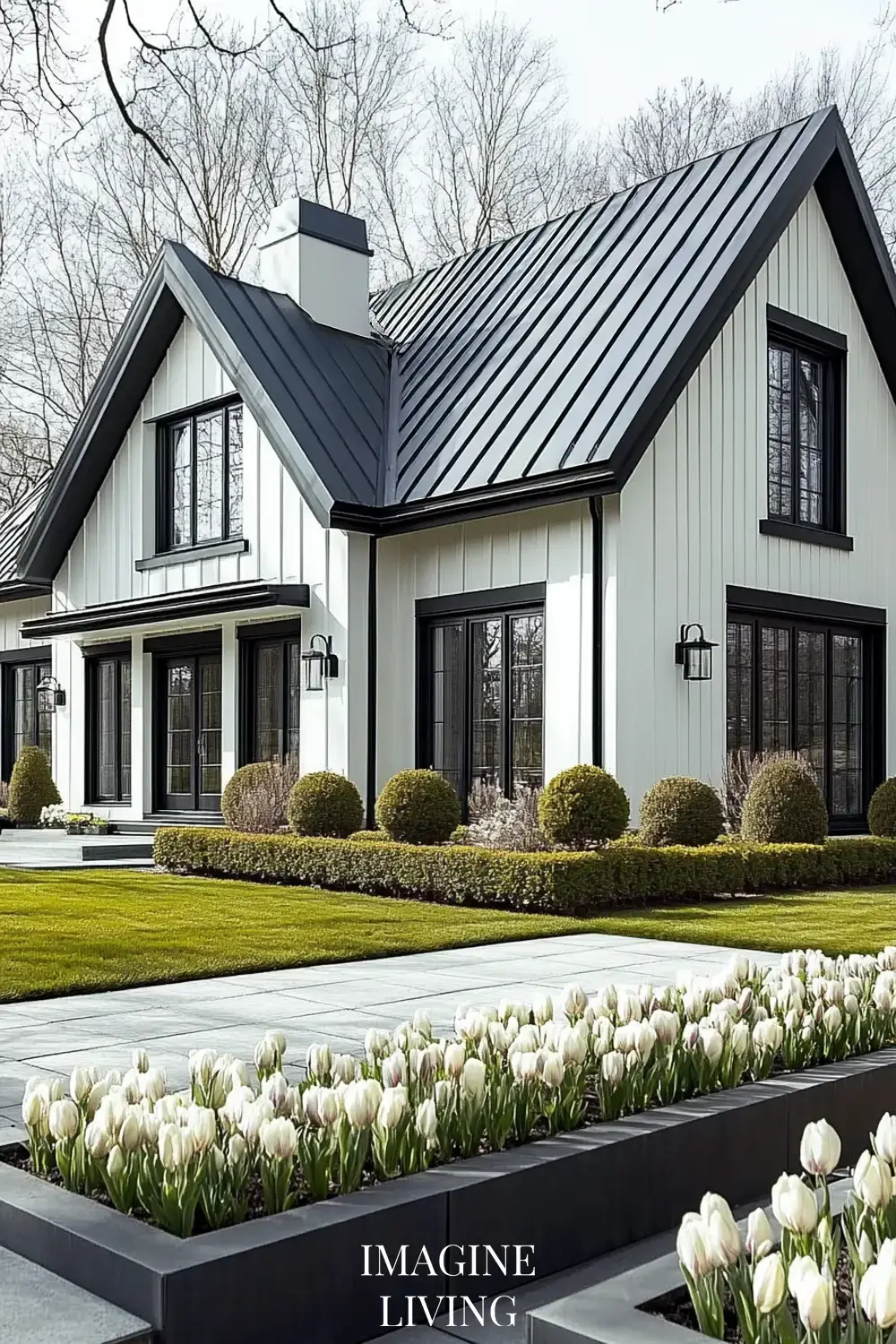
3. Ignoring the Balance Between Hardscaping and Greenery
Minimalist exteriors should feel harmonious, with a mix of structured elements and organic textures. Too much greenery without any structured hardscaping can look unkempt, while too much hardscaping can make the home feel cold and uninviting.
Mistake:
- Overloading the garden with plants without defining pathways or structured borders.
- Using excessive stone, gravel, or concrete with no soft, natural elements to balance it.
Tip:
- Combine stone or gravel pathways with soft landscaping—a few structured flower beds or carefully placed potted plants can make a difference.
- Keep garden pathways simple and let key greenery stand out rather than compete.
4. Choosing the Wrong Lighting Temperature
Lighting can make or break the atmosphere of a minimalist cottage exterior. The goal is to create a warm, inviting glow that enhances the textures and architecture of the home.
Mistake:
- Using harsh, bright white LED lights that create a sterile and artificial look.
- Installing overly decorative or oversized fixtures that don’t blend with the minimalist aesthetic.
Tip:
- Choose warm, ambient outdoor lighting in a soft white or warm golden hue.
- Keep lighting fixtures simple, wall-mounted, and subtle, such as black iron sconces or neutral-toned lanterns.
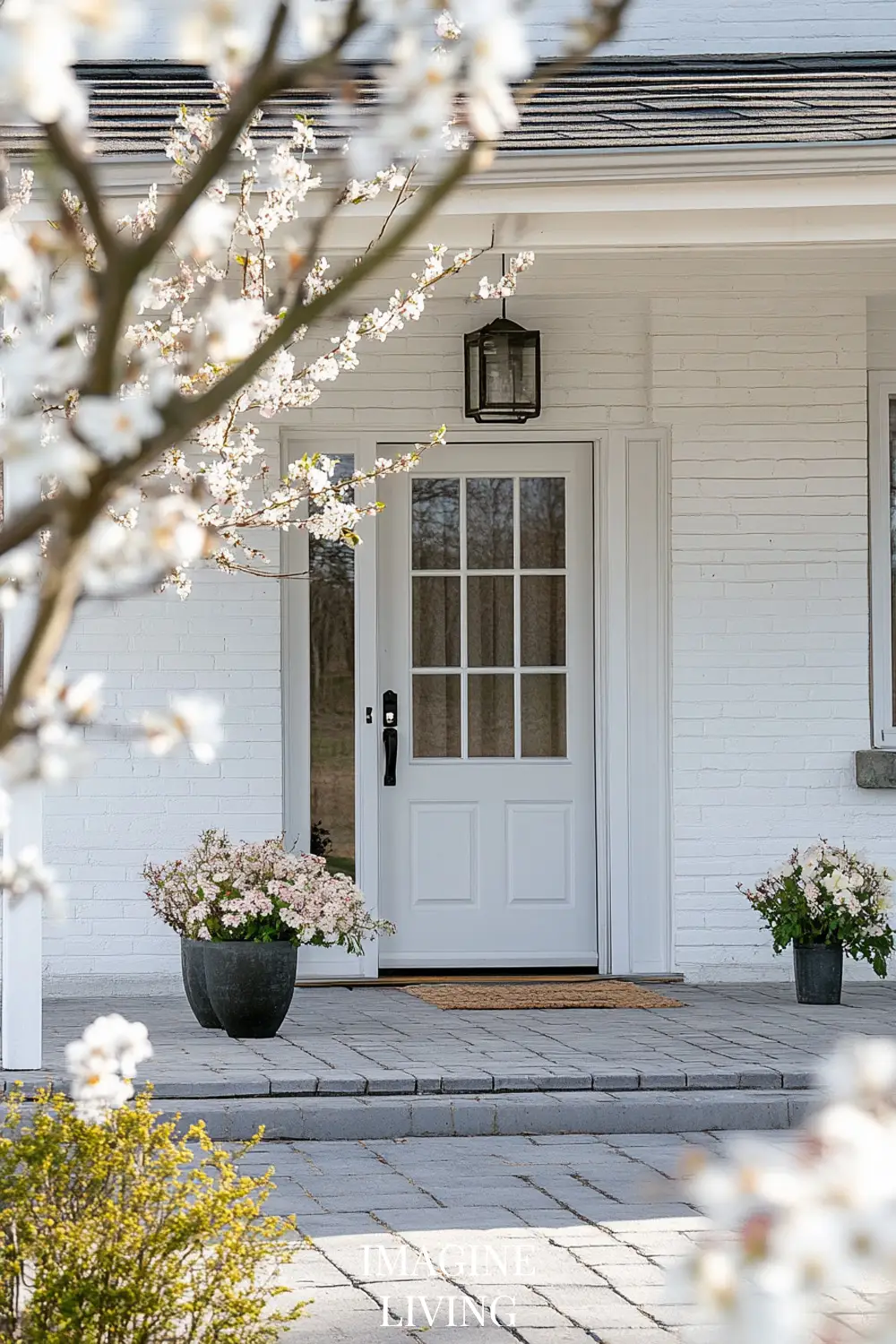
5. Mixing Too Many Exterior Textures or Colors
A minimalist spring cottage should have a cohesive look, but using too many different textures or materials can create visual chaos.
Mistake:
- Combining too many exterior materials (e.g., mixing brick, stone, wood, and metal all in one space).
- Painting the exterior in contrasting colors that don’t blend smoothly.
Tip:
- Stick to a maximum of two or three exterior materials for balance.
- Choose a neutral primary color, then add one subtle accent color for contrast.
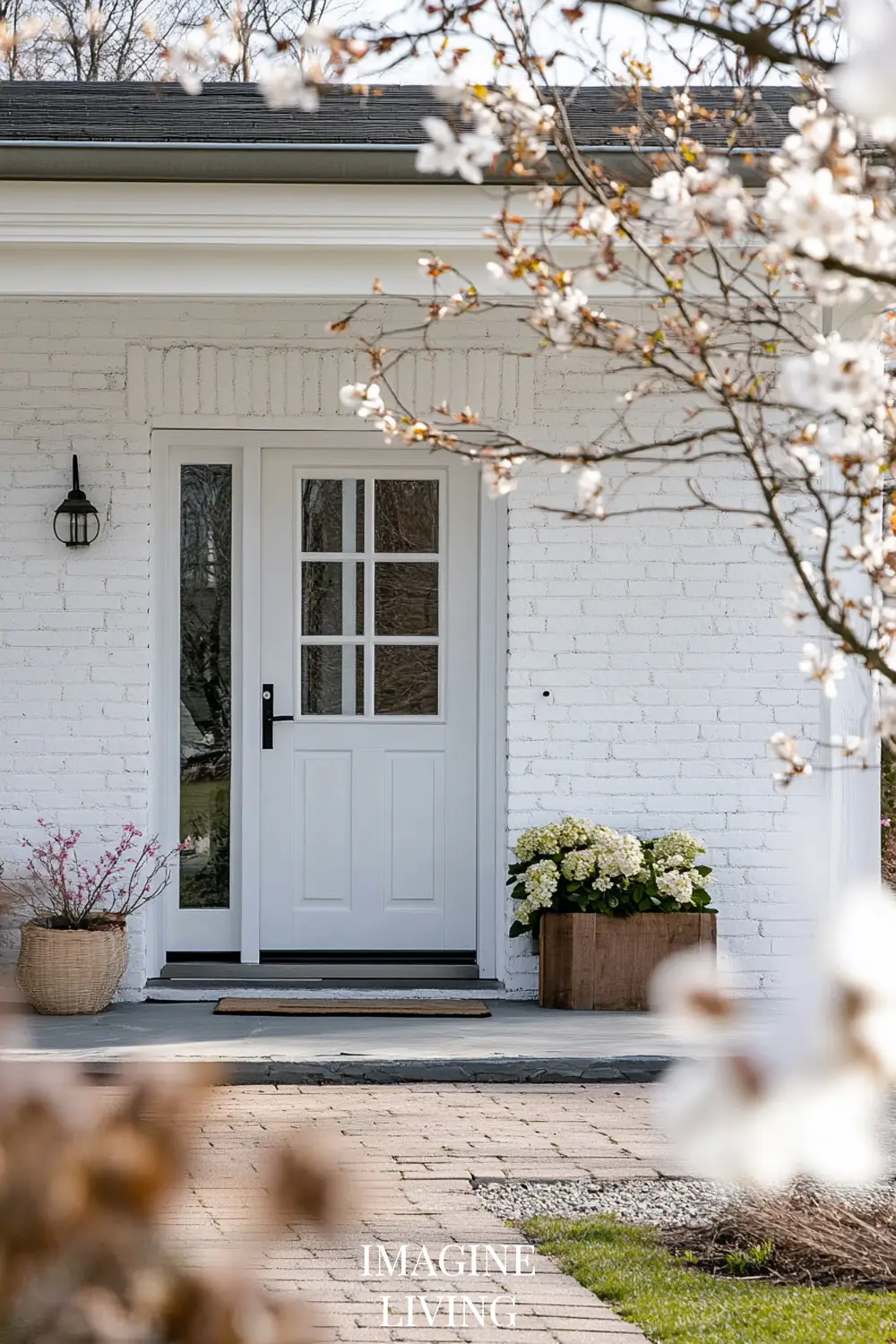
6. Overstyling the Porch or Outdoor Furniture Area
Minimalism is all about thoughtful restraint, but it’s easy to fall into the trap of overdecorating outdoor furniture spaces, especially with seasonal elements.
Mistake:
- Placing too many cushions, lanterns, and decorative objects on outdoor seating.
- Using furniture that doesn’t match the home’s aesthetic (e.g., heavy traditional wood pieces with a modern minimalist exterior).
Tip:
- Keep outdoor furniture light, natural, and simple—think woven textures, soft neutral cushions, and clean-lined tables.
- If adding decor, choose one focal piece, like a linen throw or a single ceramic vase with greenery.
7. Forgetting About the Roof and Window Frames
Often overlooked, roofing and window details can make a big difference in creating a clean, minimalist exterior.
Mistake:
- Keeping an outdated, worn roof or old window trims that clash with the refreshed minimalist aesthetic.
- Choosing window frames that are too ornate or detailed, disrupting the clean lines of the home.
Tip:
- If possible, refresh the roof with a dark, sleek finish like black or charcoal to frame the home elegantly.
- Consider painting window trims in black or soft gray to create contrast while keeping the look sharp.
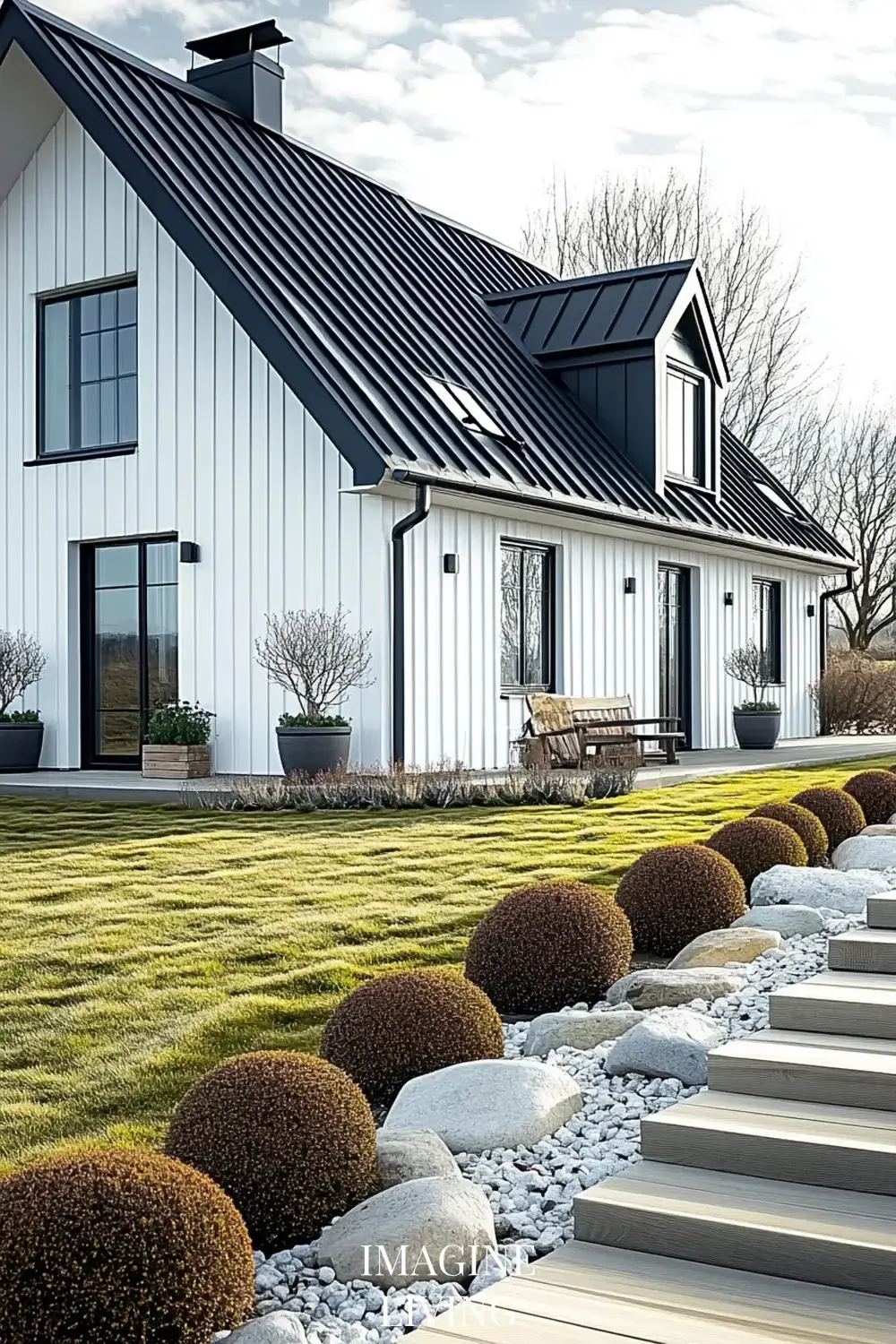
8. Adding Too Many Seasonal Decorations
While it’s tempting to bring seasonal charm to a spring cottage, too many decorations can make the home feel overstyled and cluttered.
Mistake:
- Overloading the front entrance with banners, multiple wreaths, decorative baskets, and holiday-themed accents.
- Changing exterior decor too frequently, making it feel inconsistent.
Tip:
- Keep seasonal decor subtle and refined—a simple spring wreath, a neutral floral arrangement, or a light linen bench cushion is enough.
- Choose timeless decor pieces that transition effortlessly across seasons.
9. Leaving the Exterior Too Stark or Bare
While minimalism is about simplicity, a completely empty exterior can feel unfinished or cold.
Mistake:
- Avoiding all decorative touches and greenery, making the home look uninviting.
- Keeping large, blank walls or empty porches with no visual balance.
Tip:
- Balance simplicity with warmth—even a single flowering tree, a structured planter, or a wooden bench can create a cozy, finished look.
- If the space feels too empty, add subtle texture through a stone pathway, a neutral outdoor rug, or woven seating.
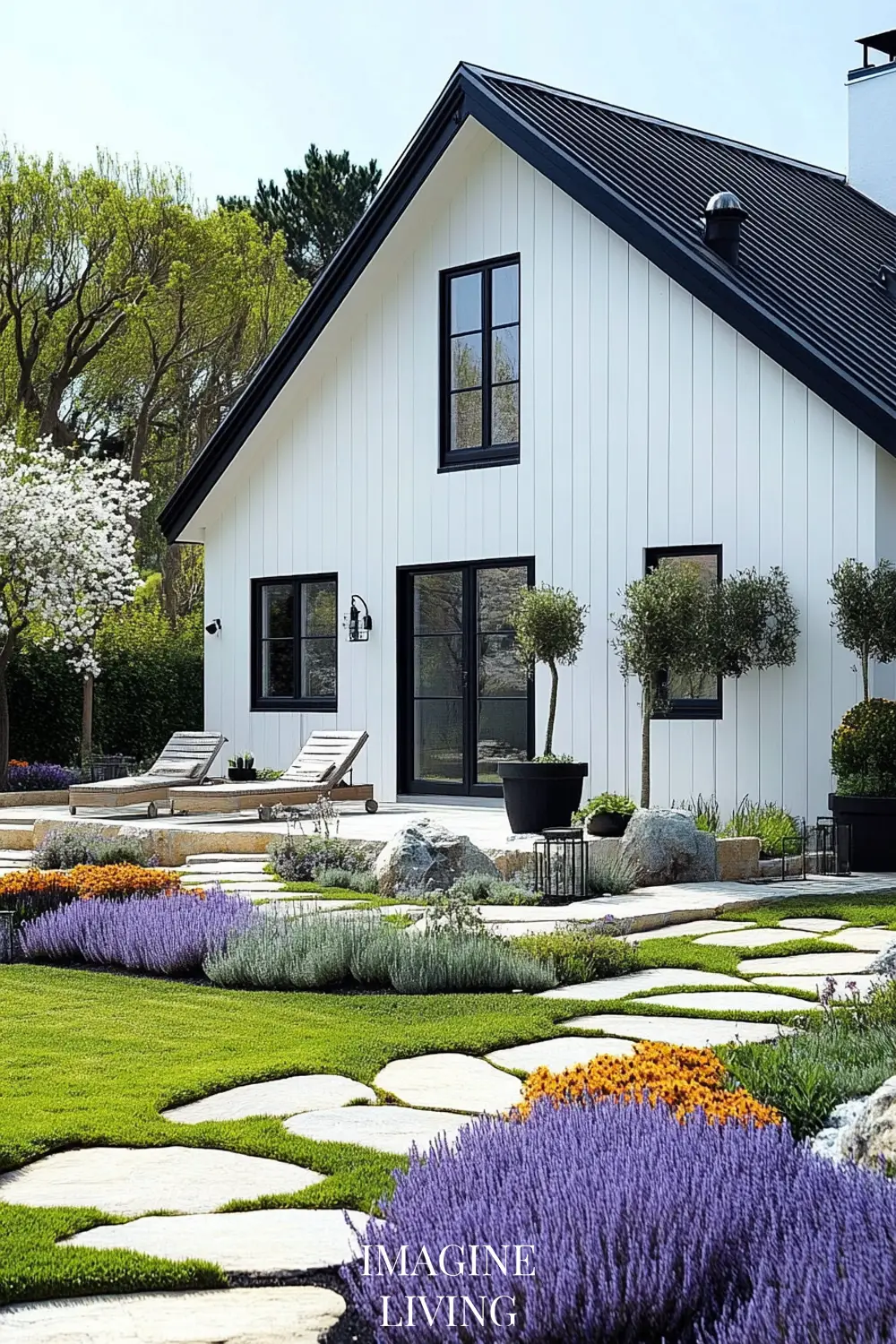
FAQs
How do I make my minimalist cottage still feel cozy?
Layer in warm wood tones, soft lighting, and greenery to keep it inviting.
Can I add color and still keep it minimalist?
Yes! Soft pastels like blush, sage, or muted blue work beautifully as subtle accents.
What’s the easiest way to refresh my cottage exterior for spring?
A fresh coat of soft white paint, potted plants, and a clean, simple seating area will instantly refresh the space.

Conclusion
Minimalist spring cottage exteriors are all about intentional beauty, balance, and serenity. With clean lines, soft colors, and thoughtfully chosen greenery, you can create an outdoor space that feels both timeless and welcoming—perfect for embracing the gentle renewal of spring.
What’s your favorite way to style a minimalist cottage for spring? Let us know in the comments!


